Patch News – October 2024
It’s November already, the clocks have gone back and winter is well on the way. So how was October? Better than expected overall, we had several nice sunny days with light winds. Life at the patch continued as usual, we managed a fair bit of flying on the better days, often cutting the grass beforehand, making flying a reward for our hard work. As the weather is now turning colder mowing will hopefully be a rarity for a few months.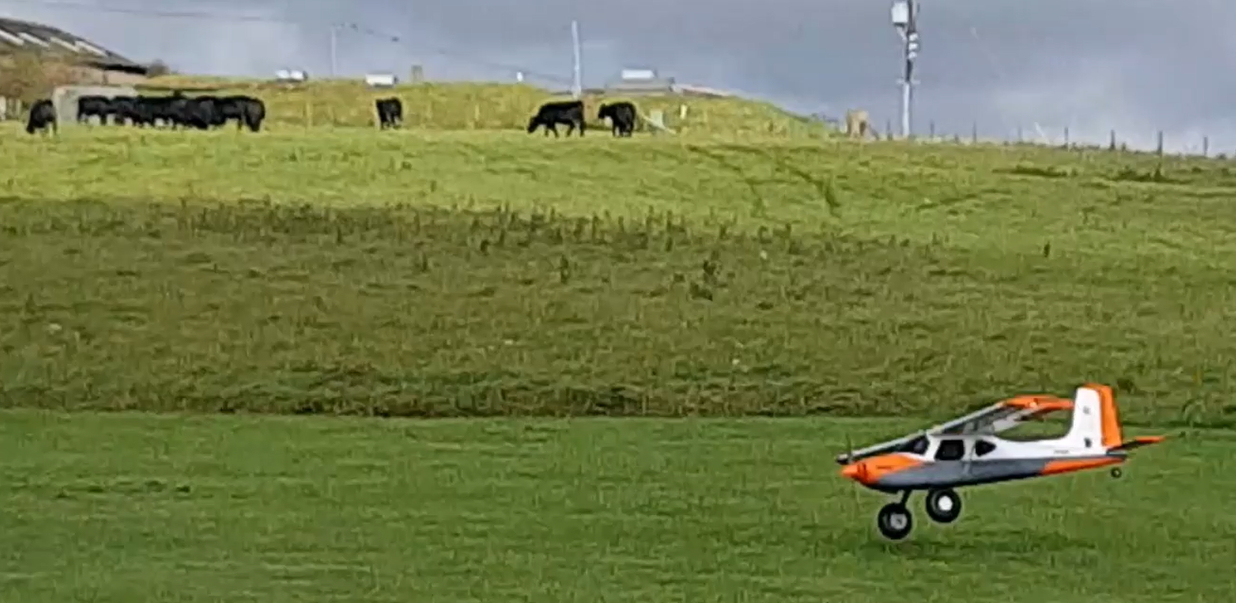 A herd of bullocks joined us for a while but were rarely a problem, once they realised we weren’t there to feed them they just wandered off and left us alone. Later in the month the bullocks went and were quickly replaced by a flock of sheep. Sheep never seem to be any bother other than the ‘presents’ they leave us! The last Sunday morning of October was a glorious, calm and sunny day so we took the opportunity to mow. As we finished mowing, right on cue, in the nick of too late, newbie Patrick turned up to fly. Patrick is fitting in well with the club and it’s about time he had a blog nickname so I’m wondering if being called Patrick Mower would nudge him into action. Of course that might make him think we see him as an 80’s TV star so maybe Patrick Non-Mower would be more appropriate!
A herd of bullocks joined us for a while but were rarely a problem, once they realised we weren’t there to feed them they just wandered off and left us alone. Later in the month the bullocks went and were quickly replaced by a flock of sheep. Sheep never seem to be any bother other than the ‘presents’ they leave us! The last Sunday morning of October was a glorious, calm and sunny day so we took the opportunity to mow. As we finished mowing, right on cue, in the nick of too late, newbie Patrick turned up to fly. Patrick is fitting in well with the club and it’s about time he had a blog nickname so I’m wondering if being called Patrick Mower would nudge him into action. Of course that might make him think we see him as an 80’s TV star so maybe Patrick Non-Mower would be more appropriate!
 Terry also owns the larger Apprentice but I hear he damaged it while I was away for a few days. It’s almost ready to fly again now but Terry is awaiting delivery of a new wing spar.
Terry also owns the larger Apprentice but I hear he damaged it while I was away for a few days. It’s almost ready to fly again now but Terry is awaiting delivery of a new wing spar. 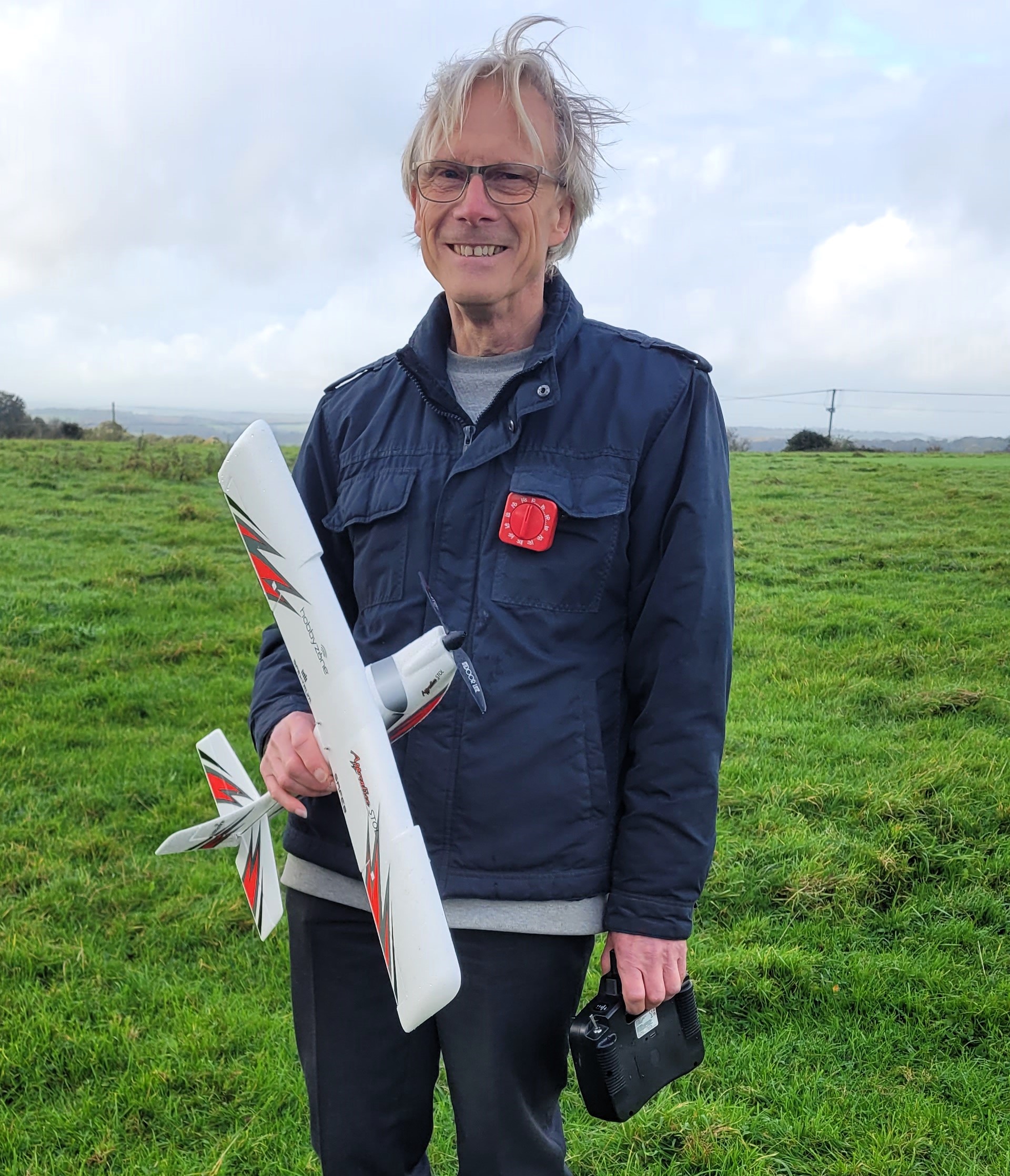 Terry flies quite well with the smaller Apprentice and is using the gyro SAFE system in the Advanced mode as his skills improve. He was complaining that his simulator doesn’t mimic our long grass and windy conditions very well…welcome to the real-world Terry!
As well as the last Sunday of the month having perfect flying weather the morning was improved even further by Woody bringing along celebratory cakes for everybody!
Terry flies quite well with the smaller Apprentice and is using the gyro SAFE system in the Advanced mode as his skills improve. He was complaining that his simulator doesn’t mimic our long grass and windy conditions very well…welcome to the real-world Terry!
As well as the last Sunday of the month having perfect flying weather the morning was improved even further by Woody bringing along celebratory cakes for everybody! His birthday was actually on the Friday before but the weather was not flyable that day.
His birthday was actually on the Friday before but the weather was not flyable that day.
Early in October Gordon Bennett managed to break the fuselage of his Multiplex Extra 330SC in half when landing. Gordon blamed the small wheels and spats, saying they stopped the Extra moving forward on the wet grass, and instead it nosed over and broke the fuselage at the back of the wing when the fin hit the ground. His solution was to remove the spats and replaced the wheels with ones about a foot in diameter.
 That might be a slight exaggeration but the wheels are much larger than the originals and don’t exactly enhance the look of the Extra. I think I know where he found his inspiration!
That might be a slight exaggeration but the wheels are much larger than the originals and don’t exactly enhance the look of the Extra. I think I know where he found his inspiration! 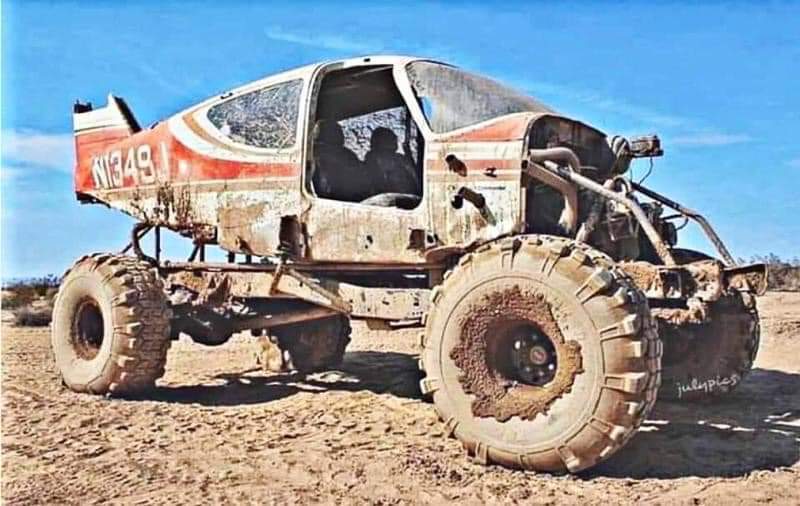 However, never mind what they look like, as you can see in this month’s video the bigger wheels do the job and Gordon has managed several flights without damaging anything.
However, never mind what they look like, as you can see in this month’s video the bigger wheels do the job and Gordon has managed several flights without damaging anything.
Last month I reported on the Multiplex Joker that Leo had bought at the Popham Model Show and subsequently sold on to Dougal Entendre. In October Dougal sorted out some of the things he wasn’t happy with on the plane and had a few flights at our field.
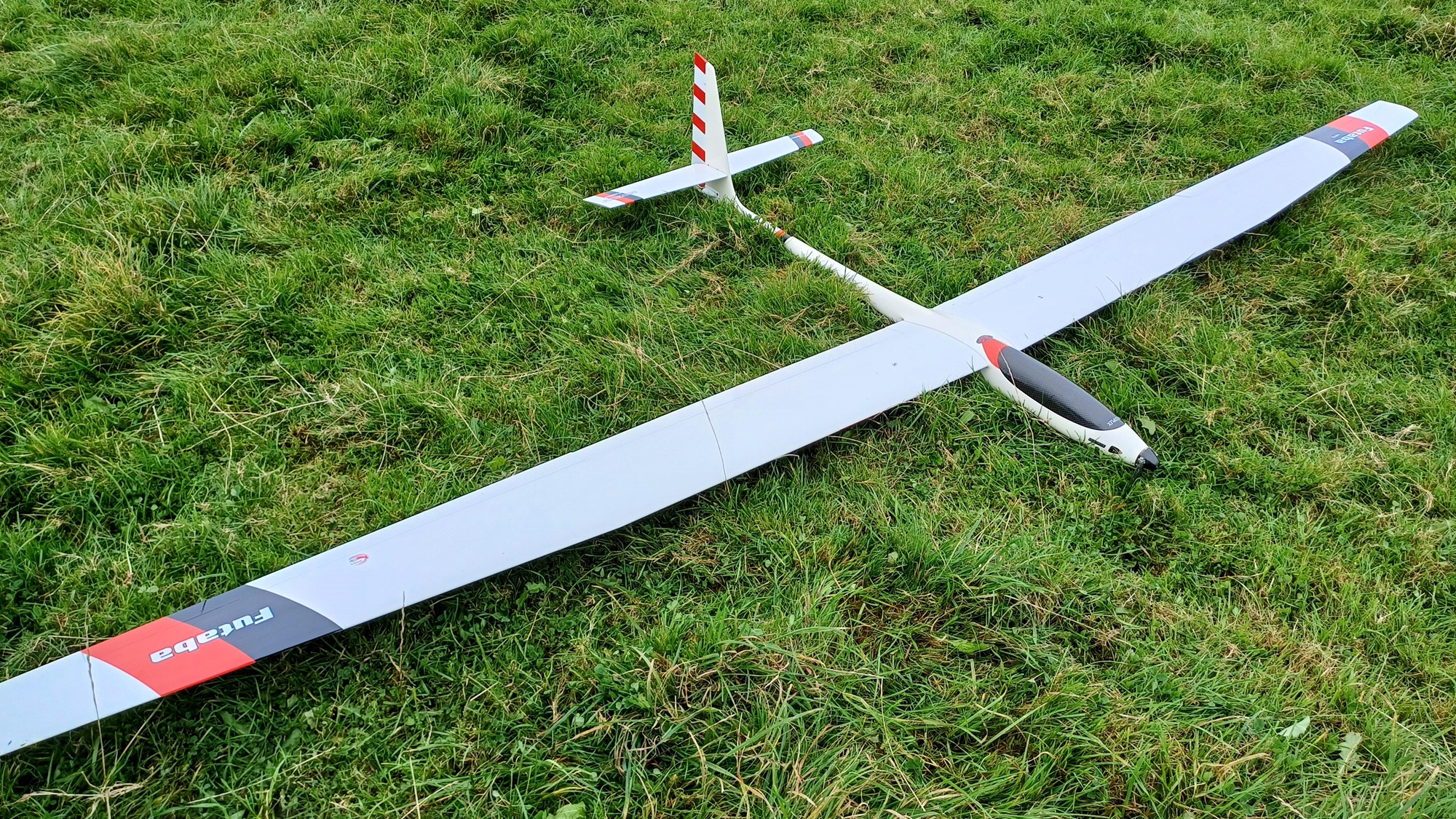 Here is Dougal’s report: Many years ago I designed a 12ft wingspan glider which I called Mr Blue Sky. I did a foam wing using obeche veneer attached with epoxy. The wings were heavy, which gave it an unfortunate characteristic of “digging in” when I tried to do slow thermal turns. This was probably due to tip-stalling, so I never had any success with it. Other designs with lighter built-up wings never seemed to suffer from this problem. When Leo purchased the Joker at Popham and we were heading back to the car with it, I worried that the wings seemed heavy, so it might suffer from a similar characteristic. Fortunately, when Leo had installed his gear and I got to test-fly it, it proved to be a fine performer with no nasty vices. I suspect the Joker performs so well due to its under-cambered section, straight wings (where Mr Blue Sky had polyhedral) and the really smooth epoxy covering job which the builder did. However, after the test flight, we still had to make a snagging list of things which were going to have to be sorted. It read as follows:
1. No ESC brake, so the folding propeller would not fold.
2. Flaps would only work like ailerons, i.e. one went up when the other went down!
3. Vibration at full throttle.
Here is Dougal’s report: Many years ago I designed a 12ft wingspan glider which I called Mr Blue Sky. I did a foam wing using obeche veneer attached with epoxy. The wings were heavy, which gave it an unfortunate characteristic of “digging in” when I tried to do slow thermal turns. This was probably due to tip-stalling, so I never had any success with it. Other designs with lighter built-up wings never seemed to suffer from this problem. When Leo purchased the Joker at Popham and we were heading back to the car with it, I worried that the wings seemed heavy, so it might suffer from a similar characteristic. Fortunately, when Leo had installed his gear and I got to test-fly it, it proved to be a fine performer with no nasty vices. I suspect the Joker performs so well due to its under-cambered section, straight wings (where Mr Blue Sky had polyhedral) and the really smooth epoxy covering job which the builder did. However, after the test flight, we still had to make a snagging list of things which were going to have to be sorted. It read as follows:
1. No ESC brake, so the folding propeller would not fold.
2. Flaps would only work like ailerons, i.e. one went up when the other went down!
3. Vibration at full throttle.
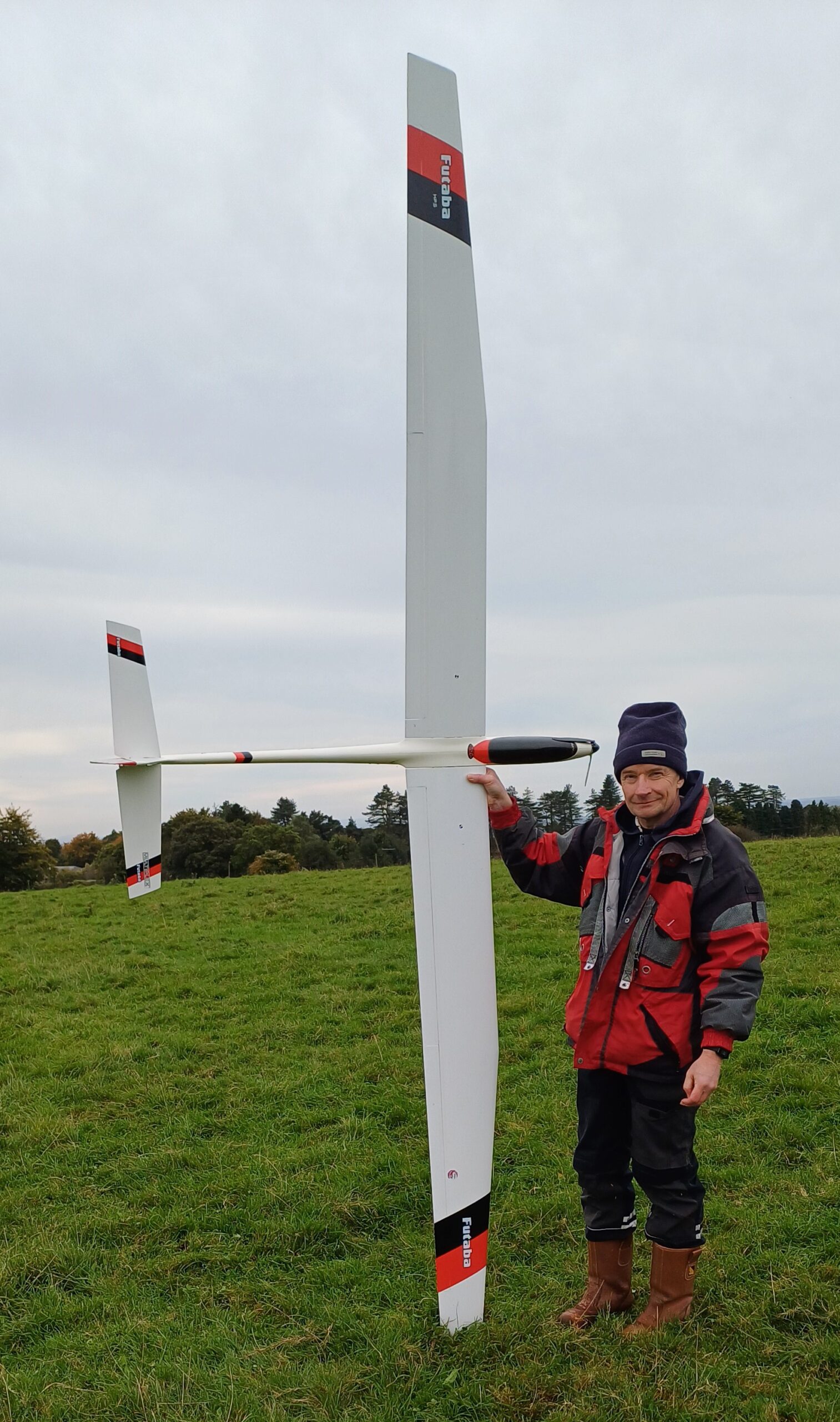 I bought the Joker off Leo, got it in the workshop and approached each problem in turn. It had an Arrows 50A ESC fitted (which I think is the same as used in the Marlin), so I downloaded the instructions and tried to engage the brake.
I bought the Joker off Leo, got it in the workshop and approached each problem in turn. It had an Arrows 50A ESC fitted (which I think is the same as used in the Marlin), so I downloaded the instructions and tried to engage the brake.
 This proved impossible – the ESC didn’t respond to programming using the throttle stick as it should, so I replaced it with a different ESC where I knew the brake worked. I suspect the Arrows unit doesn’t actually have a brake, even though the instructions suggest that it does! The flap problem was solved by removing the Y-lead which the original owner had put in the wiring harness, and driving each servo off a separate Rx channel, with suitable reversing. I did the same for the ailerons, removing the second Y-lead and using separate channels so I could program some differential (more up aileron than down). The propeller seemed to be well balanced, but using a 4s pack at full throttle gave a nasty vibration. Throttling back to about 75% gave no vibration at all, and the model still proved to have a good climb rate, so my temporary solution is to put a limit on the throttle when using 4s batteries. In the long term I may go down to 3s, but that will mean changing the ESC connector! In the meantime I’m using a 4s 3700mAh pack, and used less than 20% capacity for a 12-minute flight in fairly still air.
This proved impossible – the ESC didn’t respond to programming using the throttle stick as it should, so I replaced it with a different ESC where I knew the brake worked. I suspect the Arrows unit doesn’t actually have a brake, even though the instructions suggest that it does! The flap problem was solved by removing the Y-lead which the original owner had put in the wiring harness, and driving each servo off a separate Rx channel, with suitable reversing. I did the same for the ailerons, removing the second Y-lead and using separate channels so I could program some differential (more up aileron than down). The propeller seemed to be well balanced, but using a 4s pack at full throttle gave a nasty vibration. Throttling back to about 75% gave no vibration at all, and the model still proved to have a good climb rate, so my temporary solution is to put a limit on the throttle when using 4s batteries. In the long term I may go down to 3s, but that will mean changing the ESC connector! In the meantime I’m using a 4s 3700mAh pack, and used less than 20% capacity for a 12-minute flight in fairly still air.
 I have no idea what the motor is (and I’m not going to remove it to see), but I think a 3s pack should be fine if I add a bit more nose-weight. Thanks for that Dougal, good stuff.
The Joker has connectors mounted in the wing roots that mate with ones in the fuselage so there’s no faffing around with connectors when it’s assembled at the field.
I have no idea what the motor is (and I’m not going to remove it to see), but I think a 3s pack should be fine if I add a bit more nose-weight. Thanks for that Dougal, good stuff.
The Joker has connectors mounted in the wing roots that mate with ones in the fuselage so there’s no faffing around with connectors when it’s assembled at the field.

It looked great in the air and floated around well even though there appeared to be no lift.
Following a mid-air collision that wrote-off his E-Flite F-15 Eagle Woody saved all the important and undamaged parts and has now fitted them into an F-18 Super Hornet that he bought from AliExpress. I can’t tell you which one as Woody seems to have bought the last one and it’s no longer listed. It was a bare airframe listed at £29.98 but by the time VAT and delivery had been added it cost around £56, so not quite such a bargain.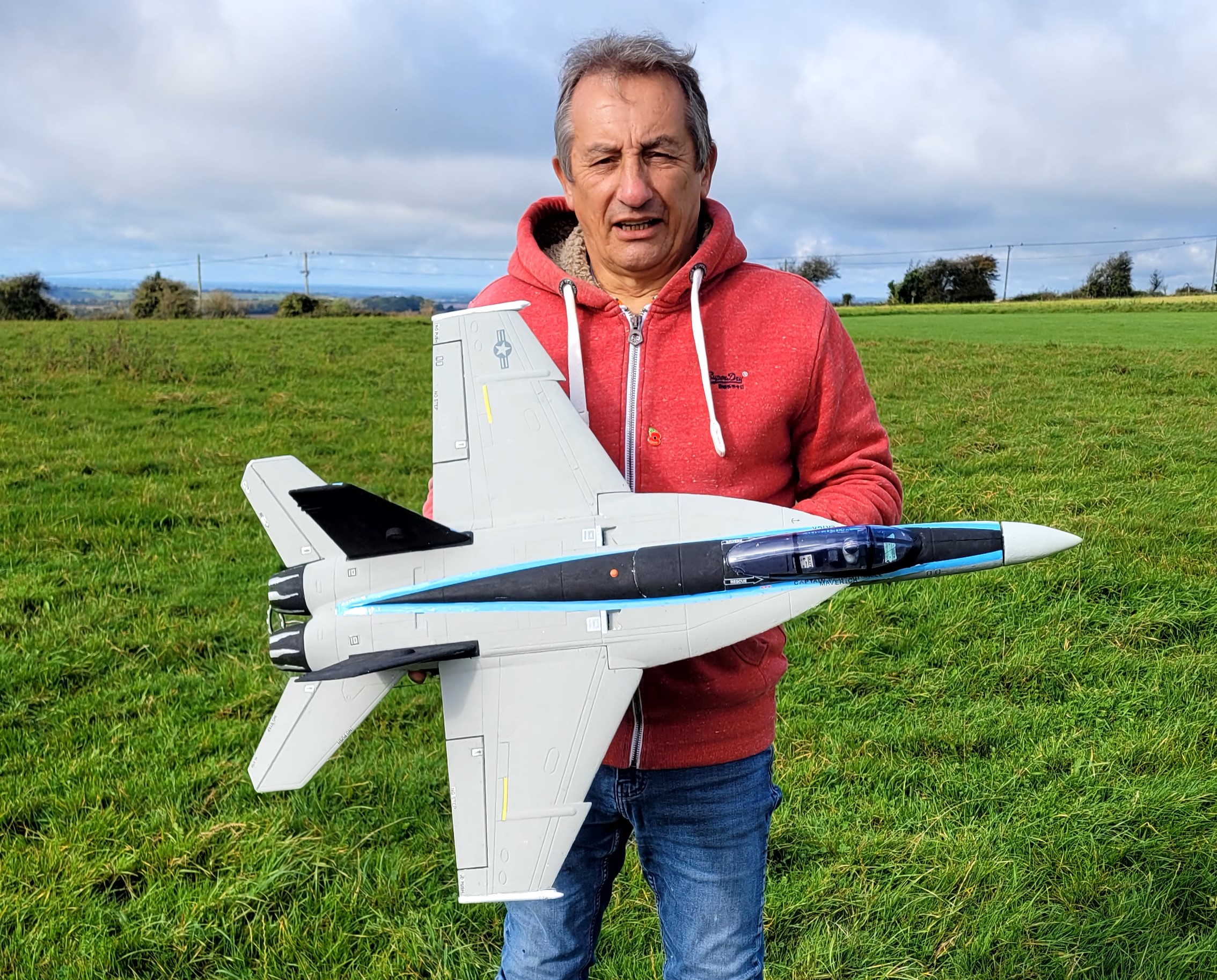
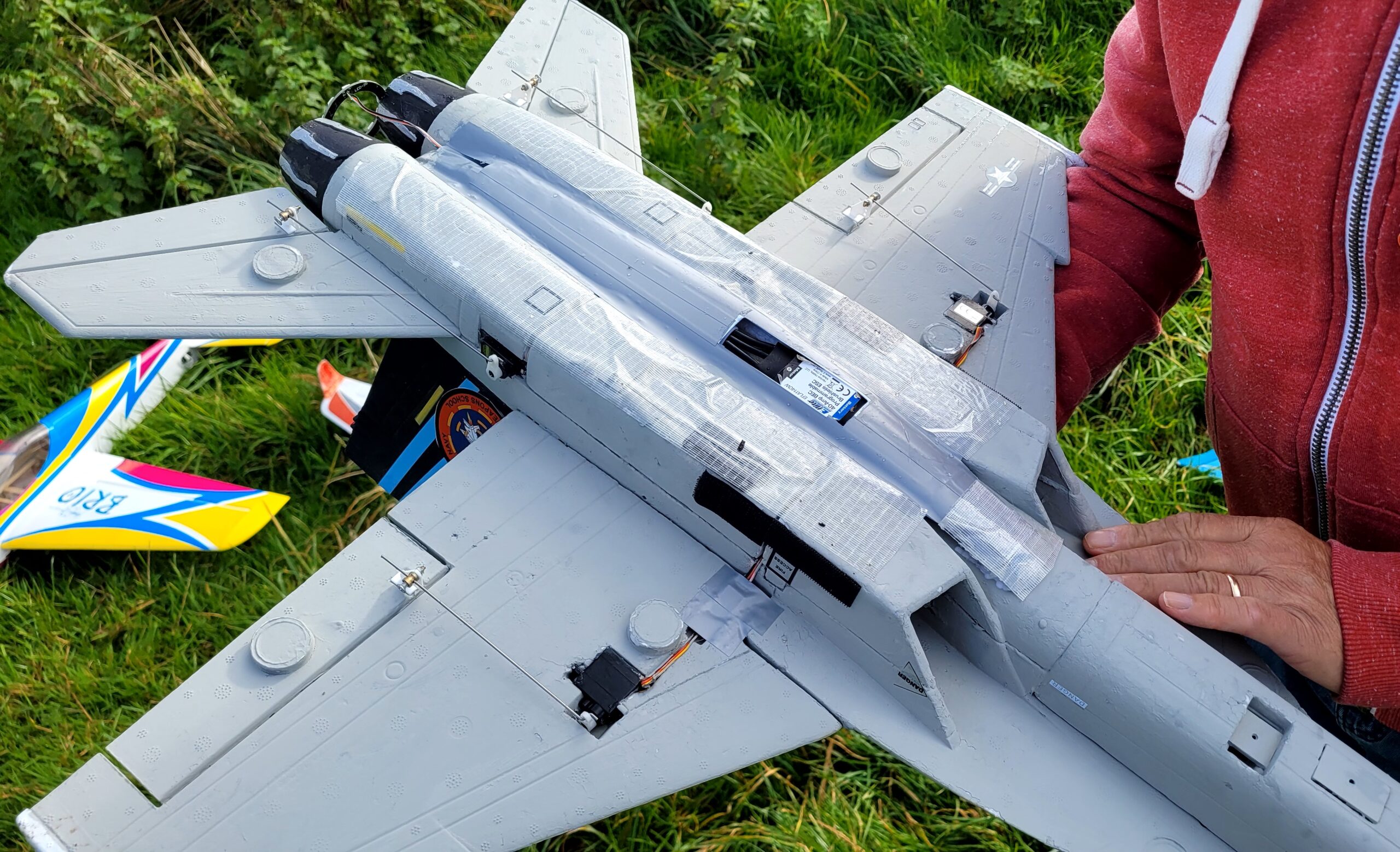 Woody fitted the F-18 with the 64mm fan and motor from the F-15 along with the 40A speed controller and four servos. He finished the Hornet with acrylic paints and of course, as this is Woody I’m talking about, he also added a reheat led light ring at the rear.
Woody fitted the F-18 with the 64mm fan and motor from the F-15 along with the 40A speed controller and four servos. He finished the Hornet with acrylic paints and of course, as this is Woody I’m talking about, he also added a reheat led light ring at the rear.
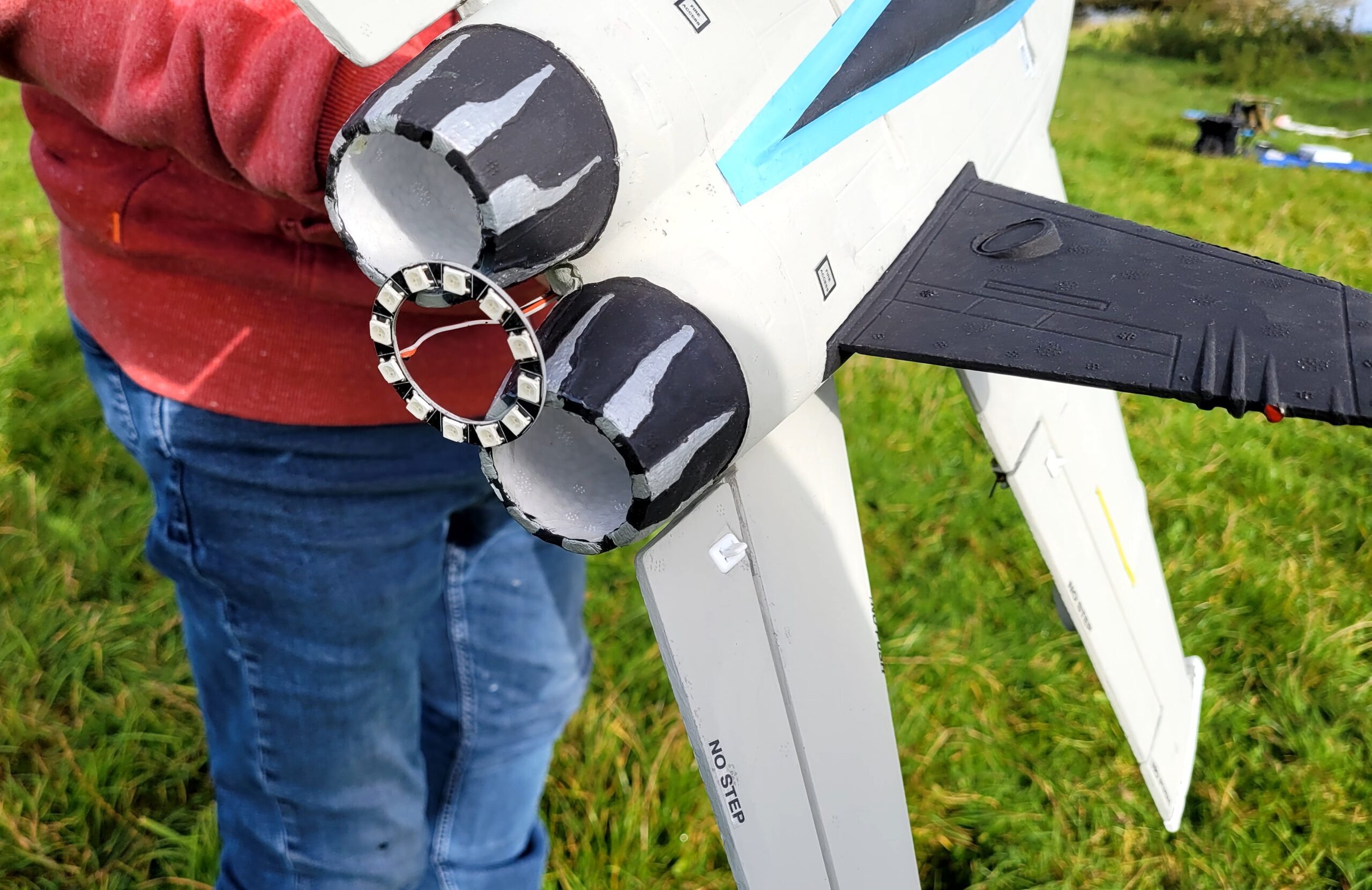 A pair of light rings would have been the more appropriate but he somehow managed to blow one up! The finished model looks smart and being much the same size and weight as the E-flite Eagle it should have enough power, so does it fly? Yes! Woody was unsure of the correct centre of gravity position and the first attempt at flight showed that it was much too far back. So lots of lead was temporarily added to the nose and another attempt made.
A pair of light rings would have been the more appropriate but he somehow managed to blow one up! The finished model looks smart and being much the same size and weight as the E-flite Eagle it should have enough power, so does it fly? Yes! Woody was unsure of the correct centre of gravity position and the first attempt at flight showed that it was much too far back. So lots of lead was temporarily added to the nose and another attempt made. 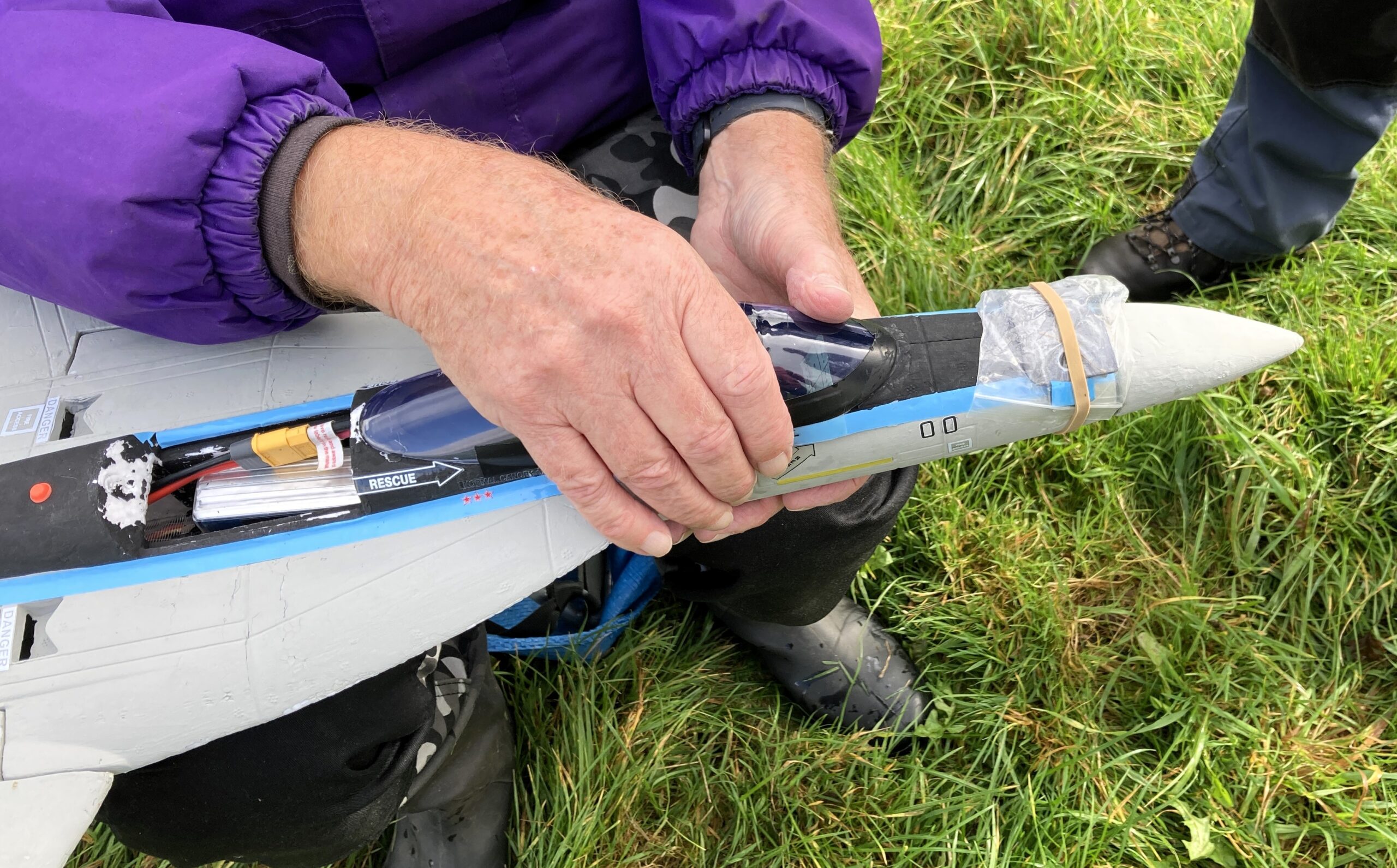 This time the C of G was too far forward and the Eagle wouldn’t climb away from the launch so some of the lead was removed. The next attempt showed the C of G was now correct and it went away from the launch and flew very nicely. Well done Woody, try not to break it! All three attempts and successful flight can be seen in this month’s video.
This time the C of G was too far forward and the Eagle wouldn’t climb away from the launch so some of the lead was removed. The next attempt showed the C of G was now correct and it went away from the launch and flew very nicely. Well done Woody, try not to break it! All three attempts and successful flight can be seen in this month’s video.
Young Leo has spent the money Dougal paid him for the Joker (but not on 3 cell 2200mAh batteries apparently!) and has bought a HobbyKing Paramotor V2. Bob the Builder built a few paramotor models several years ago, before the first HobbyKing one was available and had rather limited success with them although it was an interesting trial. But the HobbyKing one seems to be pretty well sorted, particularly the new V2 version.
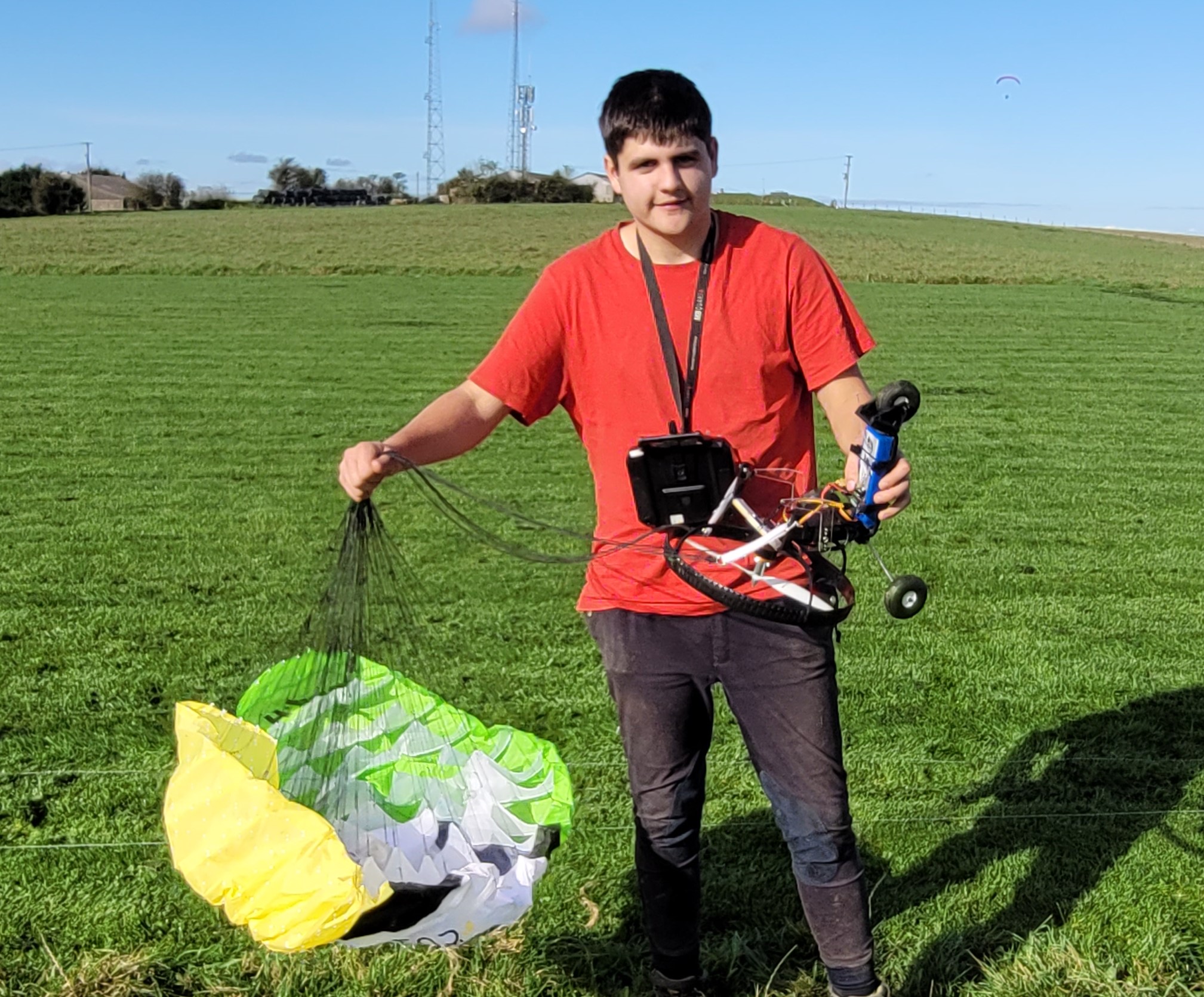 The first couple of attempts at flight didn’t go to plan but after a bit of checking, consulting everyone, and listening to various differing opinions Leo reversed the aileron control and away it went. As it happened there were a couple of full-size paramotors flying as well and I managed to snap some photos that included a full-size one as well as Leo’s.
The first couple of attempts at flight didn’t go to plan but after a bit of checking, consulting everyone, and listening to various differing opinions Leo reversed the aileron control and away it went. As it happened there were a couple of full-size paramotors flying as well and I managed to snap some photos that included a full-size one as well as Leo’s.
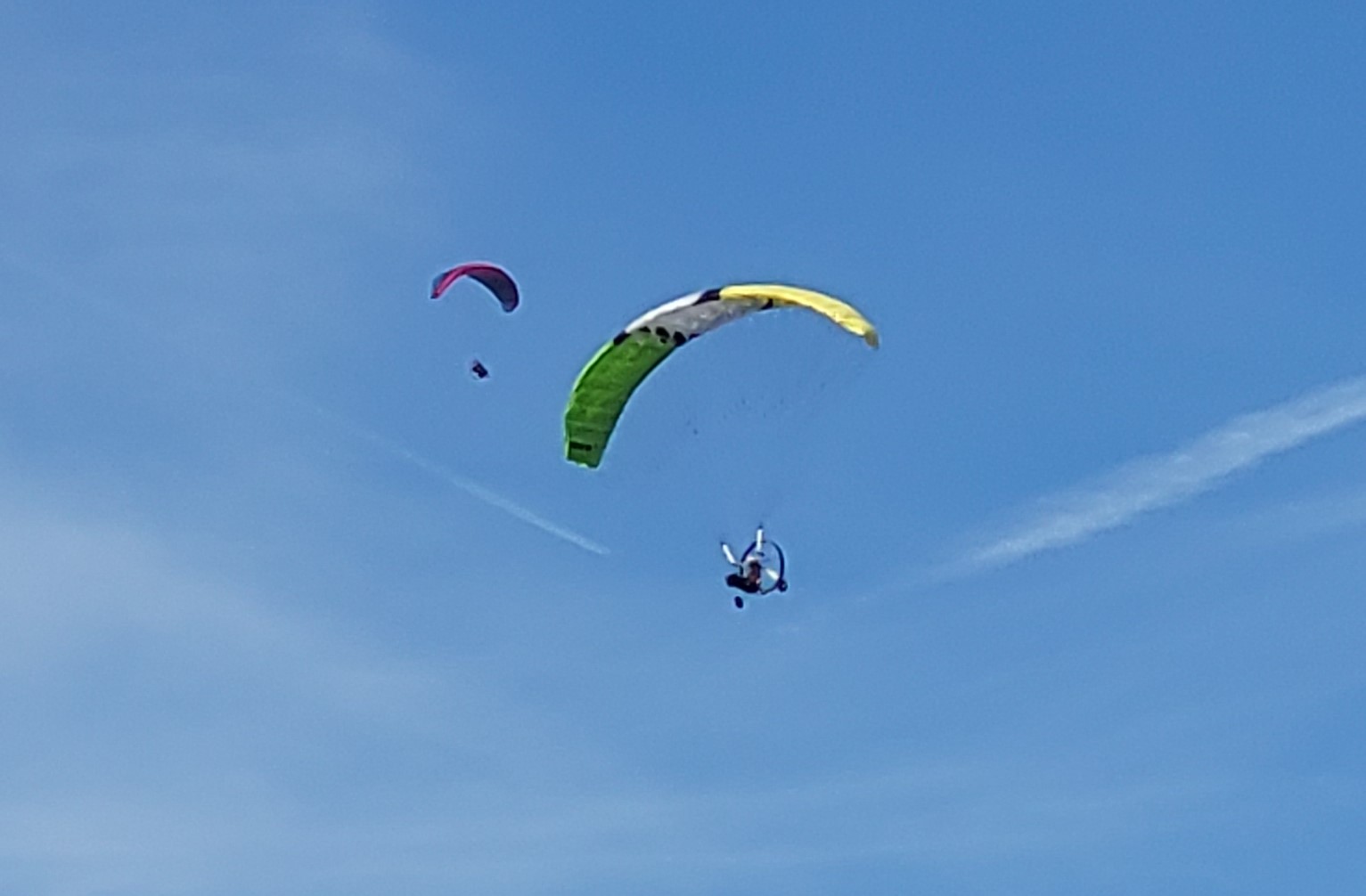
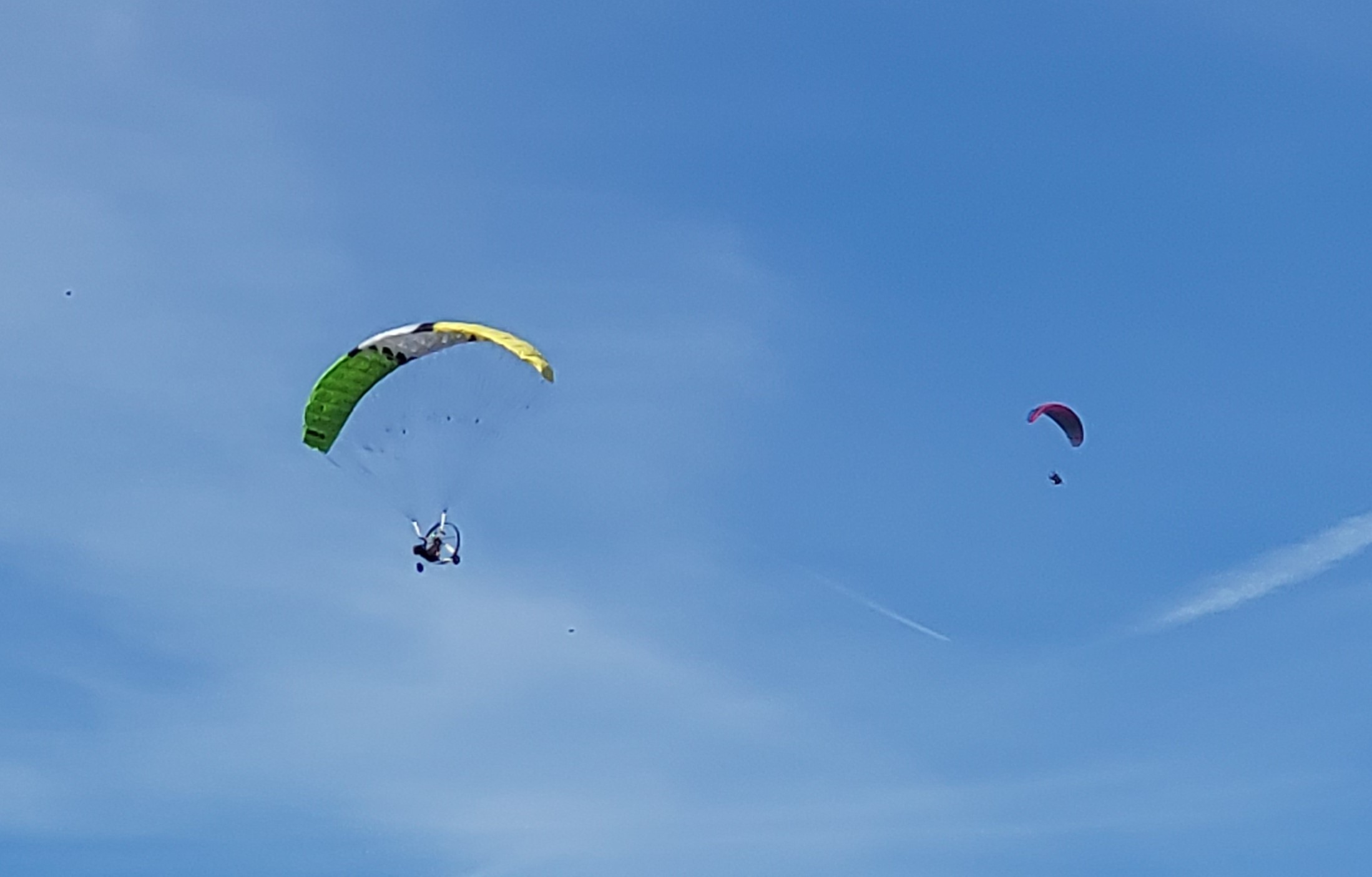 The shots were taken with a high zoom setting and the at no point did the model get remotely close to the full-sized one. Leo didn’t seem to have any problems with the Paramotor and had a long flight followed by a perfect landing back on the patch.
The shots were taken with a high zoom setting and the at no point did the model get remotely close to the full-sized one. Leo didn’t seem to have any problems with the Paramotor and had a long flight followed by a perfect landing back on the patch.
 This is from the HobbyKing website: Following on from the incredible success of the first H-King Paramotor comes this V2. The V2 still retains many of the characteristics of the original version, including the ability to perform loops and rolls with ease after a little practice. The large area high performance 2400mm parafoil wing opens quickly for easy launching and due to its design it will retain its shape even in severe turbulence. The single-skin durable wing is made from 100% ripstop fabric and the new, stronger nylon chords are rigged and ready to attach to the durable aluminium gondola. Just like the original version, there is a high level of prefabrication so assembly time is kept to a minimum, and as it is supplied in a Plug-N-Fly format all you will require to get flying is your transmitter, receiver, LiPo battery, and charger. The Paramotor V2 is fitted with a powerful 3530-1400KV brushless motor swinging a 10×4.7 propellor, has a 50A electronic speed controller with 5A BEC, and 2 powerful 15kg high torque metal geared servos. A 3S LiPo battery is recommended and it can vary in capacity to suit different flying conditions. The recommended flying weight is 1.6~2.0kg, in light wind conditions it is best to put a lighter battery in to keep near the 1.6kg weight. In windy conditions, it is better to put a heavier battery in to fly around the 2kg mark. Ultra-long flights of 20~45mins can be achieved depending on the size of the battery used.
It will be interesting to see how the Paramotor performs in stronger winds but in the light winds when Leo flew it there didn’t appear to be any problems at all. MacFly recorded a lot of the first three flights and you can see some of it in this month’s video.
This is from the HobbyKing website: Following on from the incredible success of the first H-King Paramotor comes this V2. The V2 still retains many of the characteristics of the original version, including the ability to perform loops and rolls with ease after a little practice. The large area high performance 2400mm parafoil wing opens quickly for easy launching and due to its design it will retain its shape even in severe turbulence. The single-skin durable wing is made from 100% ripstop fabric and the new, stronger nylon chords are rigged and ready to attach to the durable aluminium gondola. Just like the original version, there is a high level of prefabrication so assembly time is kept to a minimum, and as it is supplied in a Plug-N-Fly format all you will require to get flying is your transmitter, receiver, LiPo battery, and charger. The Paramotor V2 is fitted with a powerful 3530-1400KV brushless motor swinging a 10×4.7 propellor, has a 50A electronic speed controller with 5A BEC, and 2 powerful 15kg high torque metal geared servos. A 3S LiPo battery is recommended and it can vary in capacity to suit different flying conditions. The recommended flying weight is 1.6~2.0kg, in light wind conditions it is best to put a lighter battery in to keep near the 1.6kg weight. In windy conditions, it is better to put a heavier battery in to fly around the 2kg mark. Ultra-long flights of 20~45mins can be achieved depending on the size of the battery used.
It will be interesting to see how the Paramotor performs in stronger winds but in the light winds when Leo flew it there didn’t appear to be any problems at all. MacFly recorded a lot of the first three flights and you can see some of it in this month’s video.

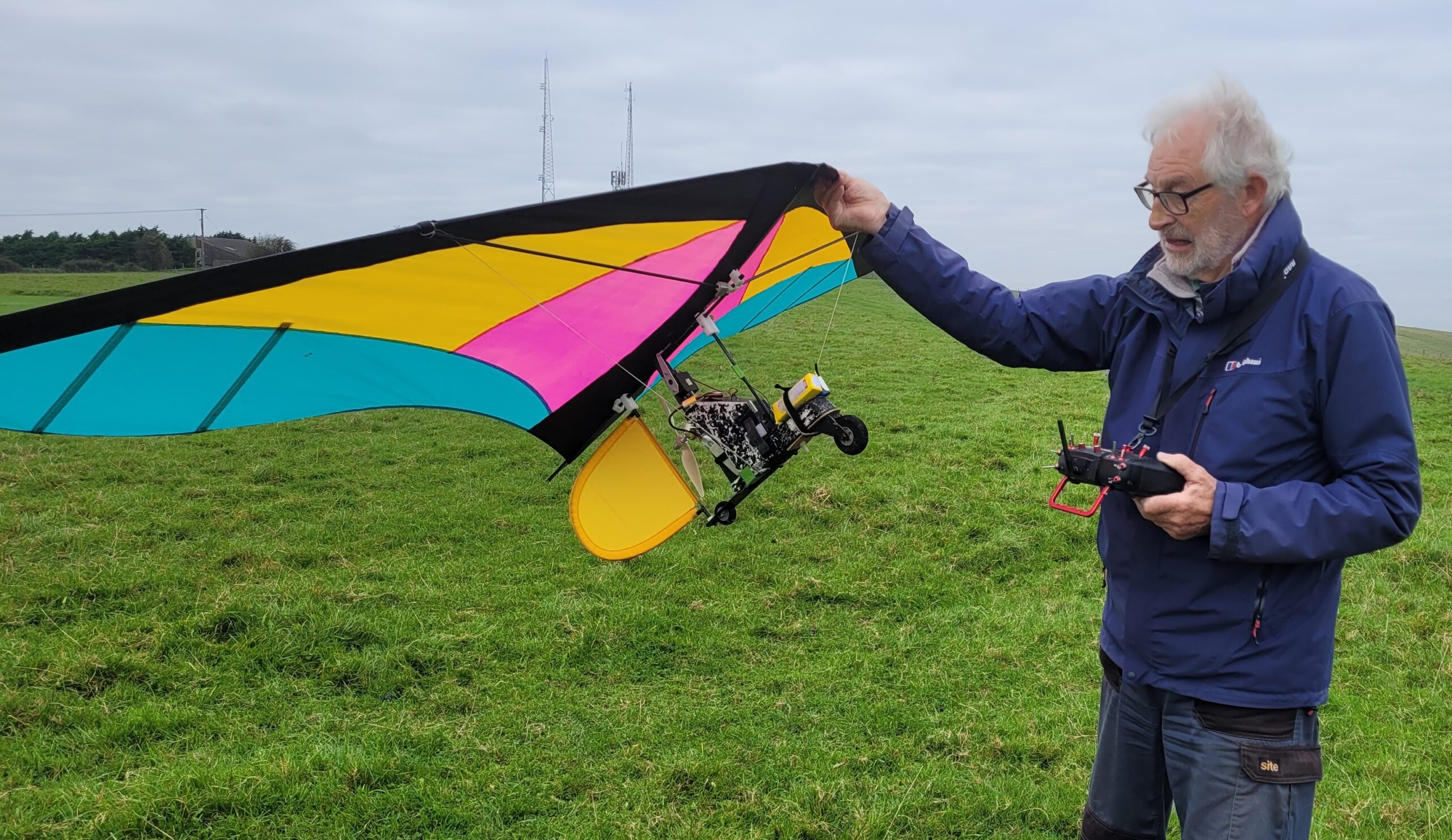 MacFly took some video for us but as it was on 30th October it was too late to be include in this month’s video but it will be something to look forward to next month!
MacFly took some video for us but as it was on 30th October it was too late to be include in this month’s video but it will be something to look forward to next month!
This month the ‘action shots’ are all taken from the video so not the best quality I’m afraid: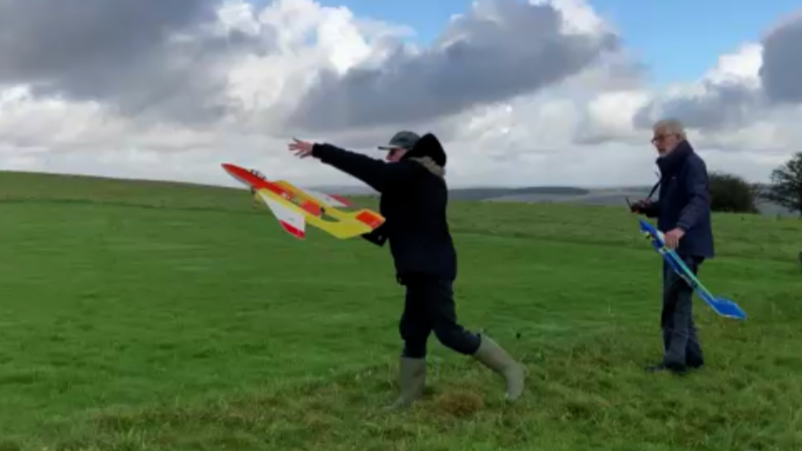

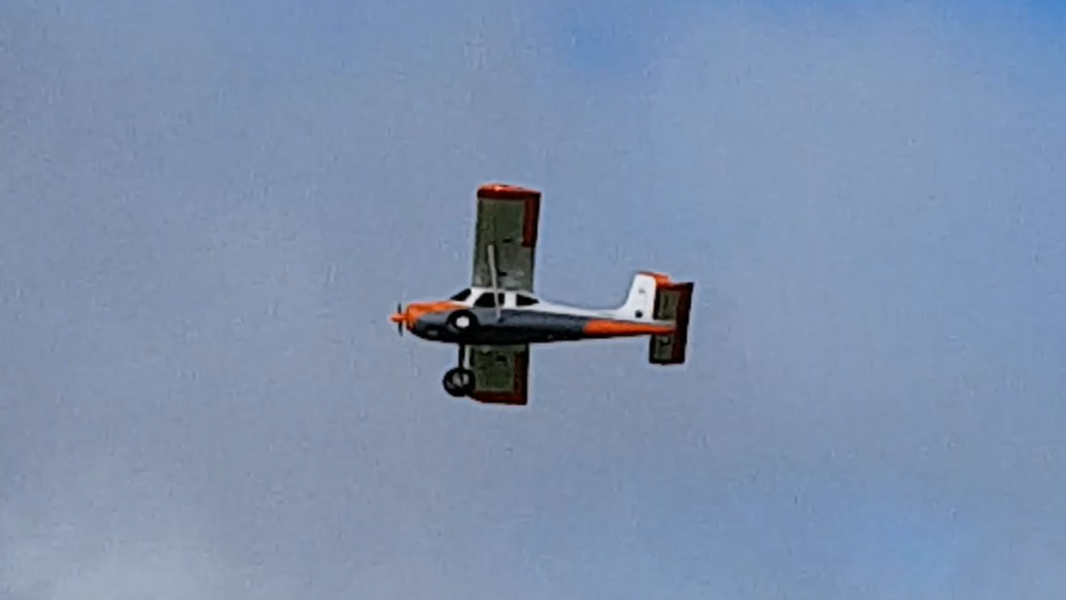



Video time now, this month with footage taken by myself and MacFly. Please watch the video full-screen, it’s so much better with small models flying around: If the video won’t play for you please click HERE
Marry someone who says things like: I’m proud of you… You can do it darling… I can’t believe you’re mine… I don’t know where that extra aeroplane came from but it looks amazing alongside all the others and I think we’re going to need a bigger hangar.
Colin Cowplain
Patch News – September 2024
I’ve just seen on TV that September was the wettest on record here in the south and Middle Wallop had four times the average September rainfall. I was away in warmer climes for part of the month but it seems there wasn’t much flying in my absence. Of course there was some flying but not as much as we’d hope for in September and we still haven’t seen the Indian summer that our chairman promised. While the month was very wet it was also reasonably warm and the grass continued to grow so was mown regularly.
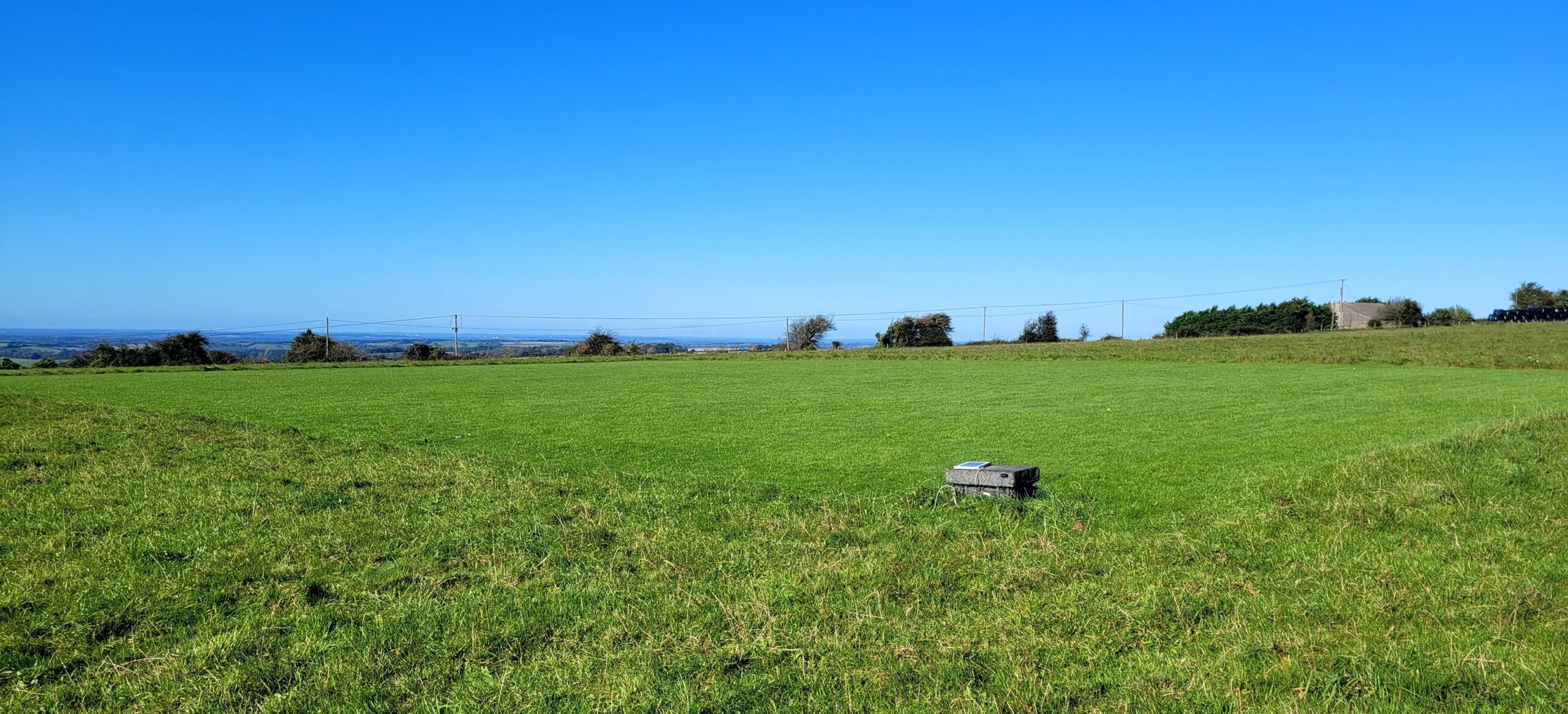 Woody deserves a special mention as when nobody liked the look of the flying weather one Friday morning Woody took it upon himself to mow the patch alone. 1066 reckons he should be known as the Lone Mower so maybe the mowers should be Silver and Tonto?
Woody deserves a special mention as when nobody liked the look of the flying weather one Friday morning Woody took it upon himself to mow the patch alone. 1066 reckons he should be known as the Lone Mower so maybe the mowers should be Silver and Tonto?
I missed the Popham Model Show so I’ve asked Dougal Entendre to tell us about it: Popham this year was pretty much its normal self, but with marginally worse weather. Leo and I went on the Saturday, as this seemed to have the better forecast, though I think the Sunday turned out pretty much the same. Anyway, there was no weather-induced break in the flying while we were there, despite the odd light shower.
Having scored a winner with his Salto purchase the previous year, Leo had brought a wad of cash along, so we headed straight for the Bring-and-Buy. In almost no time at all he had parted with much of it for a rather nice Multiplex Joker glider (with electric conversion), and a slightly battered 3D Hobby Shop AJ-Slick (same as 1066’s, but with more history written all over it). This meant two long walks back to the car park to deposit the goods in the back of my estate.
Our legs were starting to show the strain, as was Leo’s wallet, so we headed for the flying displays. It was mostly a mix of Futura-style jets, petrol-powered 3D aerobatics, and the odd jet-powered glider. We were particularly impressed with a 12-year-old 3D pilot, and a couple of half-scale Piper Cubs which put on an excellent display of synchronised aerobatics:
On one of the trips back to the car we bumped into Captain Slow and Woody, and later on we met Patrick and his son Joe, who seemed to be enjoying the show.
Back at the trade stands Leo fell for a second-hand foam biplane (I can’t remember the details, but it did seem like quite a good price), so that used up even more space in the back of my wagon. When we left in the early afternoon there were still a few unsold items at the Bring-and-Buy; among them was quite a nice autogyro, fully equipped except for radio, which the guy offered us for a knockdown price. Realising I might be in trouble with Leo’s Mum if I let him buy that too, I hastily closed the deal myself, so we came back with quite a car load.
Subsequently Leo brought the Joker and Slick along to the patch, and both flew well.
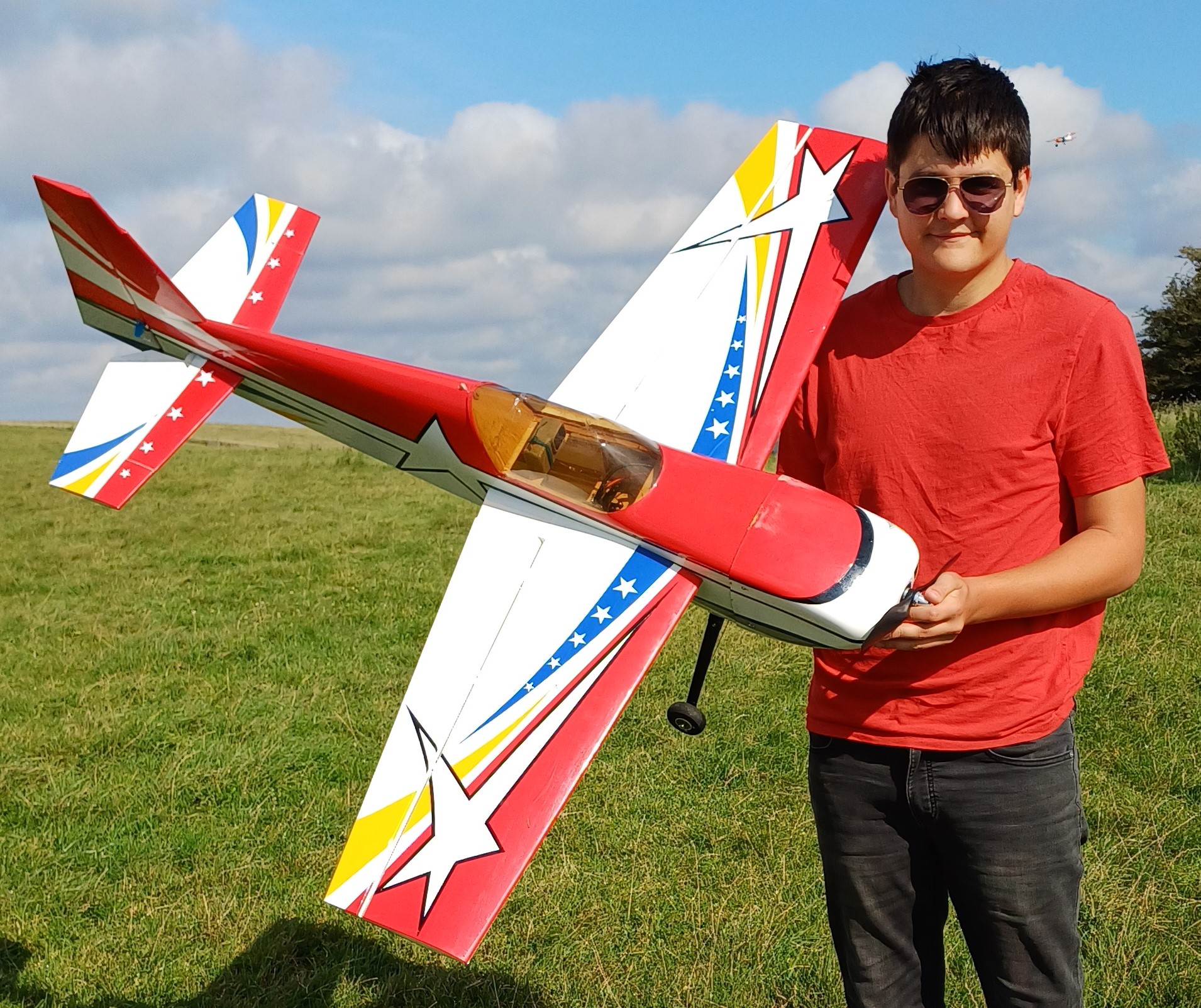 The Slick has a motor which won’t take more than a 3S pack, so it’s not 3D capable, but it still seems like quite a good aerobat. The Joker had amazing performance, though there were several things which needed sorting (ESC, flaps and rudder), so I struck a deal with Leo – the Joker is now mine, and he has the autogyro (some money also changed hands)! I’m looking forward to getting the Joker in the air once I’ve sorted the electronics, and I hope we see Leo’s autogyro at the patch soon. So all-in-all a very enjoyable morning, with plenty of purchases to show for it!
The Slick has a motor which won’t take more than a 3S pack, so it’s not 3D capable, but it still seems like quite a good aerobat. The Joker had amazing performance, though there were several things which needed sorting (ESC, flaps and rudder), so I struck a deal with Leo – the Joker is now mine, and he has the autogyro (some money also changed hands)! I’m looking forward to getting the Joker in the air once I’ve sorted the electronics, and I hope we see Leo’s autogyro at the patch soon. So all-in-all a very enjoyable morning, with plenty of purchases to show for it!
Thanks for that Dougal, it sounds as if I missed a good day as well as some bargains. Leo shot some video at the show which he has added to his YouTube channel in two parts.
Take a look at them on his YouTube channel by clicking HERE
I’ve trawled the internet for information on the Multiplex Joker that Dougal has now bought from Leo but have not managed to find out much at all. As far as I can tell the Joker was discontinued many years ago, there’s a suggestion that was due to the cost of production being too close to the selling price. The obechi veneered foam wings span 3333mm (virtually eleven feet) and the 1350mm long fuselage is moulded in fibreglass.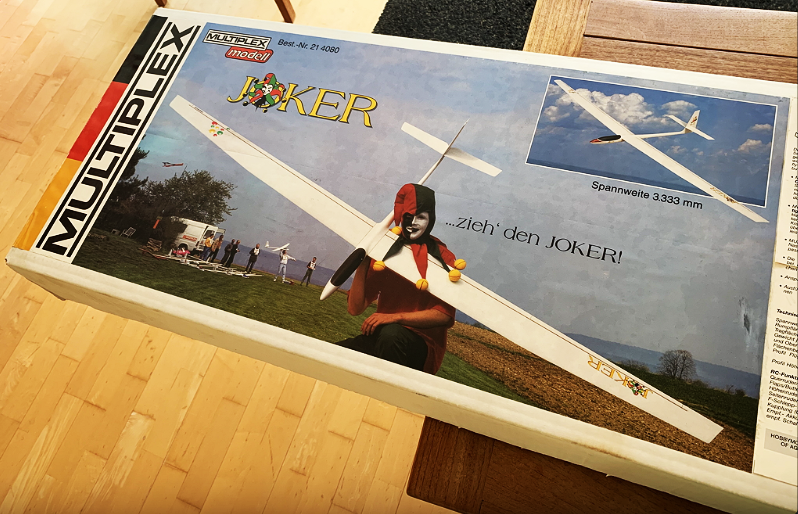
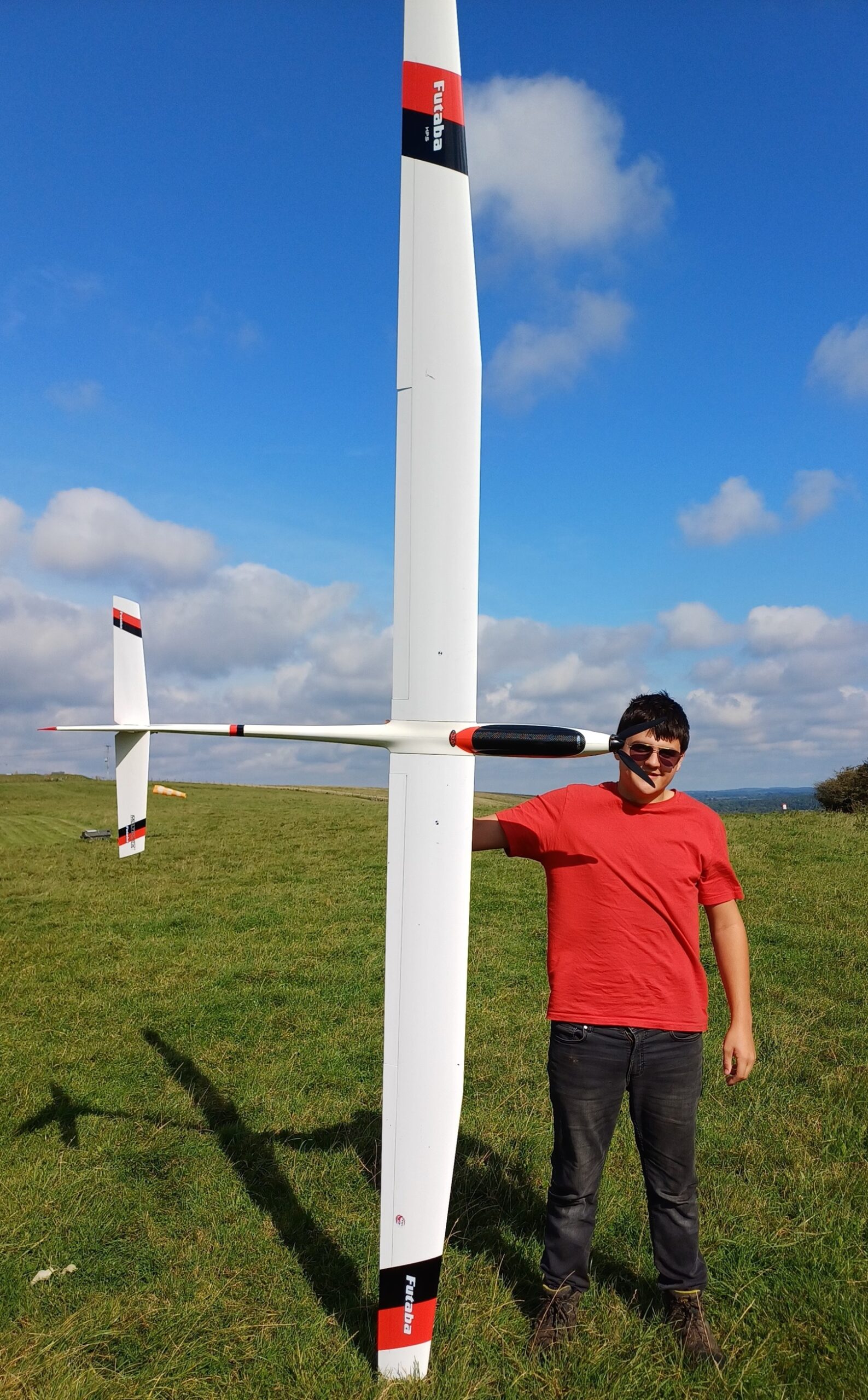 Dougal tells me that on his Joker the wings have been beautifully glass-clothed. I have only found specifications for a glider version but there are several electric powered ones around so presumably there was an electric version available. It appears to be very well rated in everything I can find, no doubt I’ll be able to tell you more next month.
Dougal tells me that on his Joker the wings have been beautifully glass-clothed. I have only found specifications for a glider version but there are several electric powered ones around so presumably there was an electric version available. It appears to be very well rated in everything I can find, no doubt I’ll be able to tell you more next month.
When writing Patch News I use the internet a great deal to find information on models etc. and very often Google comes up with stuff that is only very loosely related to my search but is quite interesting anyway. While I was looking for information on the Multiplex Joker I stumbled across a piece about full-size gliding which has a bit of local interest:
Robert Kronfeld, the famous pioneer, showed the way when on June 17, 1930 he flew from Itford Hill (East Sussex) to very near Portsmouth, a feat which amazed the other pilots at the time. An extract from his book is well worth repeating here: “I only cleared the last small hill near Petersfield by three hundred feet. In view of the noiselessness of my flight and the advanced evening hour it struck me that I was very indiscreet in flying over a small wood swarming with courting couples. I imagine that it was not exactly considerate of me to call out at the top of my voice “Whcre’s Portsmouth?”
Just outside Petersfield back in 1930? Bob the Builder was probably there!
Last month I showed you a couple of photos that 1066 had sent me of the Dancing Wings Cub that he’d started building and I promised some more info on the build this month.
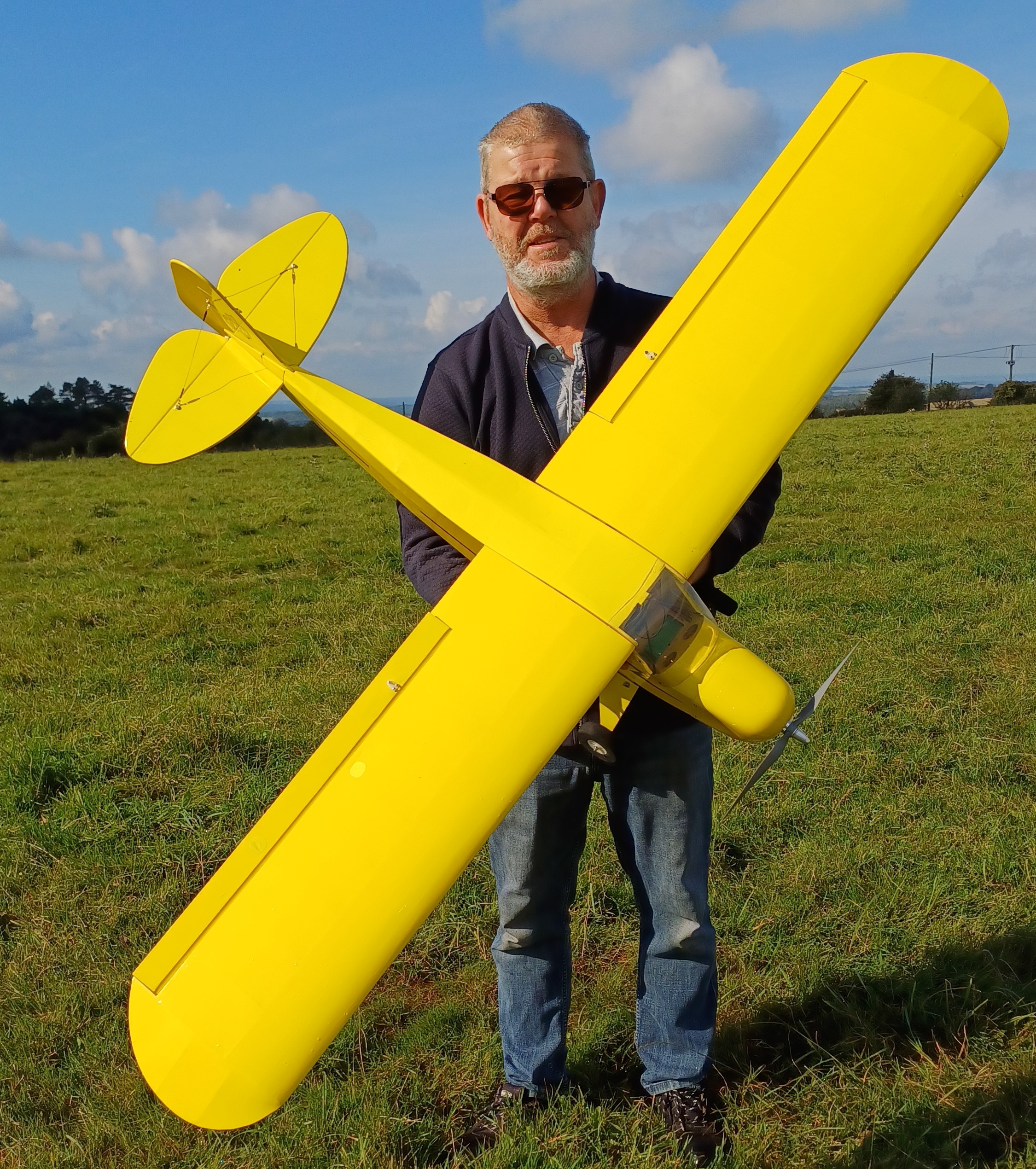 Well, there’s been a development, this photo is 1066 with his Dancing Wings Cub…but it’s not the one he was building. The Cub that 1066 had started building was a 1200mm span version but then he spotted a larger used ready built and ready to go Dancing Wings Cub for sale locally which he snapped up. This one is the 1775mm wingspan version and is the actual Piper J-3 Cub that was built by Rob Lawes of the RC Model Geeks YouTube channel in 2017 and featured in several of his videos. It’s powered by a Propdrive V2 3548 900KV brushless motor linked to a Hobbyking Red Brick V2 70A speed controller. It’s fitted with four Corona DS339MG digital metal gear servos and the whole lot runs on a 4 cell lipo.
Well, there’s been a development, this photo is 1066 with his Dancing Wings Cub…but it’s not the one he was building. The Cub that 1066 had started building was a 1200mm span version but then he spotted a larger used ready built and ready to go Dancing Wings Cub for sale locally which he snapped up. This one is the 1775mm wingspan version and is the actual Piper J-3 Cub that was built by Rob Lawes of the RC Model Geeks YouTube channel in 2017 and featured in several of his videos. It’s powered by a Propdrive V2 3548 900KV brushless motor linked to a Hobbyking Red Brick V2 70A speed controller. It’s fitted with four Corona DS339MG digital metal gear servos and the whole lot runs on a 4 cell lipo. 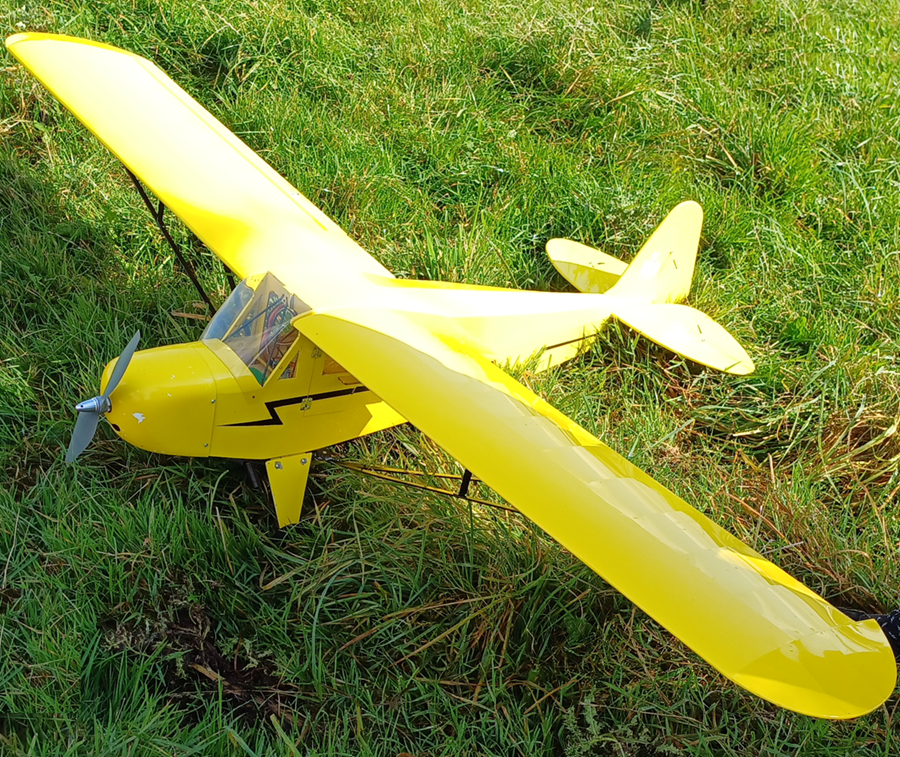 The model features a proper sprung undercarriage as per the full-size Cub, two hefty 10mm carbon fire tube wing joiners and working light alloy main and jury struts. The struts attach to the fuselage on a pin with an ‘R’ clip which ensures quick assembly and disassembly. Dougal took the photos when 1066 took it to the field for its first outing and since then he’s added some trim and lettering to brighten it up a bit. In this month’s video you can see that the registration he’s added is G-JEPH, I’m not sure why he decided to call it Geoff but apparently he’s having trouble with his speel chequer! So what has happened to the Cub 1066 was building? He says he wasn’t really enjoying the build so, having the larger one, he’s decided to sell it part built. It looks as if he’s done lots of the work already
The model features a proper sprung undercarriage as per the full-size Cub, two hefty 10mm carbon fire tube wing joiners and working light alloy main and jury struts. The struts attach to the fuselage on a pin with an ‘R’ clip which ensures quick assembly and disassembly. Dougal took the photos when 1066 took it to the field for its first outing and since then he’s added some trim and lettering to brighten it up a bit. In this month’s video you can see that the registration he’s added is G-JEPH, I’m not sure why he decided to call it Geoff but apparently he’s having trouble with his speel chequer! So what has happened to the Cub 1066 was building? He says he wasn’t really enjoying the build so, having the larger one, he’s decided to sell it part built. It looks as if he’s done lots of the work already
 I believe Chas has shown some interest but as far as I know it’s still available.
I believe Chas has shown some interest but as far as I know it’s still available.
Gordon Bennett flew two new models on September, the first being an E-flite Mustang. 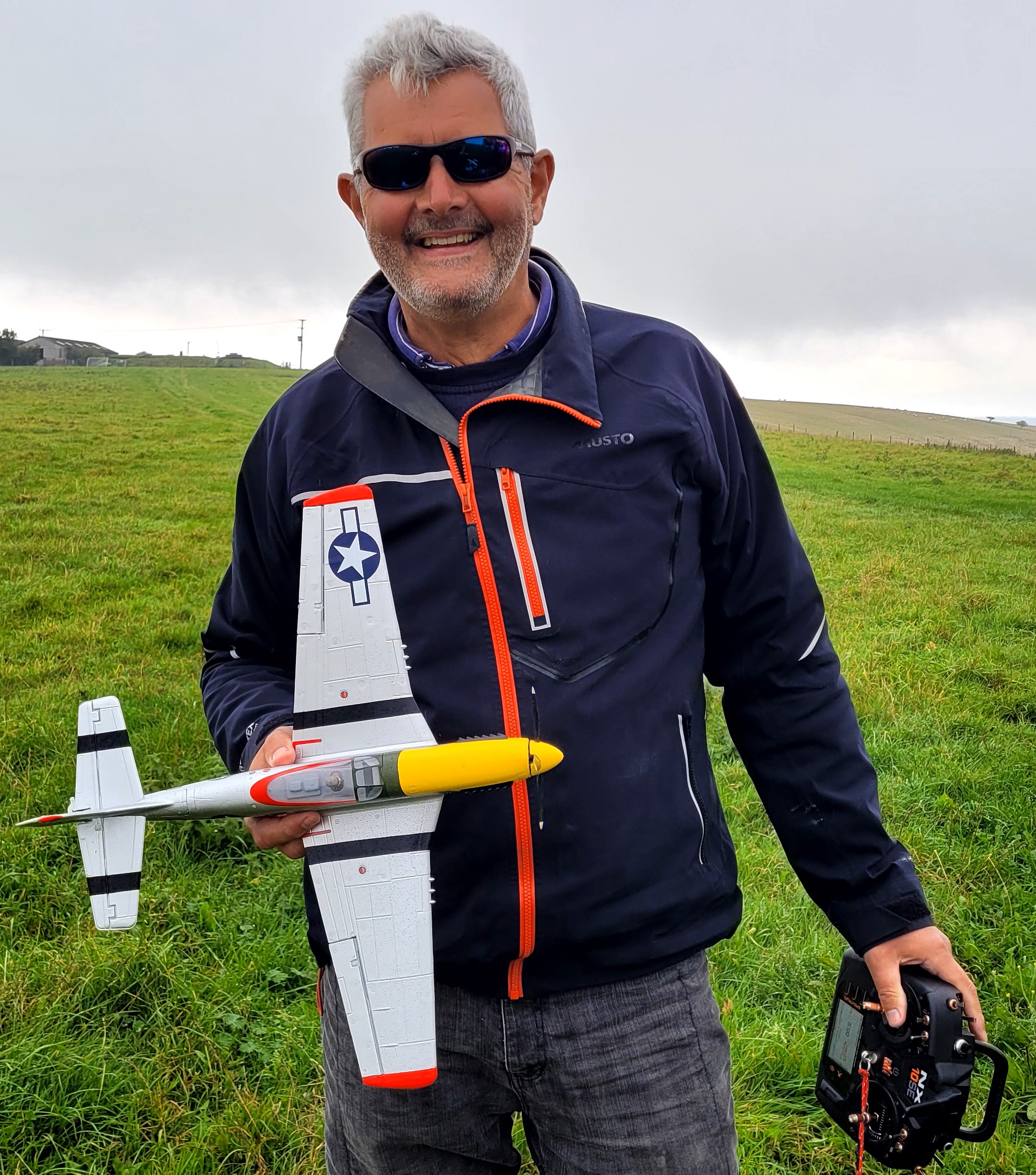 Gordon’s excuse for the purchase was that he’d had a win on the Premium Bonds, not that he needed an excuse. The Mustang is 493mm wingspan and will fly on either a two or a three cell battery, Gordon is using a 3 cell 300mAh lipo. This is from the E-flite website: The P-51D Mustang is world-renowned as quite possibly the most iconic fighter aircraft of all time! (Flippin’ Yanks, that’s the Spitfire!) Its unique design resulted in it delivering some of the best performance among all fighter aircraft flown in WWII. “Detroit Miss” is a history-making P-51D Mustang that was flown by Urban “Ben” Drew, and in 1944 he became the first USAAF pilot to shoot down two jet-powered Messerschmitt Me 262 fighter aircraft with it. The E-flite UMX P-51D Mustang is an ultra-micro sized model of the famous aircraft that’s a warbird version of the popular UMX P-51D Voodoo racer.
Gordon’s excuse for the purchase was that he’d had a win on the Premium Bonds, not that he needed an excuse. The Mustang is 493mm wingspan and will fly on either a two or a three cell battery, Gordon is using a 3 cell 300mAh lipo. This is from the E-flite website: The P-51D Mustang is world-renowned as quite possibly the most iconic fighter aircraft of all time! (Flippin’ Yanks, that’s the Spitfire!) Its unique design resulted in it delivering some of the best performance among all fighter aircraft flown in WWII. “Detroit Miss” is a history-making P-51D Mustang that was flown by Urban “Ben” Drew, and in 1944 he became the first USAAF pilot to shoot down two jet-powered Messerschmitt Me 262 fighter aircraft with it. The E-flite UMX P-51D Mustang is an ultra-micro sized model of the famous aircraft that’s a warbird version of the popular UMX P-51D Voodoo racer. 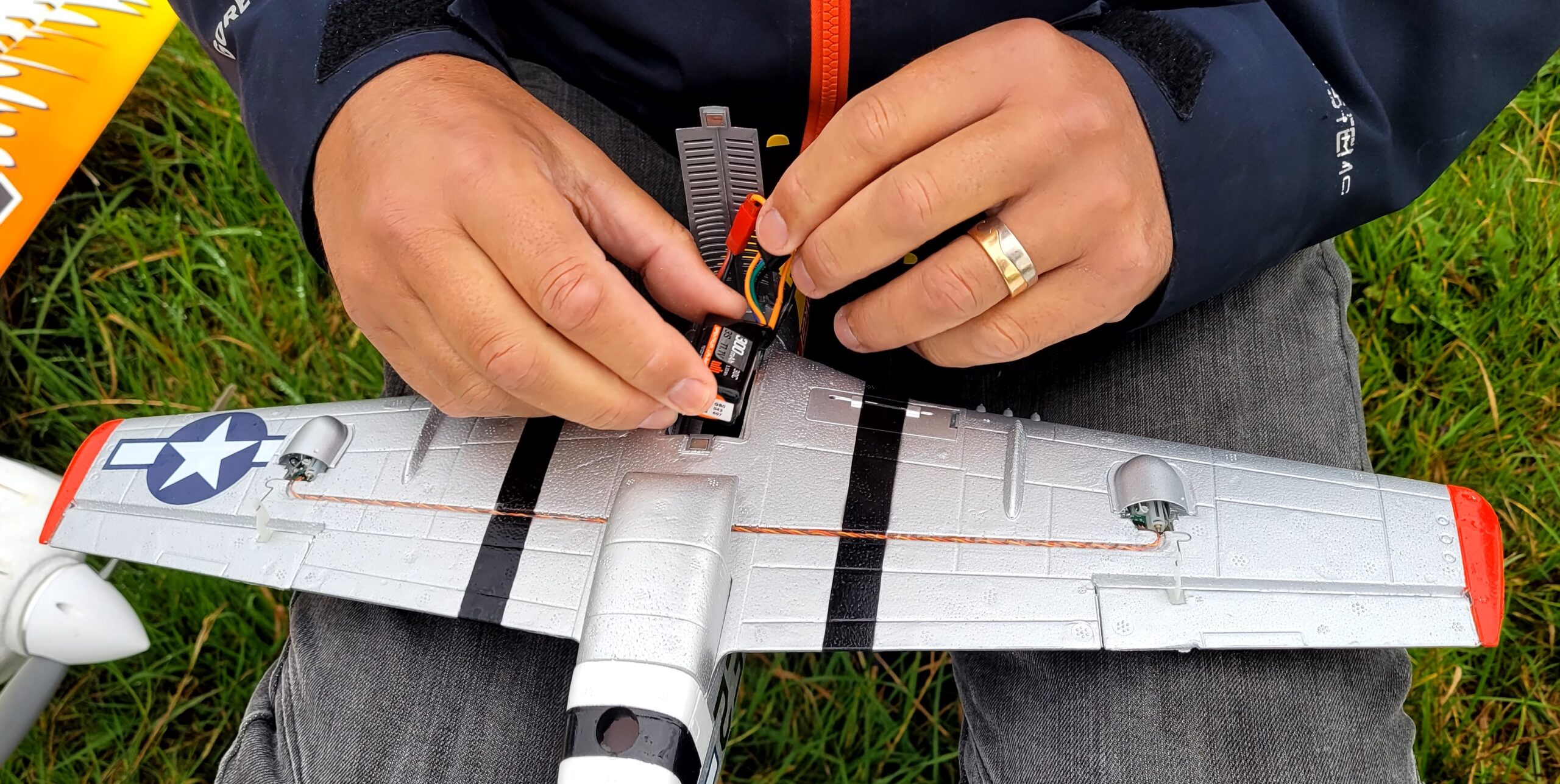 It’s equipped with expertly-tuned AS3X and optional-use SAFE Select technologies, is 2S and 3S battery compatible, and provides real-time battery voltage telemetry to compatible transmitters. Because of its ultra-micro size, the UMX P-51 can be flown in more places and smaller spaces including many yards, parks, and sports fields! The fixed landing gear with a steerable tailwheel makes it easy to taxi, take-off from, and land on smooth surfaces, or you can leave the landing gear off for more speed and vertical performance with easy hand launches over and landings on grass. It’s the most affordable, convenient, and easiest-to-fly replica of a P-51D Mustang yet!
It’s equipped with expertly-tuned AS3X and optional-use SAFE Select technologies, is 2S and 3S battery compatible, and provides real-time battery voltage telemetry to compatible transmitters. Because of its ultra-micro size, the UMX P-51 can be flown in more places and smaller spaces including many yards, parks, and sports fields! The fixed landing gear with a steerable tailwheel makes it easy to taxi, take-off from, and land on smooth surfaces, or you can leave the landing gear off for more speed and vertical performance with easy hand launches over and landings on grass. It’s the most affordable, convenient, and easiest-to-fly replica of a P-51D Mustang yet!
On the first flight Gordon had to add full down elevator trim so before the next flight he made some adjustments to the elevator linkage after which it was fine.
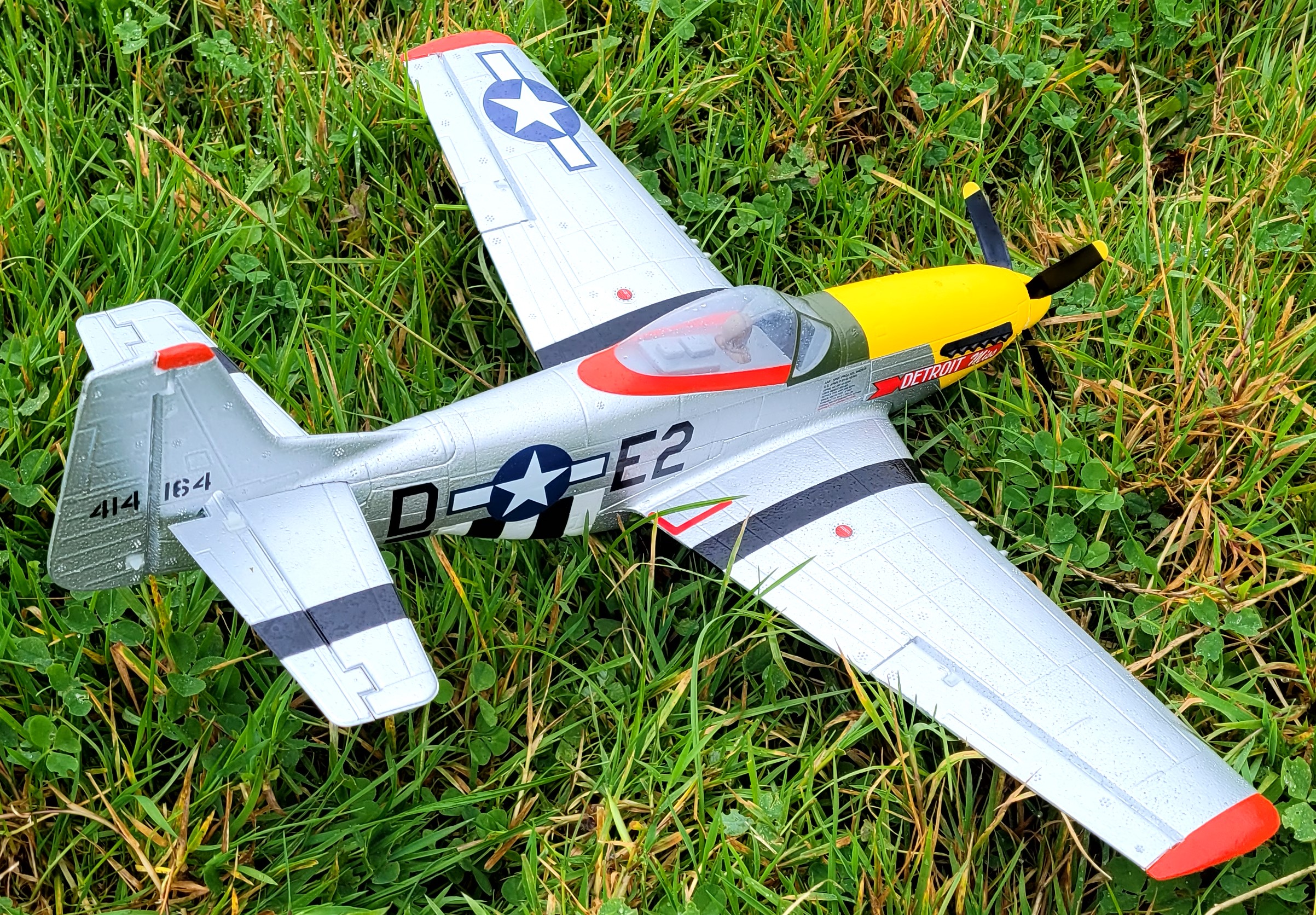 The Mustang appears to fly really nicely and the stabilisation cancels out most of the effects from buffeting winds. Overall it’s a great little flier and a good purchase.
The Mustang appears to fly really nicely and the stabilisation cancels out most of the effects from buffeting winds. Overall it’s a great little flier and a good purchase.
In Patch News a couple of months ago I showed you this photo of Dwayne Pipe’s Gnat that had suffered a minor misfortune…OK, a major misfortune…some would say a write-off!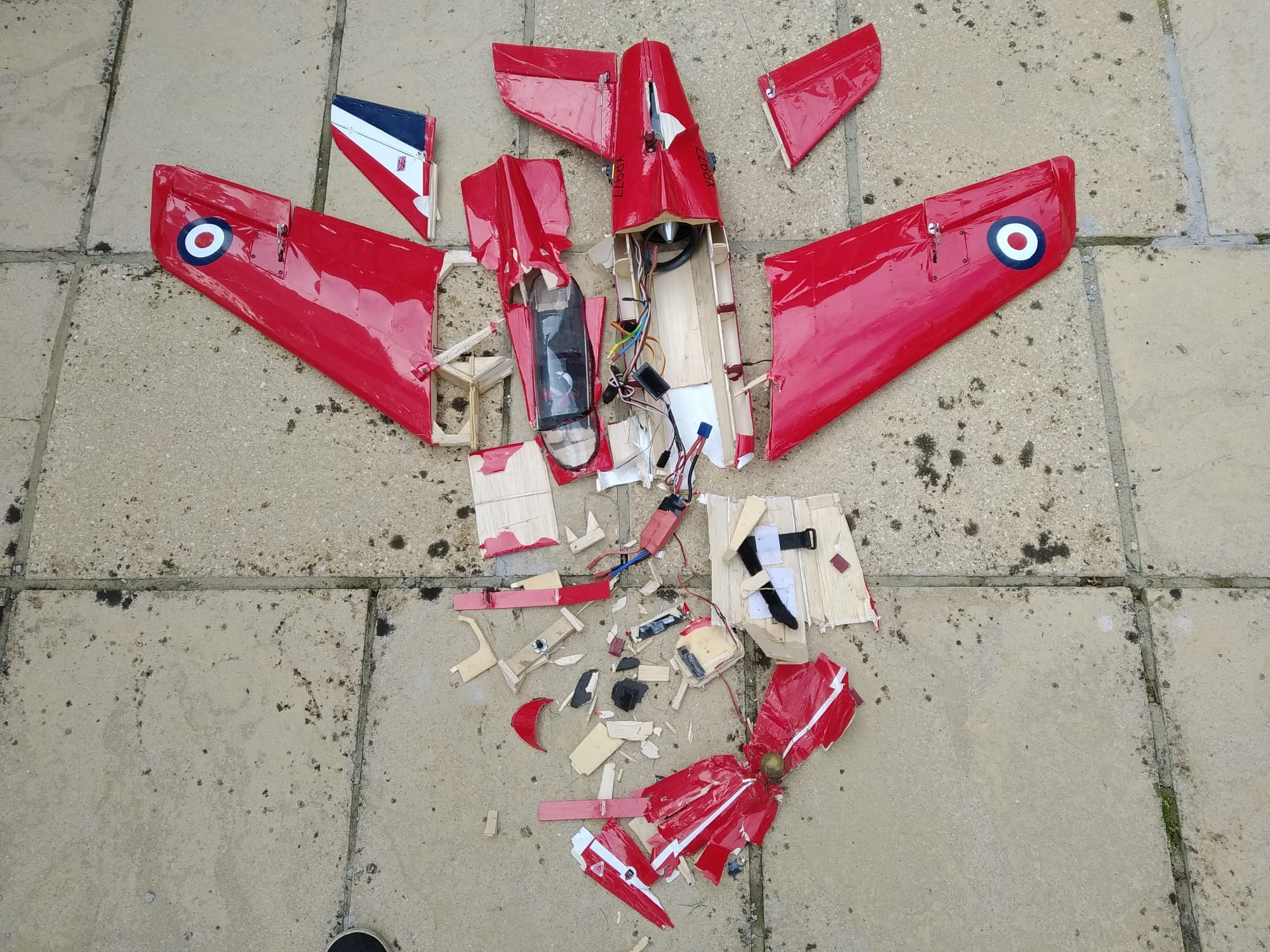
But Dwayne is an ardent builder and he’s not put off by a minor setback like that. As he’d designed the Gnat himself he knew exactly how to undertake the repairs so in September the Gnat re-emerged looking as if nothing had happened. As you’ll see in the video the Gnat went way from the launch ramp well but the battery pack failed almost immediately. 
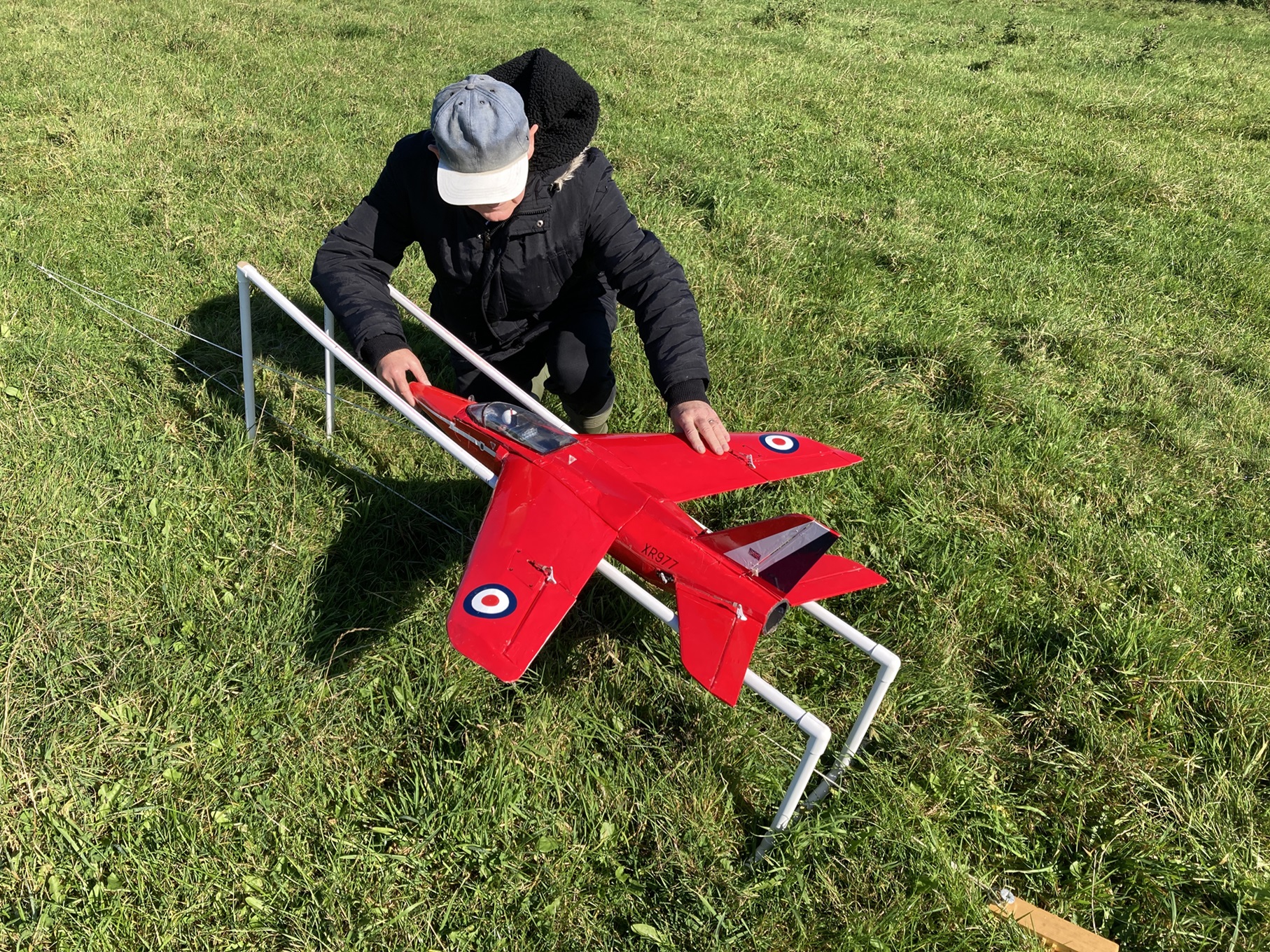 Dwayne got her safely down with no damage so just needs to sort out a replacement pack.
Dwayne got her safely down with no damage so just needs to sort out a replacement pack.
Gordon’s second new model was one he bought a while ago at a Southern Counties Swapmeet after selling his trainer there. It’s a Multiplex Extra 330SC which is an 1150mm wingspan full 3D machine moulded in foam with wood and carbon fibre reinforcement.
 It appears to be discontinued but I found some information on the AT Models website: F3P World Champion Gernot Bruckmann with the internationally successful Extra Aircraft Company and the talents of the Mirco Pecorari design studio have created an aerobatic model aircraft that has been tailor made for pilots who know what they want, know how to fly, and desire the very best 3D performance that is possible to get from a stunning out and out pattern and freestyle aerobat. That model is the Extra 330SC and if you add Multiplex world-class design and manufacturing experience to the heady mix of talent, the package is further enhanced by a powerful and extremely solid Elapor airframe that sets new standards in the 1.2m class. Its versatile too, and with exceptional longitudinal stability, very precise, conventional, F3A-style aerobatics are a joy to perform. This, then, is a model you’ll instantly fall in love with and one whose secrets will make you look so good, you’ll be reluctant to share them.
It appears to be discontinued but I found some information on the AT Models website: F3P World Champion Gernot Bruckmann with the internationally successful Extra Aircraft Company and the talents of the Mirco Pecorari design studio have created an aerobatic model aircraft that has been tailor made for pilots who know what they want, know how to fly, and desire the very best 3D performance that is possible to get from a stunning out and out pattern and freestyle aerobat. That model is the Extra 330SC and if you add Multiplex world-class design and manufacturing experience to the heady mix of talent, the package is further enhanced by a powerful and extremely solid Elapor airframe that sets new standards in the 1.2m class. Its versatile too, and with exceptional longitudinal stability, very precise, conventional, F3A-style aerobatics are a joy to perform. This, then, is a model you’ll instantly fall in love with and one whose secrets will make you look so good, you’ll be reluctant to share them.
The Extra has had some minor repairs but nothing major and it just needed a receiver and a three cell lipo to get it in the air. None of the Multiplex stuff is cheap and if I remember correctly Gordon only paid £80 so I reckon it was a real bargain for a top notch plane. 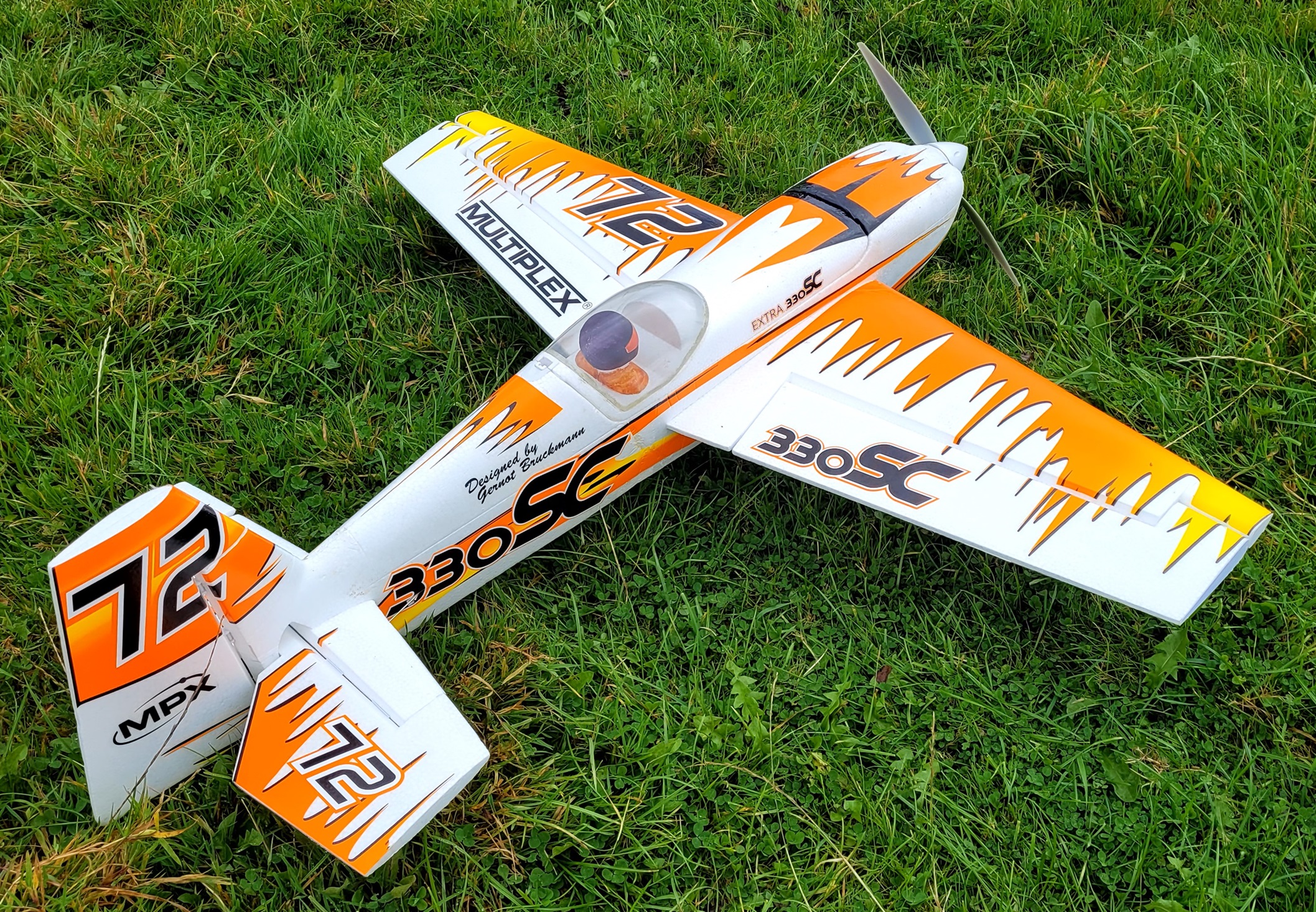
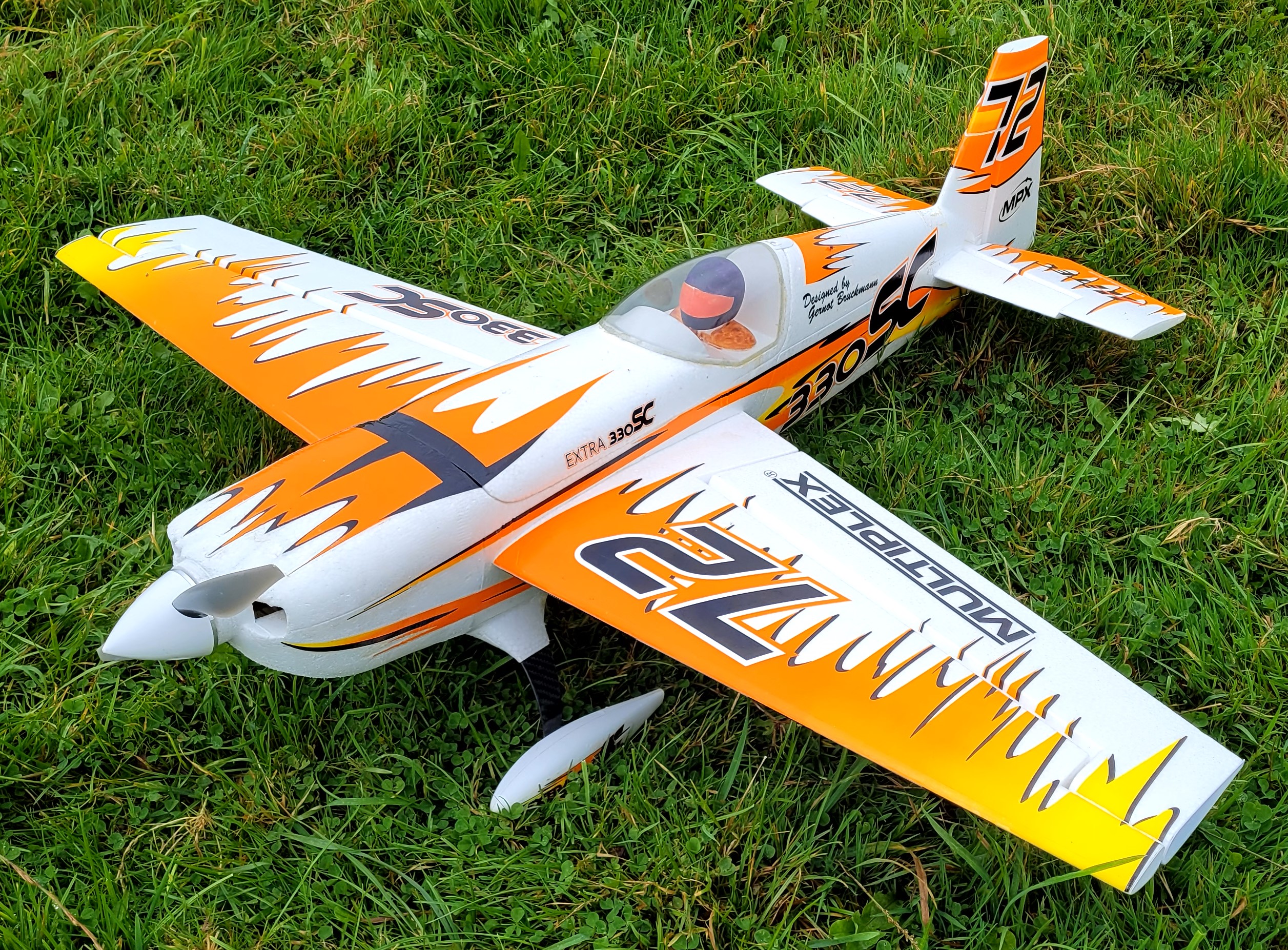
Gordon asked me to do the test flight and to trim it out. It needed no trimming and is an excellent flier so I quickly handed the transmitter over to Gordon to complete the flight.
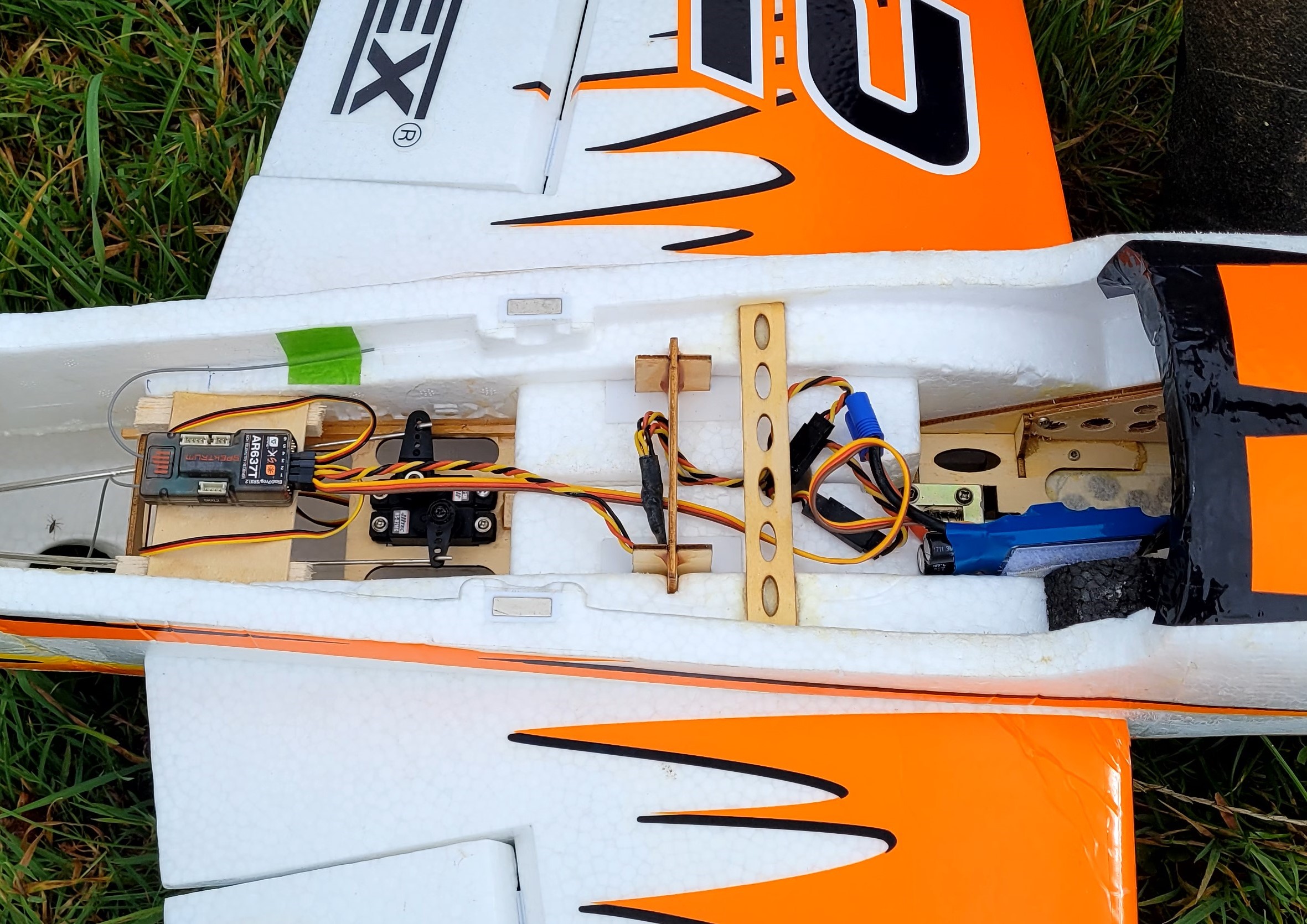 Gordon’s still playing around with the settings to get the Extra flying exactly as he likes it but it appears to be good so far. He’s going to remove the aileron Y lead and use separate channels. You can see how both of Gordon’s new toys perform in this month’s video.
Gordon’s still playing around with the settings to get the Extra flying exactly as he likes it but it appears to be good so far. He’s going to remove the aileron Y lead and use separate channels. You can see how both of Gordon’s new toys perform in this month’s video.
For the extra shots this month I’ve used some of Dougal’s photos from the Popham Show:
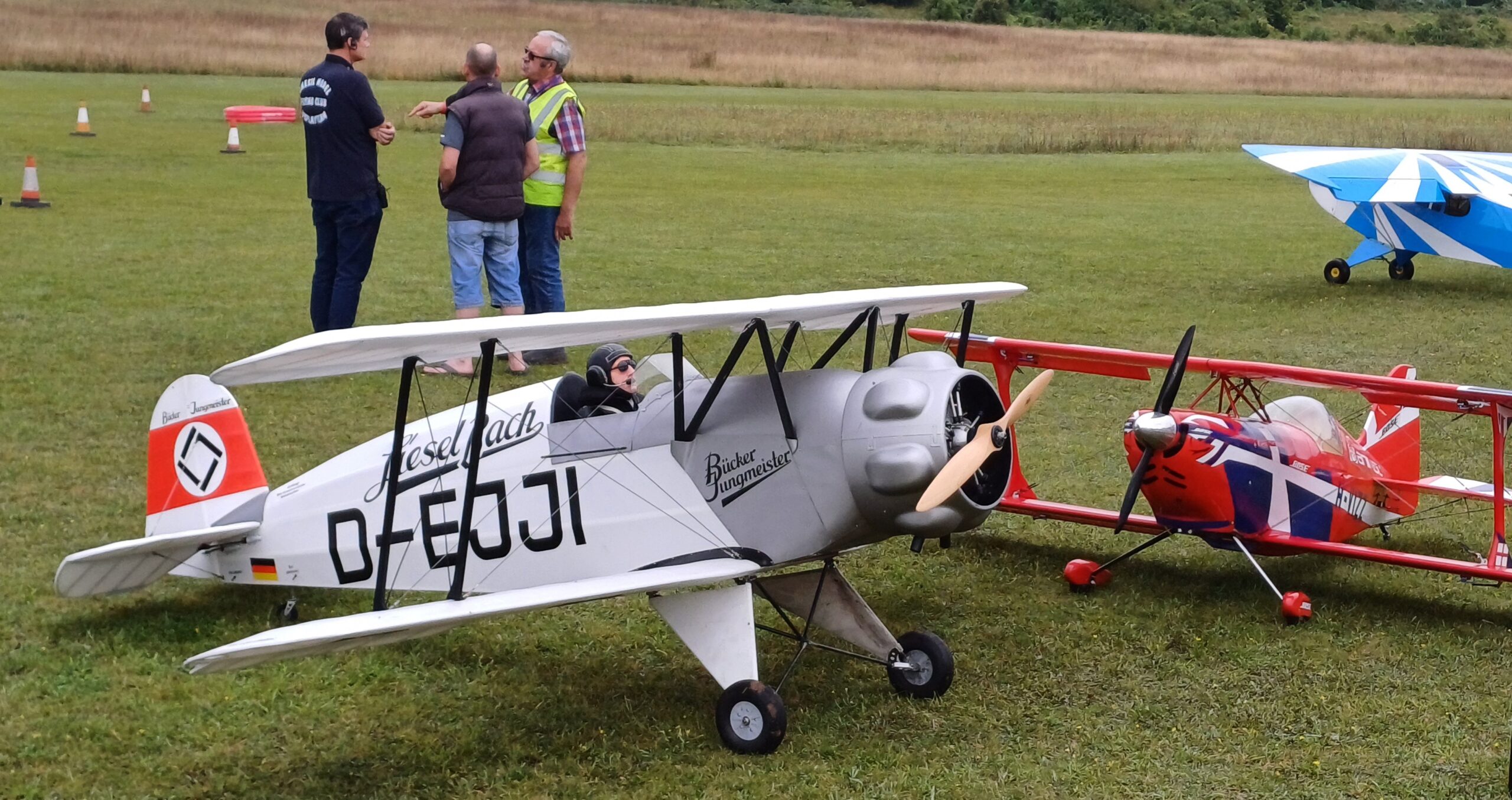
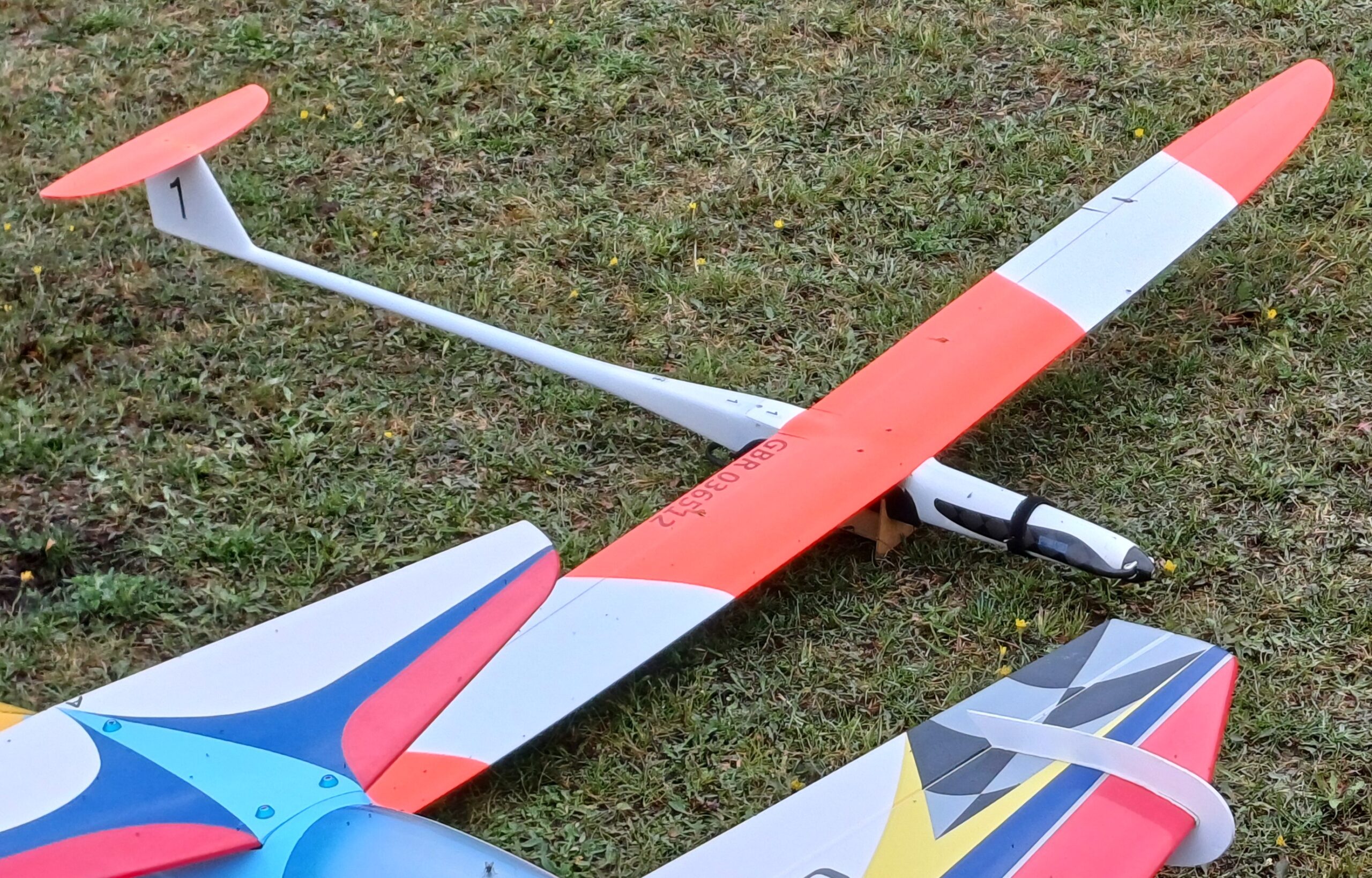

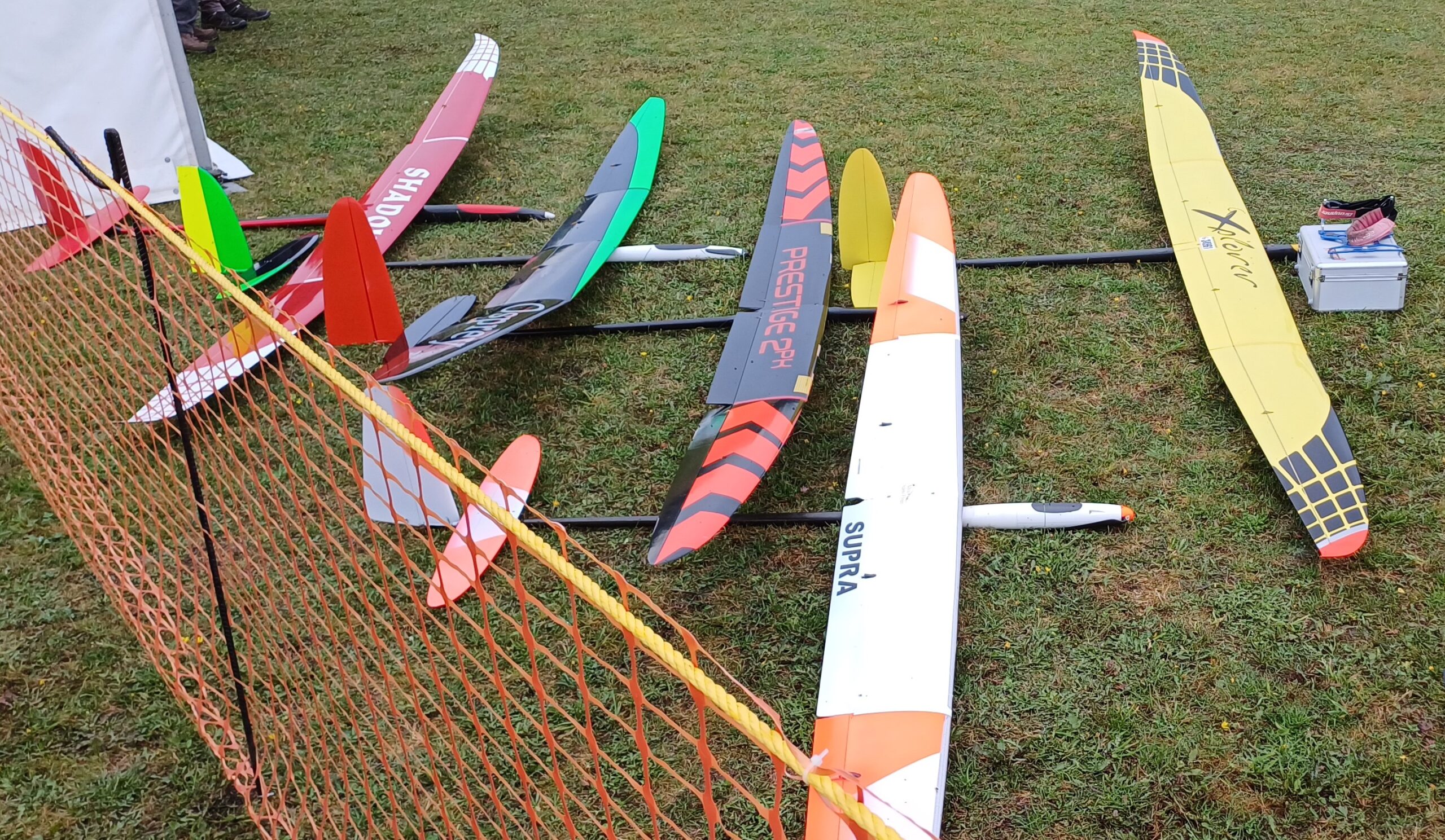
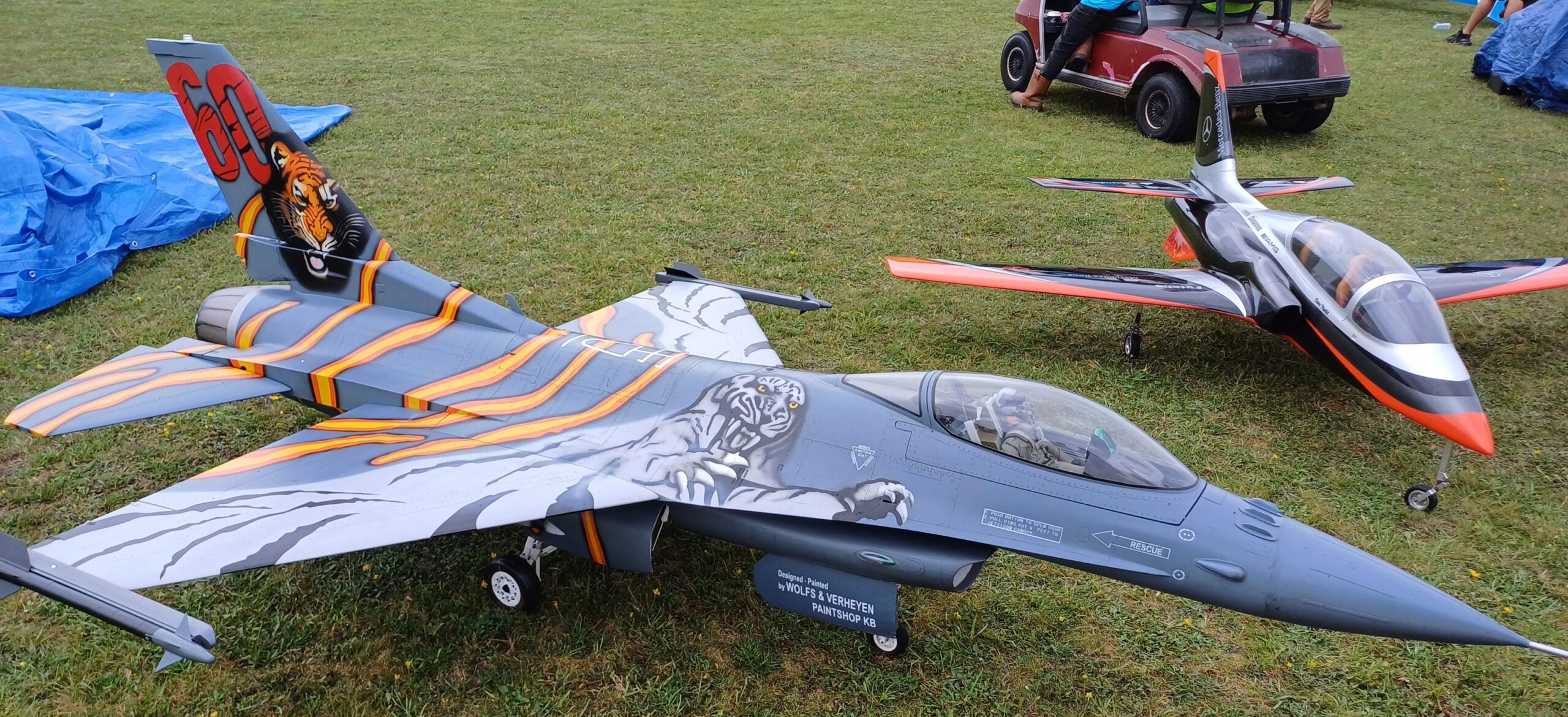
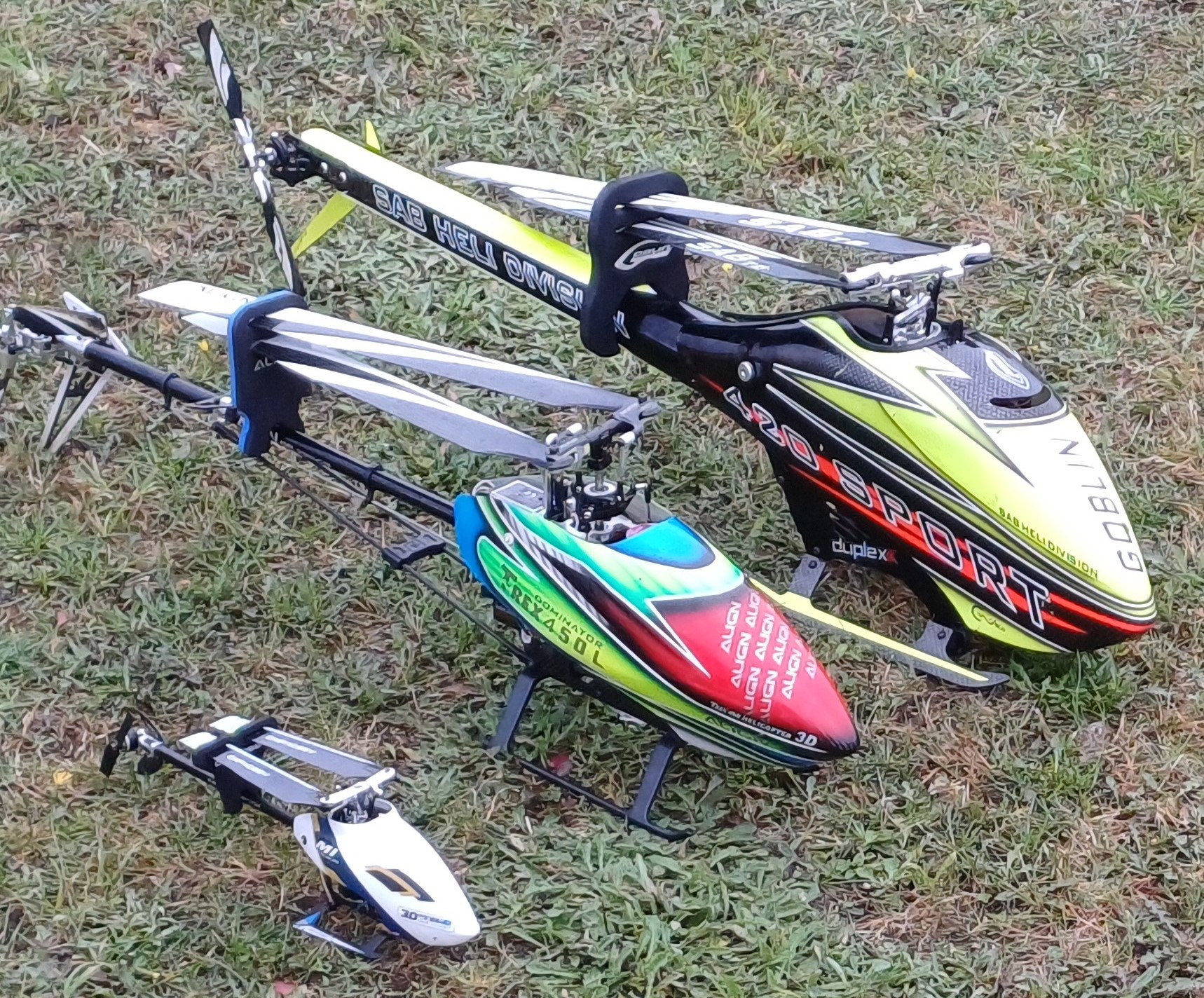 Video time now, this month with footage taken by myself and MacFly. Please watch the video full-screen, it’s so much better with small models flying around:
Video time now, this month with footage taken by myself and MacFly. Please watch the video full-screen, it’s so much better with small models flying around:
If the video won’t play for you please click HERE
This is a supposedly true flight safety announcement from a Southwest Airlines employee:
“Welcome aboard Southwest Flight XX to YY. To operate your seatbelt, insert the metal tab into the buckle, and pull tight. It works just like every other seatbelt, and if you don’t know how to operate one, you probably shouldn’t be out in public unsupervised.
In the event of a sudden loss of cabin pressure, oxygen masks will descend from the ceiling. Stop screaming, grab the mask, and pull it over your face.
If you have a small child traveling with you, secure your mask before helping with theirs. If you are traveling with two small children, decide now which one you love more.”
Colin Cowplain
Patch News – August 2024
I’ve started the last couple of editions of Patch News by complaining about the bad weather and hoping for better next month. And yes, August was very slightly better. We flew regularly but it hasn’t really been a proper summer, just a couple of decent days here and there. But fear not, our Chairman Gordon Bennett is predicting an Indian Summer, get the sunscreen and iced drinks ready! At the start of the month the farmers gave a flock of sheep their annual dipping and they were in ‘our’ field briefly but they were no trouble.
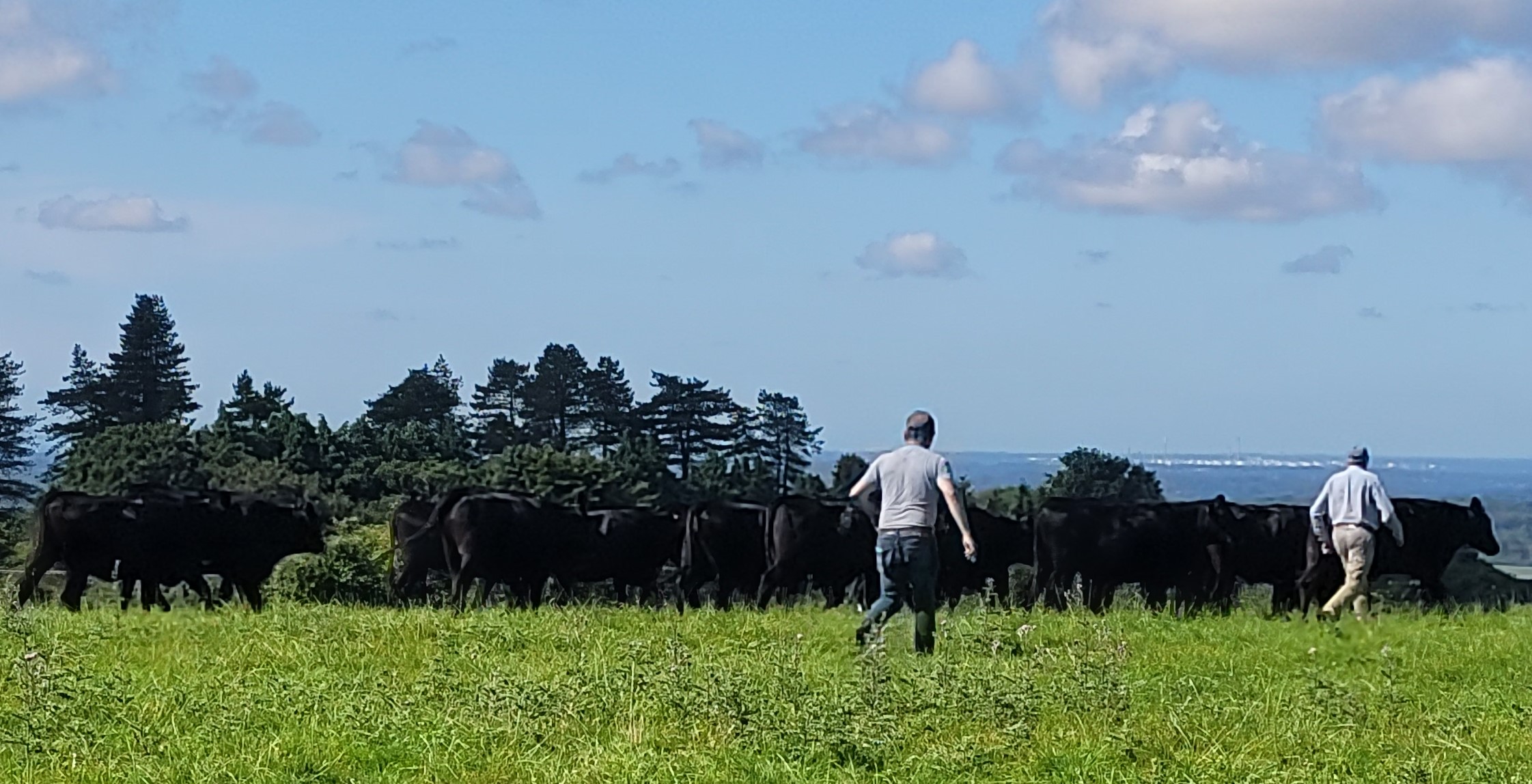 A few days later farmer George said we were looking lonely so he brought along a herd of bullocks to keep us company! Oddly, despite being the young, normally problematic ones they have barely bothered us at all. We have had to gently steer them away from the patch a couple of times but once away they’ve stayed clear for the rest of the flying session.
A few days later farmer George said we were looking lonely so he brought along a herd of bullocks to keep us company! Oddly, despite being the young, normally problematic ones they have barely bothered us at all. We have had to gently steer them away from the patch a couple of times but once away they’ve stayed clear for the rest of the flying session. 
On the last Friday morning session they decided to come to the pits to watch our flying.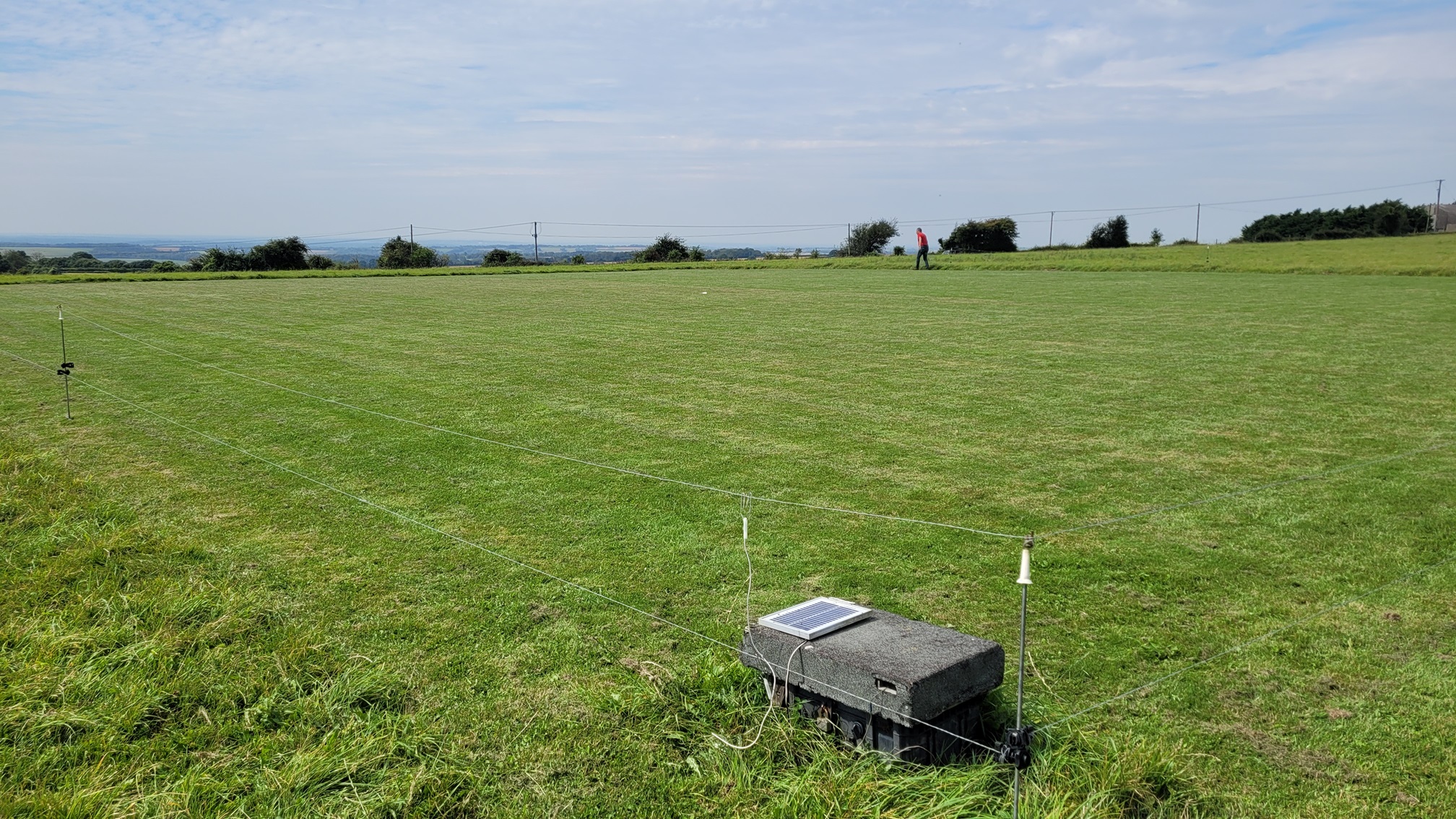 Mowing continued as usual throughout the month and the patch is in good condition.
Mowing continued as usual throughout the month and the patch is in good condition.
Several new models were flown in August, I’ll begin with two from new member Patrick. Patrick is going to need a pseudonym for blog use soon and, as his surname is Beagles it shouldn’t be too difficult to come up with something…Poodle? Answers on a postcard…
 The first of his new models to fly was a HobbyKing Bixler 3. We’ve all seen Bixlers before, they’ve been around for years in various forms and the version 3 doesn’t look to have changed much but apparently it has angular wing and tail surfaces and it’s bigger than the other versions with a wingspan of 1550mm. It also has an uprated 2620 1400kV motor and an easily removable undercarriage. All ARTFs have those, but mostly unintended!
The first of his new models to fly was a HobbyKing Bixler 3. We’ve all seen Bixlers before, they’ve been around for years in various forms and the version 3 doesn’t look to have changed much but apparently it has angular wing and tail surfaces and it’s bigger than the other versions with a wingspan of 1550mm. It also has an uprated 2620 1400kV motor and an easily removable undercarriage. All ARTFs have those, but mostly unintended!
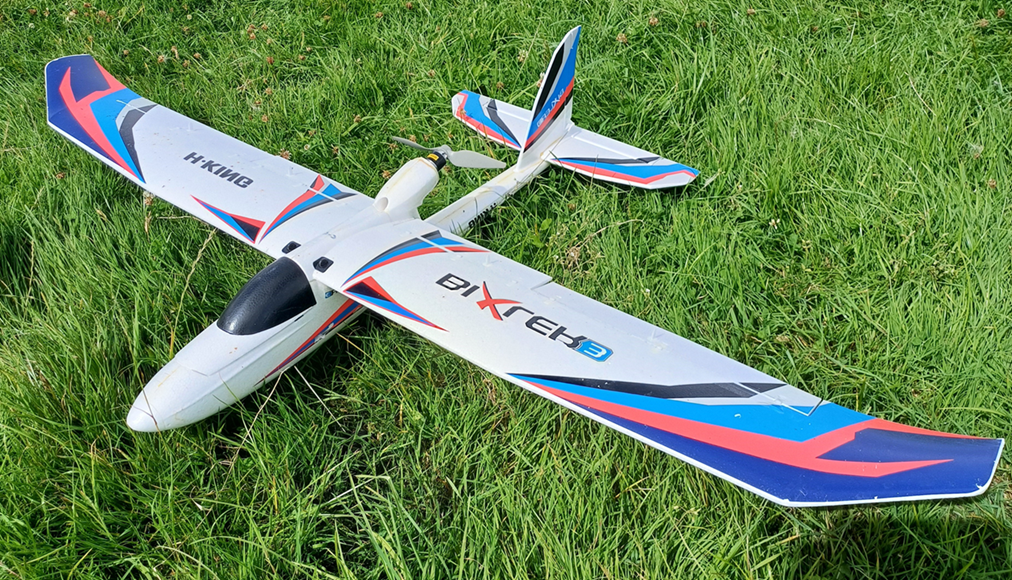 The Bixler comes almost ready to go, fitted with the motor, a 20A speed controller, and 4 x 9g servos so it just needs a receiver and a 3 cell 2200mAh battery. Dougal Entendre did the initial trimming after which he handed the transmitter over to Patrick who flew the Bixler with no problems. Patrick’s second new model is another one from HobbyKing, a Durafly Ugly Stick, identical to the one that Woody has been enjoying flying recently.
The Bixler comes almost ready to go, fitted with the motor, a 20A speed controller, and 4 x 9g servos so it just needs a receiver and a 3 cell 2200mAh battery. Dougal Entendre did the initial trimming after which he handed the transmitter over to Patrick who flew the Bixler with no problems. Patrick’s second new model is another one from HobbyKing, a Durafly Ugly Stick, identical to the one that Woody has been enjoying flying recently.
 The Ugly Stick comes ready fitted with a 3536 900kV motor, a 30A Durafly speed controller, and 4 x 9g servos so, like the Bixler, it just needs a receiver and 3 cell 2200mAh battery to get it flying. And Ugly Sticks fly very well indeed, even Dougal managed to make it look good on the maiden flight! You can see parts of the first flights of both of Patrick’s new models in this month’s video which seems to have turned into The Mini-Mike Movie!
The Ugly Stick comes ready fitted with a 3536 900kV motor, a 30A Durafly speed controller, and 4 x 9g servos so, like the Bixler, it just needs a receiver and 3 cell 2200mAh battery to get it flying. And Ugly Sticks fly very well indeed, even Dougal managed to make it look good on the maiden flight! You can see parts of the first flights of both of Patrick’s new models in this month’s video which seems to have turned into The Mini-Mike Movie!
 A few flights later Patrick managed to break the Ugly Stick slightly but luckily not too drastically and after a few cocktails (by the look of it!) he had it all back in one piece.
A few flights later Patrick managed to break the Ugly Stick slightly but luckily not too drastically and after a few cocktails (by the look of it!) he had it all back in one piece.
Patrick is not alone in breaking a new model and after two Patch News articles on his Fusion build 1066 has written another piece for us about breaking and then repairing it:
We all break models at some point, and we can generally put it down to pilot error, structural or avionics failure. As some may know I recently damaged my new fun-fly model while trying to do fast consecutive touch and goes. The damage was confined to the fuselage, one side had a single crease and the ply doubler had delaminated from the balsa, (poor building here) the other side had two cracks that went through the balsa and ply doubler, all this was within the area of the battery hatch, so the weakest part of the fuselage. This model is not an ARTF (always ready to fail) it is designed with the sole purpose of being competitive in national fun flying competitions. The undercarriage is built like a tank, and is mounted in such a way that it’s impossible for the plane to nose over, the wheels are in front of the propeller, so almost impossible to damage it.
 When you look at the forward sweep of the undercarriage, and the way it is mounted, you can see a lot of thought has gone into reducing and spreading the loads encountered when doing a touch and go. During competition these guys are not waiting for a gentle touch when doing as many as they can in 2 minutes. Taking all the above into account, I was totally confused as to the cause of the damage the model had suffered. Was it pilot error? (YES! Ed) My attempted touch and go was a bit faster, and steeper than optimal, however it was straight into wind, we had just cut the grass, and our patch is not full of holes, so therefore should have been well within the models’ ability. I know I am biased, but I’m claiming no pilot error on this occasion, so it’s got to be structural failure. The repairs were very straightforward, and I have taken the opportunity to stiffen things up around the battery access. It was when I came to refit the undercarriage that everything became clear. The kit is not supplied with any wheels, the ones I used needed the hub opening out to fit the large gauge piano wire axles, and it looks like I went a bit too far.
When you look at the forward sweep of the undercarriage, and the way it is mounted, you can see a lot of thought has gone into reducing and spreading the loads encountered when doing a touch and go. During competition these guys are not waiting for a gentle touch when doing as many as they can in 2 minutes. Taking all the above into account, I was totally confused as to the cause of the damage the model had suffered. Was it pilot error? (YES! Ed) My attempted touch and go was a bit faster, and steeper than optimal, however it was straight into wind, we had just cut the grass, and our patch is not full of holes, so therefore should have been well within the models’ ability. I know I am biased, but I’m claiming no pilot error on this occasion, so it’s got to be structural failure. The repairs were very straightforward, and I have taken the opportunity to stiffen things up around the battery access. It was when I came to refit the undercarriage that everything became clear. The kit is not supplied with any wheels, the ones I used needed the hub opening out to fit the large gauge piano wire axles, and it looks like I went a bit too far.

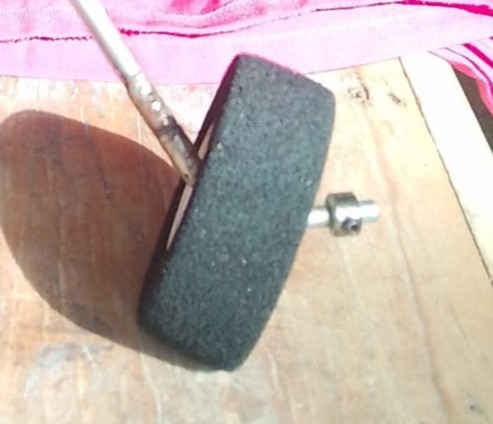 As can be seen in the photos the left hand wheel had locked solid on impact with the ground, probably due to the hub failing and riding up over the bend, and because the undercarriage is so stiff and long this magnified the twisting load applied to the sides of the fuselage. I suppose the moral here is, no matter how good the design, there is always the unforeseen. Thanks 1066, maybe just fit a second collet on the other side of the wheel?
As can be seen in the photos the left hand wheel had locked solid on impact with the ground, probably due to the hub failing and riding up over the bend, and because the undercarriage is so stiff and long this magnified the twisting load applied to the sides of the fuselage. I suppose the moral here is, no matter how good the design, there is always the unforeseen. Thanks 1066, maybe just fit a second collet on the other side of the wheel?
One Sunday morning in August there was a light easterly wind and a couple of paragliders were trying to fly. I say trying because they did manage to get airborne but neither of them was able to gain enough height to stay aloft. A couple of times they each ended up at the bottom of the slope and had to carry their gear back up for the next attempt. We were very wary about flying as they did come along the ridge quite close to us and with just a small change in the wind they may have suddenly appeared in our airspace. Eventually they gave up so we flew but by then it was almost lunchtime. A few MVSA members were also flying but they were no problem to us. When I walked back to my car an MVSA guy arrived and we got chatting, discussing the suitability of the wind for the Sky Surfers, and he told me about a website called Flybubble that the paragliders use and we might find useful:
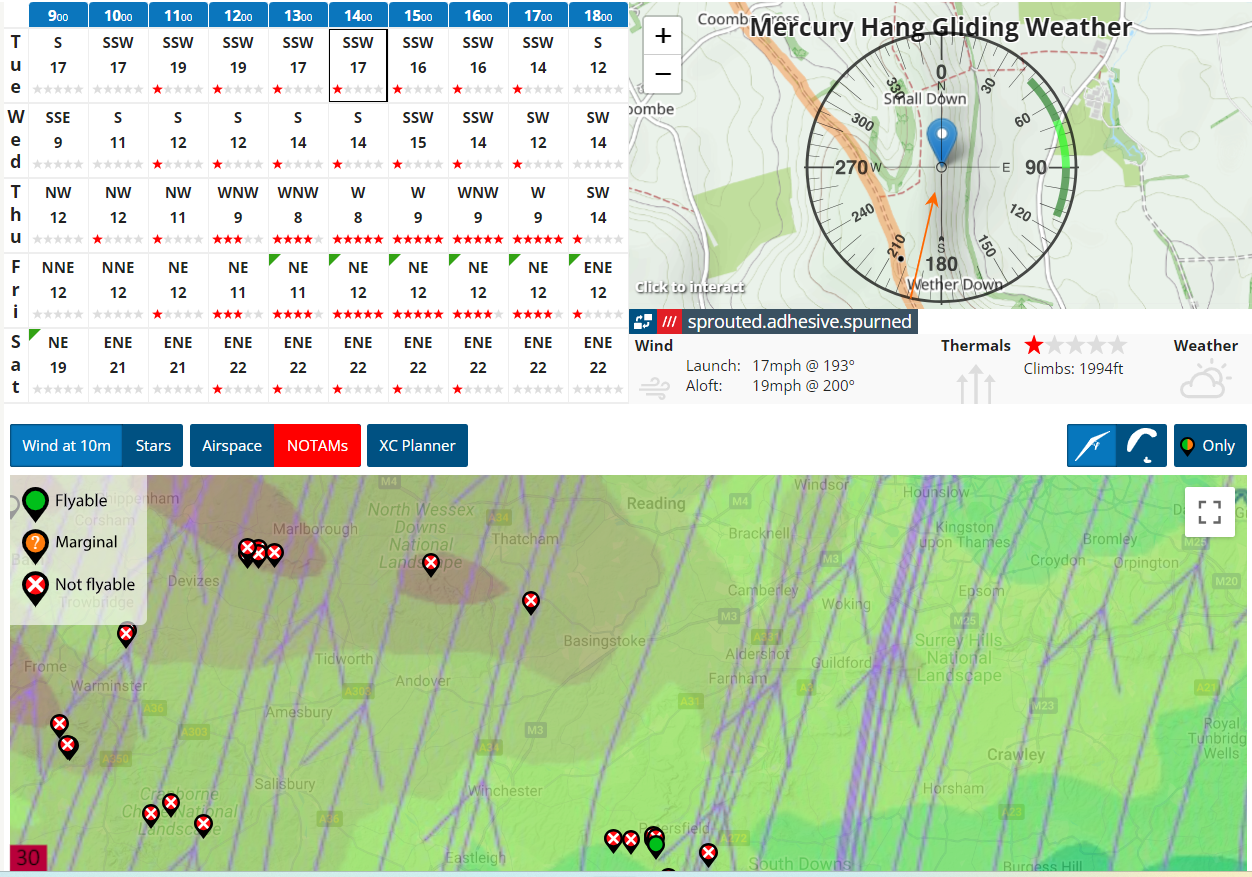 Flybubble is a specialist paragliding and freeflight equipment retailer and distributor and the interesting thing for us is that their website has weather forecasts for paragliding sites right across the country including Mercury where we fly. Their main website is https://flybubble.com which is quite interesting in itself but the one that’s useful to us is https://flybubble.com/weather/mercury-15469#5 Dougal has revamped the PAM website weather page to include the Flybubble link for Mercury, just click on the Weather heading.
Flybubble is a specialist paragliding and freeflight equipment retailer and distributor and the interesting thing for us is that their website has weather forecasts for paragliding sites right across the country including Mercury where we fly. Their main website is https://flybubble.com which is quite interesting in itself but the one that’s useful to us is https://flybubble.com/weather/mercury-15469#5 Dougal has revamped the PAM website weather page to include the Flybubble link for Mercury, just click on the Weather heading.
It’s interesting to note that the BBC forecast seems to give the steady windspeed (not gusts), Holfoy gives the actual speed live plus gust speeds, and Flybubble appears to give the highest speeds, so presumably gusts. At the time I am writing BBC says 11mph, Holfoy 9.9 to 13mph, and Flybubble 16mph. Take your pick, maybe take an average of them all!
Following his Fusion build 1066 has got the building bug and has started on a Dancing Wings Cub. Here’s a little teaser of what’s coming in next month’s exciting instalment! 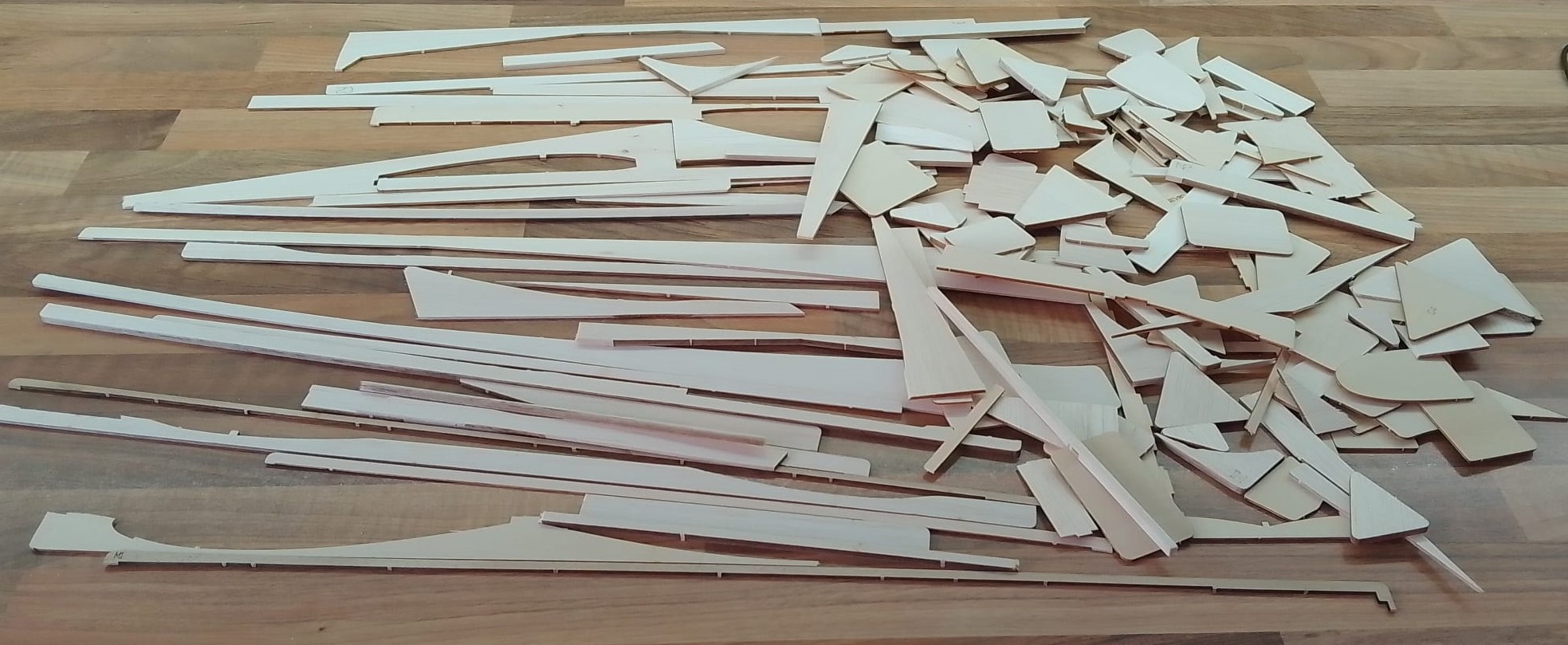
Woody has sold his Max Thrust Riot to Captain Slow as he didn’t really get on with it.
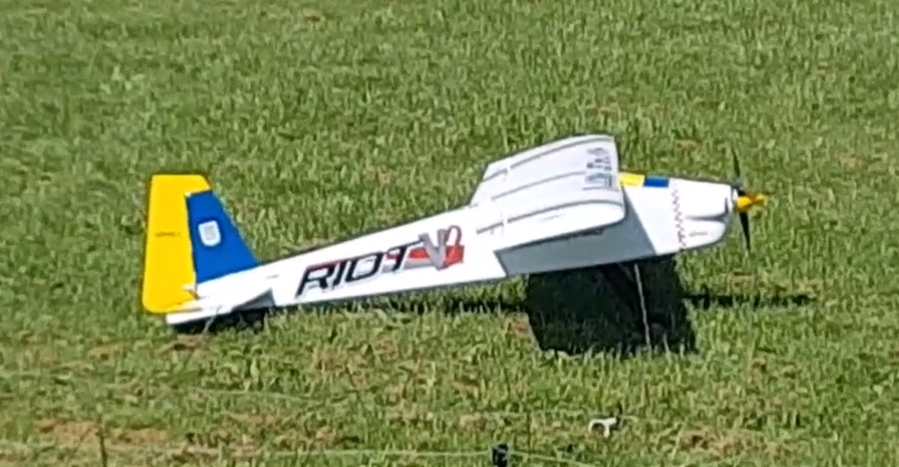 It’s actually a Pro-Built balsa and ply Riot rather than the all foam one and is a lot heavier than the original. I’ve just found an article in RCM&E by Kevin Crozier about the Pro-Built Riot which says it’s 60% heavier than the foam one, surely that can’t be a good thing!
It’s actually a Pro-Built balsa and ply Riot rather than the all foam one and is a lot heavier than the original. I’ve just found an article in RCM&E by Kevin Crozier about the Pro-Built Riot which says it’s 60% heavier than the foam one, surely that can’t be a good thing!
 Captain Slow only had one flight on the day as something was out of balance which made the plane very noisy. He thinks it was the prop driver that wasn’t running quite true so will be sourcing another one and checking everything properly with a dial gauge before he’s happy to fly it again. But it flew fine apart from the noise and it’s in this month’s video.
Captain Slow only had one flight on the day as something was out of balance which made the plane very noisy. He thinks it was the prop driver that wasn’t running quite true so will be sourcing another one and checking everything properly with a dial gauge before he’s happy to fly it again. But it flew fine apart from the noise and it’s in this month’s video.
At the end of the month Captain Slow dug out his Wot Trainer to give prospective new member Terry Small some flights using a buddy box. I’m never quite sure about the model, it’s become known as the club trainer but I believe ownership is actually split between Captain Slow and Woody. It flies on either 3 cells or 4 cells but as it needs weight in the nose it uses either 2 x 3 cell or 2 x 4 cell packs connected in parallel so it only has the voltage of one 3 or 4 cell pack and gets long flights, perfect for a trainer. It was very windy on the day Terry had some flights with the plane but he seemed to be getting the hang of it.
MacFly bought and flew a very nice new model in August, a JP F38 Hornet Delta Racer.
 This is what the J Perkins website says about it: Looking for fast and furious R/C fun? Then you’ve come to the right place. Buckle up, tuck this tantalising F38 under your arm and prepare for a 3S-fuelled thrill that’ll have your clubmates rushing to buy their own. Make sure they get a different colour and enjoy triple the excitement as you go head-to-head in a bout of brute, brushless pylon racing. Packing a powerful pre-fitted 1200KV brushless motor, 30A ESC and supremely capable twin 9g servos, just 30 short minutes is all it takes to get this 3-channel PNP foamie airborne, and 30 seconds to get hooked! Docile, dead easy to launch and furiously fast, the JP F38 Hornet is the perfect all-weather grab ‘n’ go racer. Suitable for any occasion and almost any field, it’s a keeper.
This is what the J Perkins website says about it: Looking for fast and furious R/C fun? Then you’ve come to the right place. Buckle up, tuck this tantalising F38 under your arm and prepare for a 3S-fuelled thrill that’ll have your clubmates rushing to buy their own. Make sure they get a different colour and enjoy triple the excitement as you go head-to-head in a bout of brute, brushless pylon racing. Packing a powerful pre-fitted 1200KV brushless motor, 30A ESC and supremely capable twin 9g servos, just 30 short minutes is all it takes to get this 3-channel PNP foamie airborne, and 30 seconds to get hooked! Docile, dead easy to launch and furiously fast, the JP F38 Hornet is the perfect all-weather grab ‘n’ go racer. Suitable for any occasion and almost any field, it’s a keeper.
Well they certainly seem to like it! And so do I and fortunately MacFly does as well.
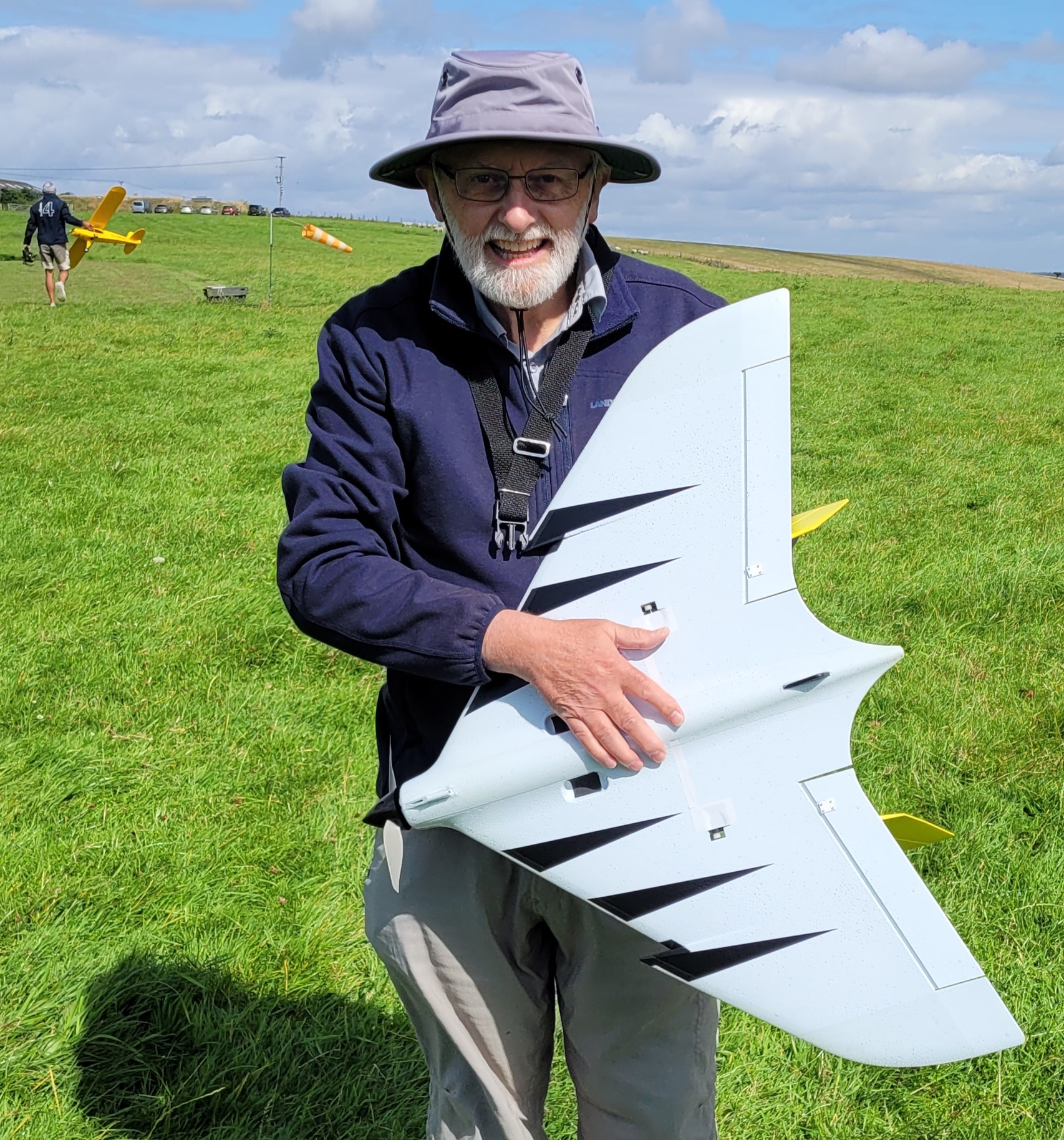 The Hornet is 800mm wingspan and the flying weight is quoted as just 550g so with a 2834 1200kV motor it’s no slouch but I wouldn’t say it’s as fast as the description implies. MacFly asked me to trim it and I found the Hornet good to fly, smooth, responsive, and quick at full throttle but also happy at half throttle and it will slow up nicely for landing.
The Hornet is 800mm wingspan and the flying weight is quoted as just 550g so with a 2834 1200kV motor it’s no slouch but I wouldn’t say it’s as fast as the description implies. MacFly asked me to trim it and I found the Hornet good to fly, smooth, responsive, and quick at full throttle but also happy at half throttle and it will slow up nicely for landing.
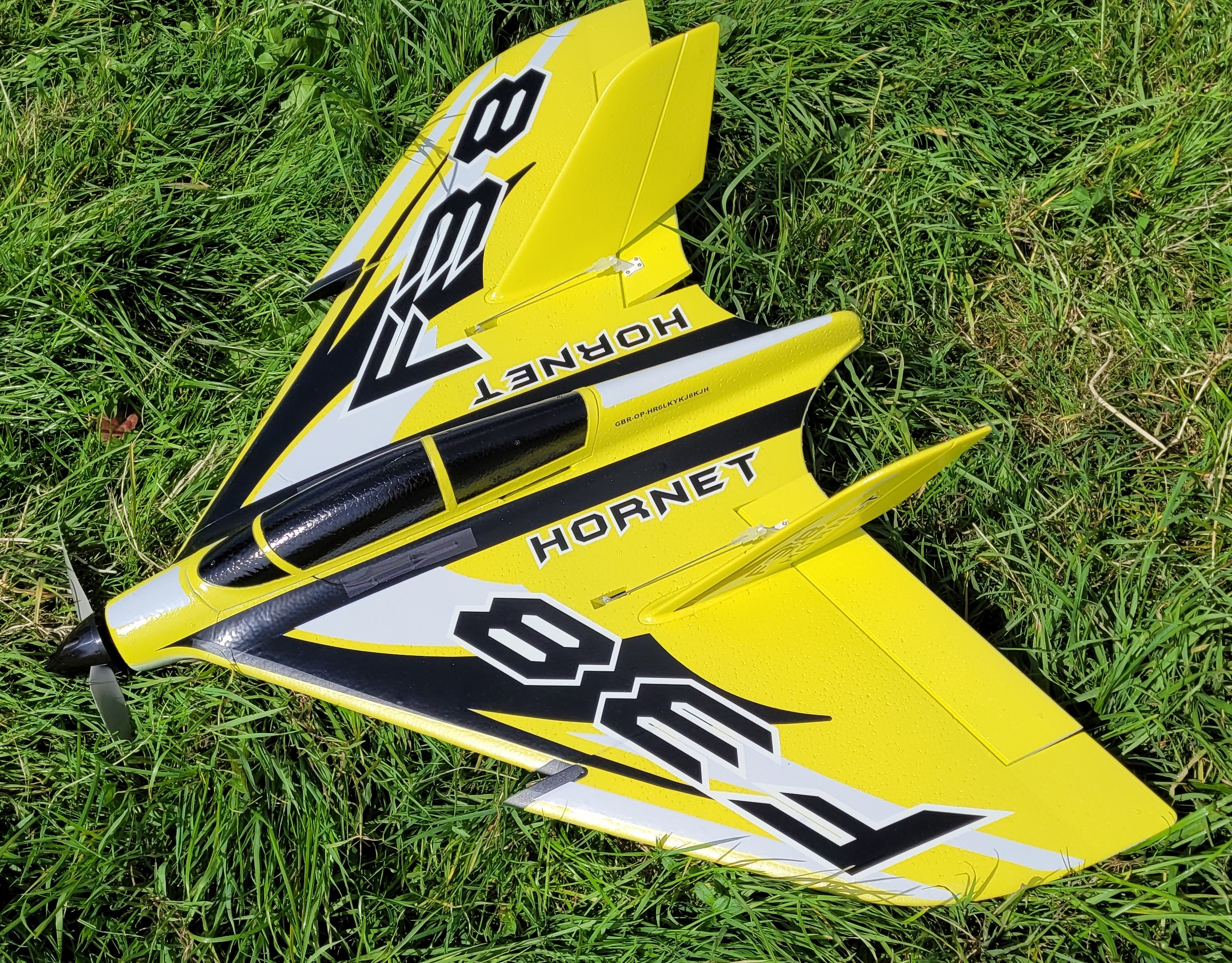 MacFly has been enjoying the Hornet, it’s ideal for our field as it flies in pretty much any weather from the howling January winds to the August…well not quite so howling winds!
MacFly has been enjoying the Hornet, it’s ideal for our field as it flies in pretty much any weather from the howling January winds to the August…well not quite so howling winds!
 The Hornet comes complete with everything except a receiver and battery so MacFly has fitted an FrSky Archer Plus SR10+ combined receiver and stabiliser and he’s using a 3 cell 2000mAh 35C lipo pack. He’s had a couple of ‘interesting moments’ with the plane, the second one when he decided to switch the stabiliser from the Stabilisation mode which damps out wind buffeting to Automatic Level which, as the name implies, should instantly bring the model to level flight. MacFly isn’t sure what went wrong but it seemed to roll the Hornet inverted (even though he’s sure it was set correctly) and in the race to switch back to Stabilisation he lost and gravity won. A replacement airframe is already on order…
The Hornet comes complete with everything except a receiver and battery so MacFly has fitted an FrSky Archer Plus SR10+ combined receiver and stabiliser and he’s using a 3 cell 2000mAh 35C lipo pack. He’s had a couple of ‘interesting moments’ with the plane, the second one when he decided to switch the stabiliser from the Stabilisation mode which damps out wind buffeting to Automatic Level which, as the name implies, should instantly bring the model to level flight. MacFly isn’t sure what went wrong but it seemed to roll the Hornet inverted (even though he’s sure it was set correctly) and in the race to switch back to Stabilisation he lost and gravity won. A replacement airframe is already on order…
For the action shots this month I’ve been looking back through some very old photos: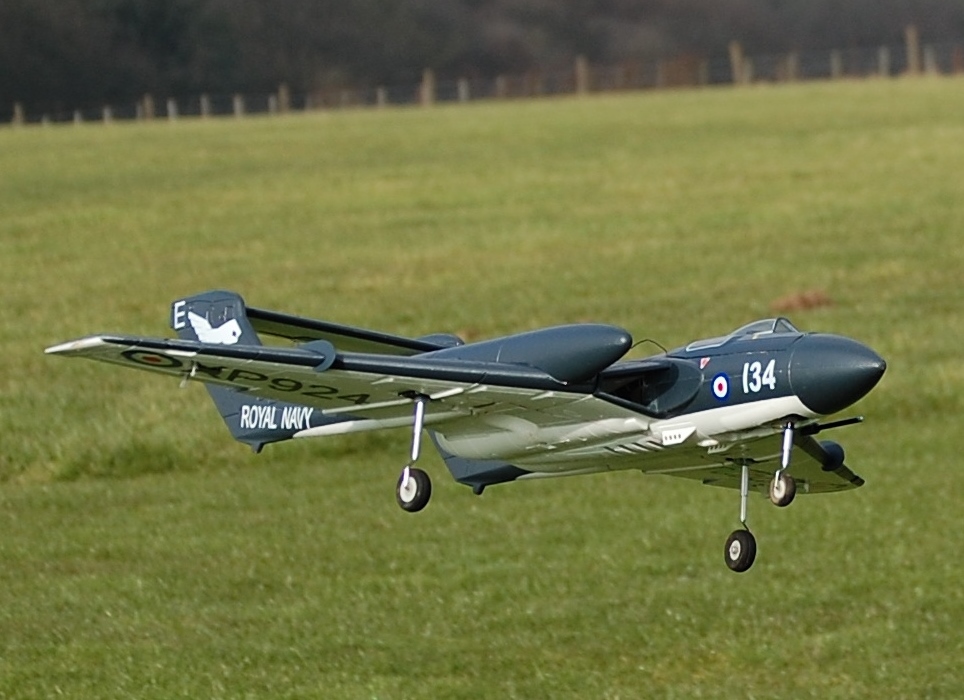

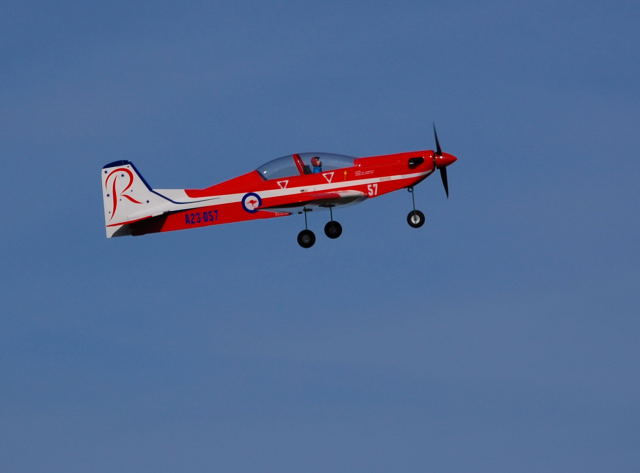
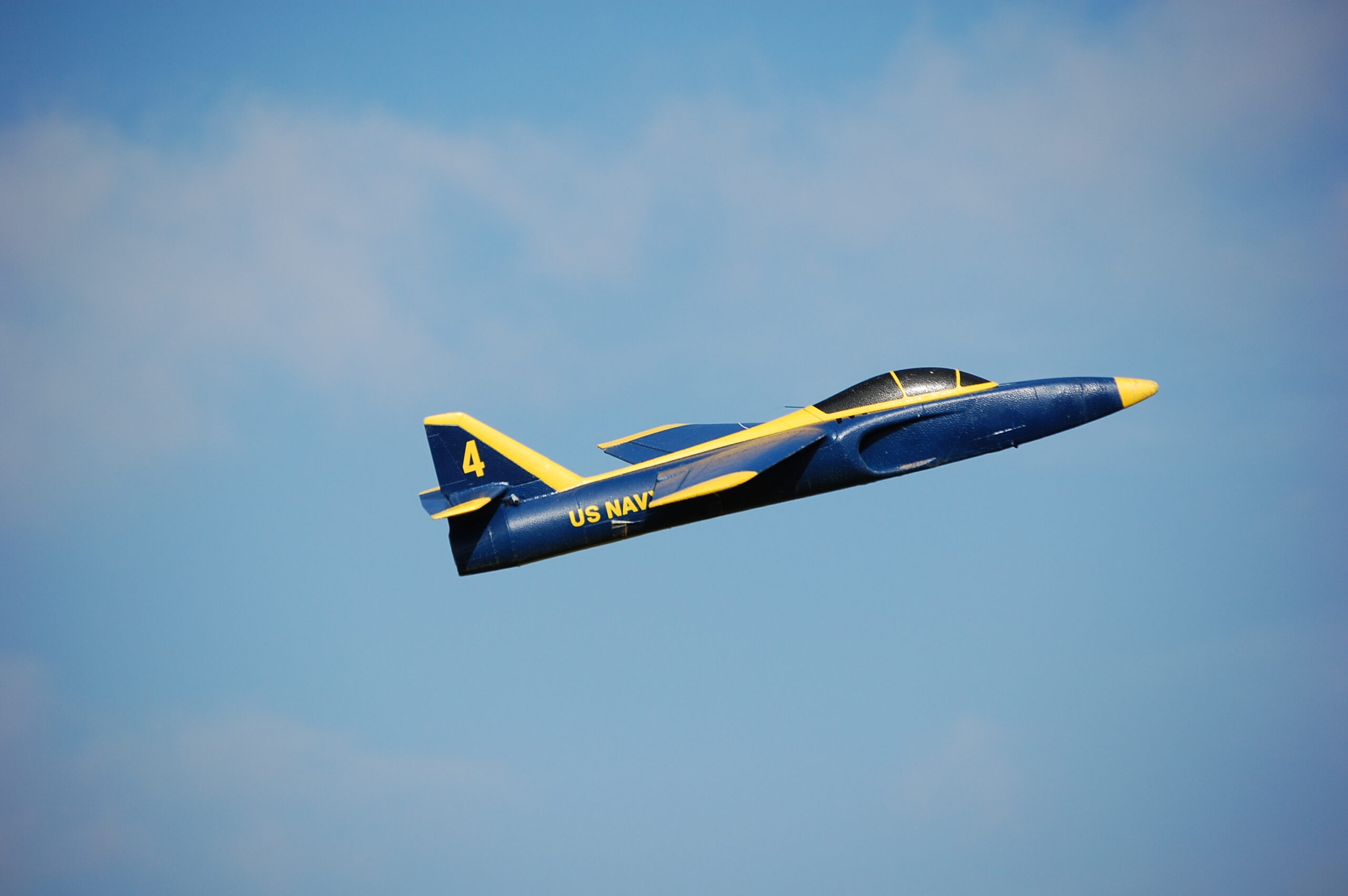
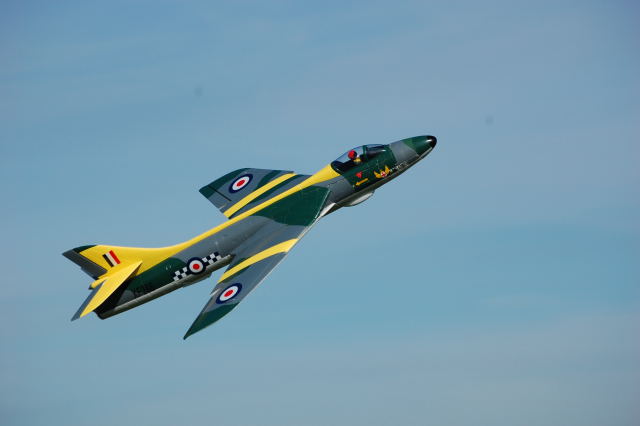
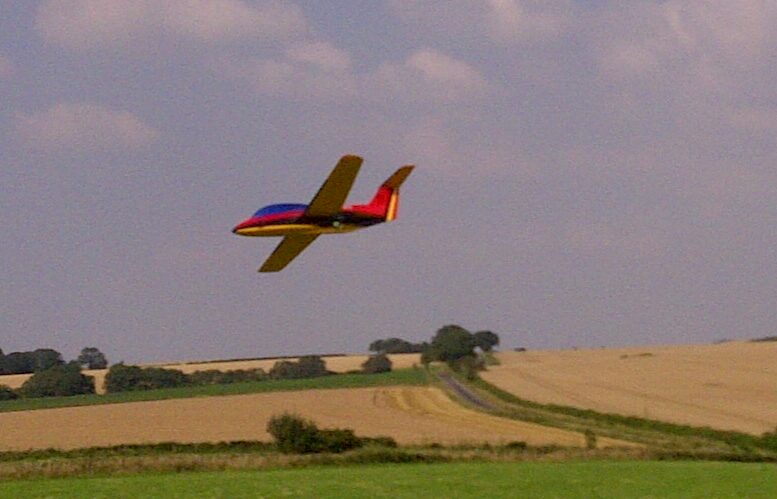
Video time now this month with footage taken by myself, Dougal, and mostly by MacFly.
Please watch the video full-screen, it’s so much better with small models flying around:
If the video won’t play for you please click HERE
Boarding an airliner for the first time, Sharon sat in a window seat in a quiet area.
A man came over and politely said, “Excuse me madam, I think you’re in my seat.”
But being totally unaware of the correct aircraft seating arrangements Sharon replied “Tough, just go away and find yourself another seat!”
He said, “Okay, fine, you fly the plane.”
Colin Cowplain
Patch News – July 2024
I started the last Patch News by saying summer had finally arrived. Well I got that wrong! We did have some brief spells of summery weather in July but also a lot of terrible days and record rainfall. Mowing continued as usual, mostly by the Friday fliers but on Fri 19th only Woody turned up (several away on holiday) so he mowed alone. Gold star for Woody!
The last few days of the month were hot and sunny, just as July should be so maybe August will be better, fingers crossed. Despite the poor weather there were some highlights with several new models being flown and Dwayne Pipe successfully ran the annual chuck glider competition which is always a popular event but more on that later.
When we first moved to our new field late last year there were a few concerns about interference from the nearby radio masts. These concerns proved to be groundless and there have been no problems with our transmitters using 2.4GHz. But when flying FPV (First Person View) the system uses 5.8GHz so as a test Dougal Entendre flew his FPV model between the masts last month and experienced no problems as all. I was slightly jealous that he’s done it before me so in early July I flew my FPV model between the masts in the opposite direction, from east to west. Like Dougal, there were no problems at all.
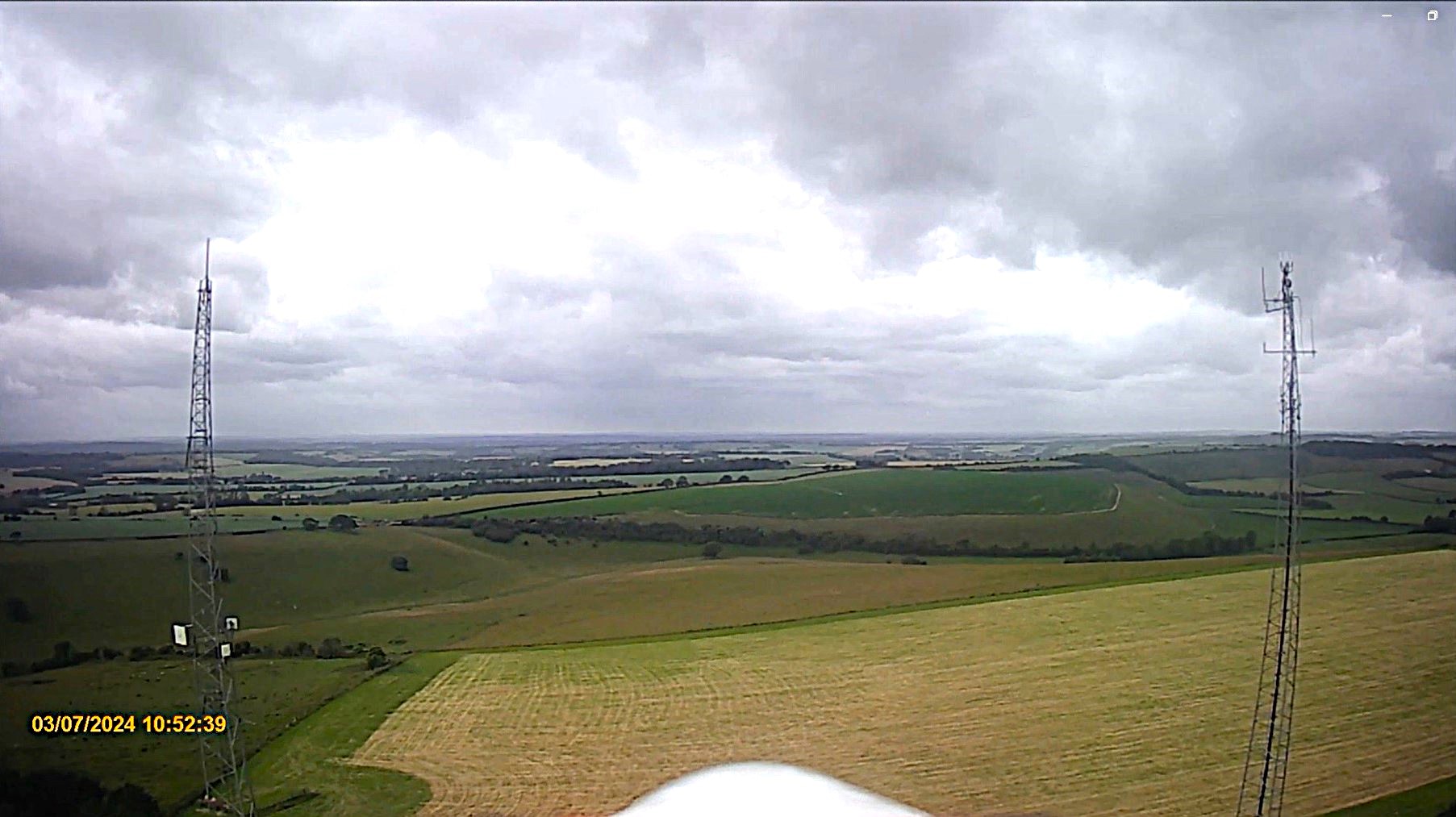 The farmer has told us that sometime this summer both masts will be replaced by a single larger one so I suppose the concerns will return until we’ve satisfied ourselves that there are no problems. First person to fly FPV around the new mast Dougal?
The farmer has told us that sometime this summer both masts will be replaced by a single larger one so I suppose the concerns will return until we’ve satisfied ourselves that there are no problems. First person to fly FPV around the new mast Dougal?
In June I asked the name of this plane that I’d seen at the RAF Manston History Museum:
Nobody even had a guess so I’ll tell you, it’s a PZL TS-11 Iskra. I’ve never heard of it either!
So this month the quiz is to name this electric model. Rod Ashton received it as part of a lot of stuff he’s received from the widow of an aeromodelling friend. Nobody he has asked so far has a clue what it is so start searching, Rod would really like to know it’s name: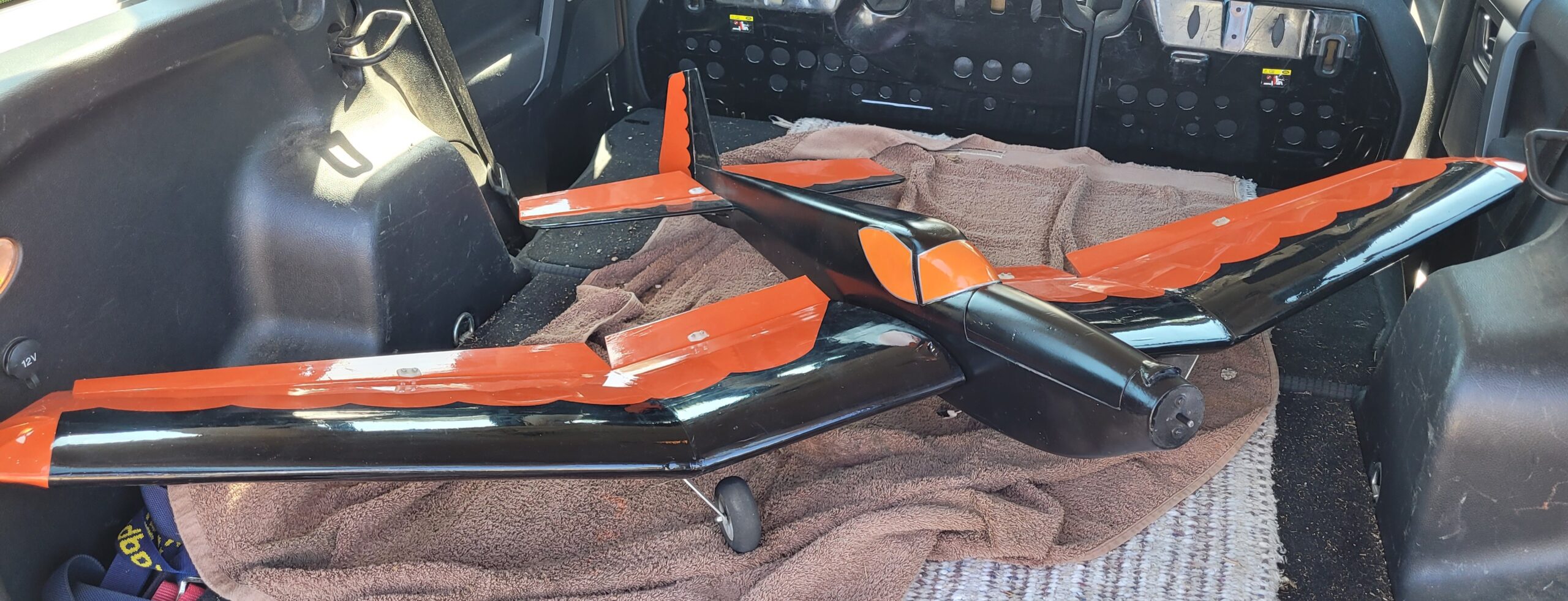
In May I featured Part 1 of 1066’s Fusion V2 build. It’s now flown so here’s Part 2:
By the time this makes the blog, the Fusion will have been flown, but having sent Colin some build photos in June we both thought some views on the build may be of interest. After building all the tail I moved on to the fin, rudder, and ailerons. Having built two kits this year I have noticed you have to be very careful with how you use the strip material supplied. On this build I only wasted 15 mm on each length of the 9mm x 6mm strip supplied for all the cross bracing, but still managed to run out.
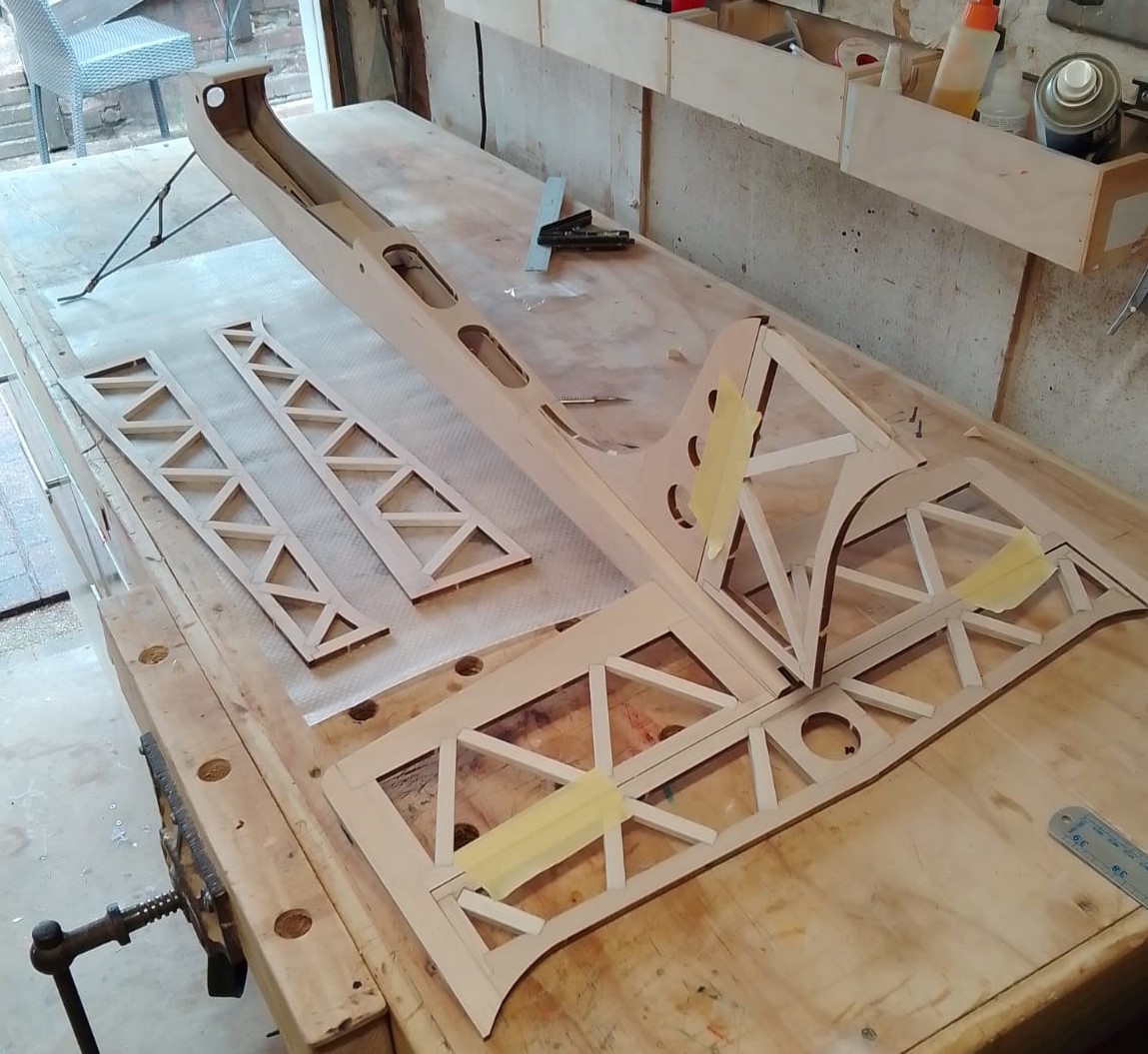 Next came the fuselage, this was a very straightforward tapered box that went together very easily, and made for a very rigid structure, however me being me, I can’t resist a mod or two. I don’t like band on wings so I decided to change to a bolt on fixing. I also prefer using self-tapping screws for fixing motors, so I added an extra 6mm ply firewall.
Next came the fuselage, this was a very straightforward tapered box that went together very easily, and made for a very rigid structure, however me being me, I can’t resist a mod or two. I don’t like band on wings so I decided to change to a bolt on fixing. I also prefer using self-tapping screws for fixing motors, so I added an extra 6mm ply firewall. 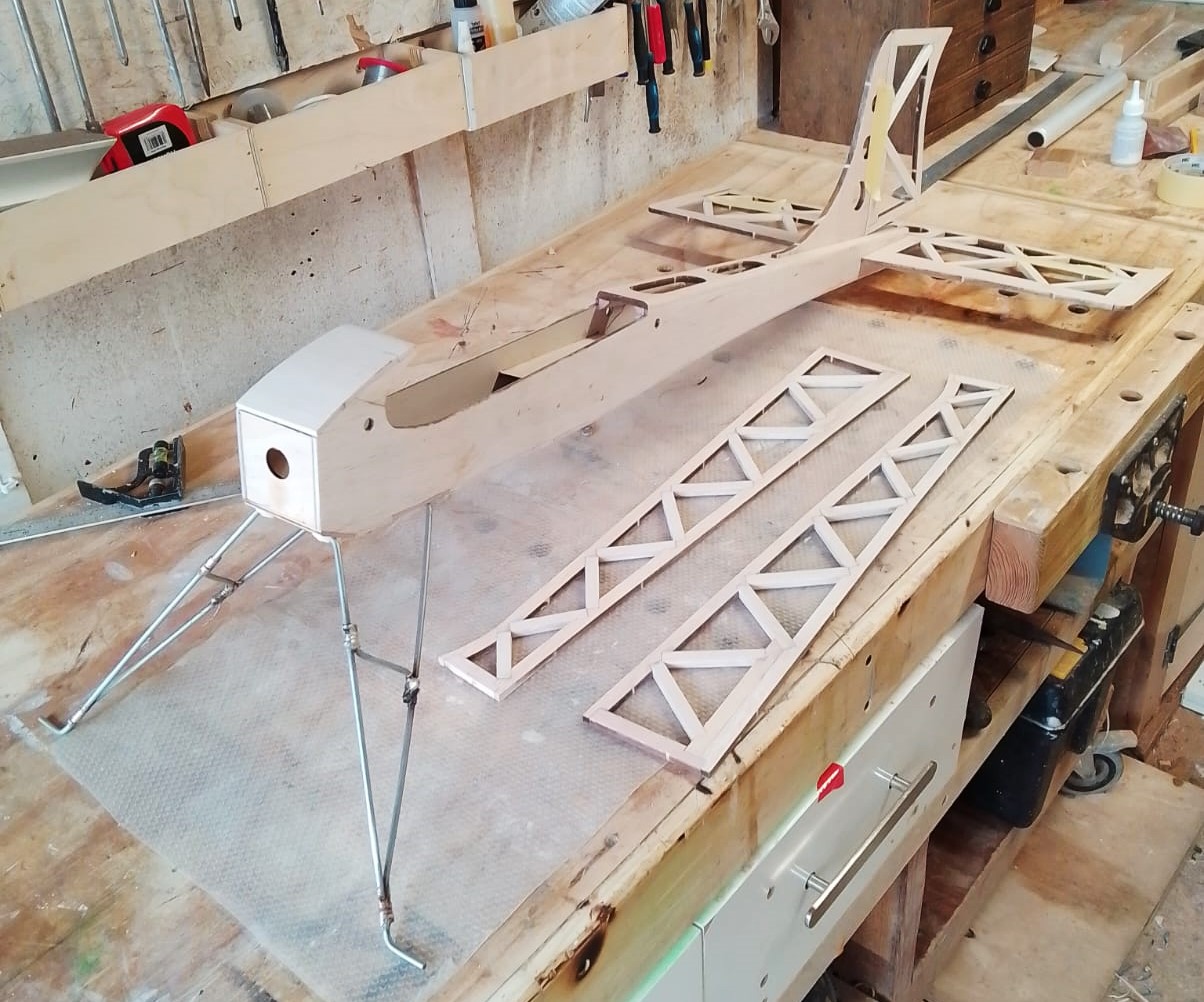 Next up was soldering the four parts of the undercarriage together, the instructions show this being done on a jig, but I preferred to do it with the parts fitted to the fuselage.
Next up was soldering the four parts of the undercarriage together, the instructions show this being done on a jig, but I preferred to do it with the parts fitted to the fuselage.
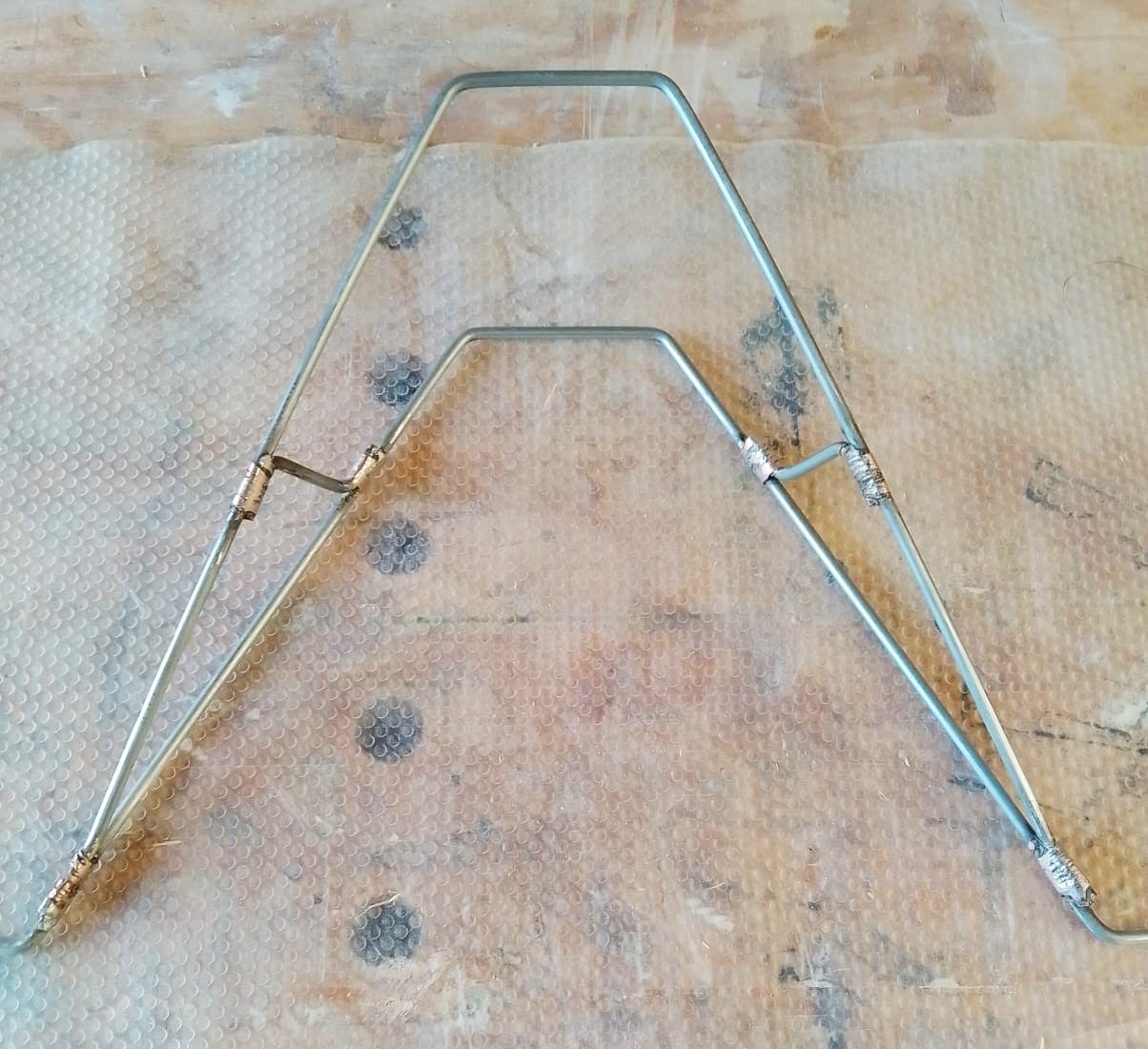 I now moved on to the wing assembly, and this is where things went a bit wrong!! With the wing pinned down, the structure was started in the normal order, see photos.
I now moved on to the wing assembly, and this is where things went a bit wrong!! With the wing pinned down, the structure was started in the normal order, see photos.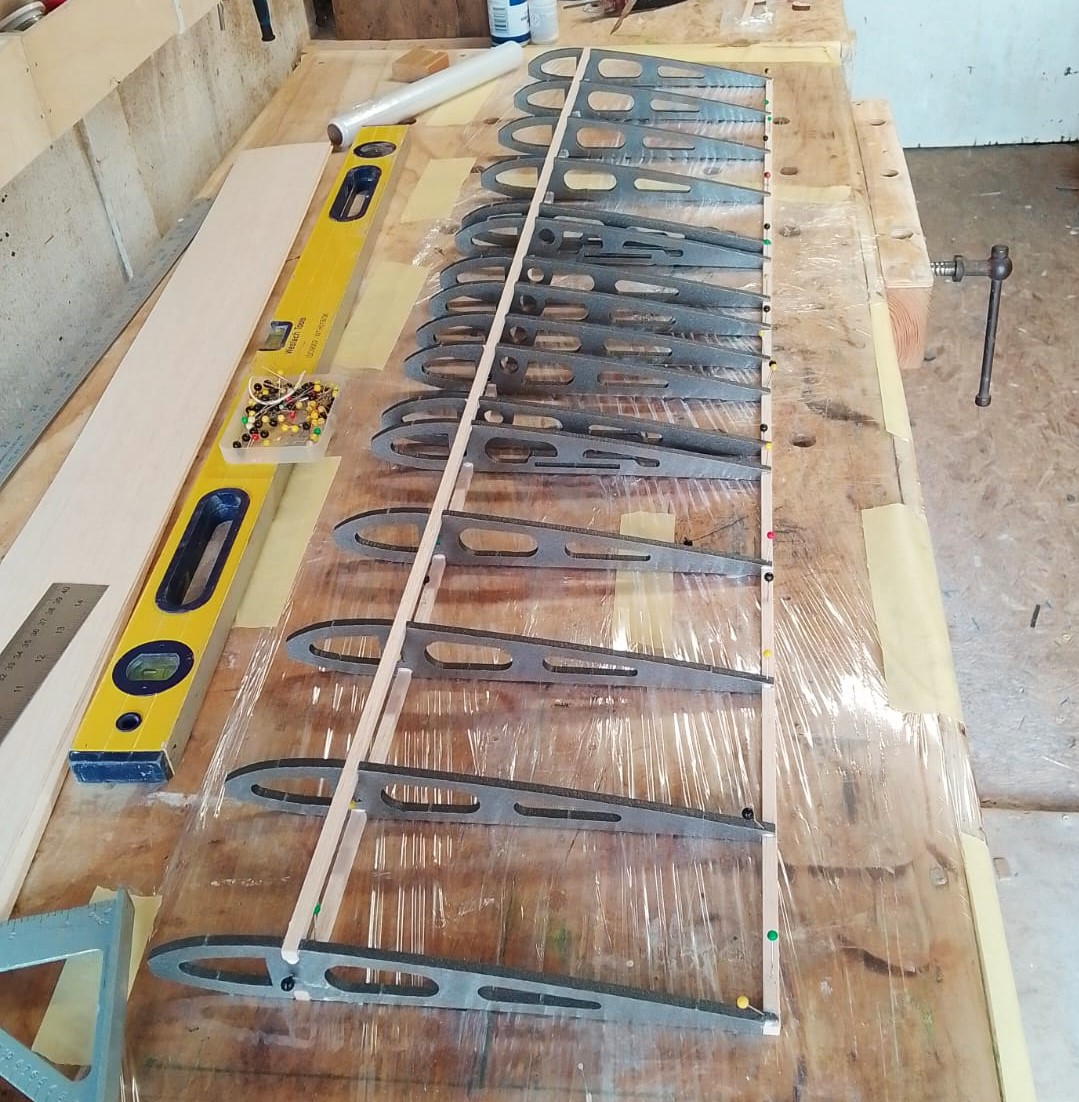
With all the ribs, and spars in place, the instructions give the dimensions for the webbing pieces to be fitted to the front edge of the top and bottom spars, I cut one and offered it up (see photo) and as you can see it was far too tall. All the rest were marked and cut in situ. Next the instructions tell you to chamfer the leading edge stock to follow the curve of the top and bottom of the aerofoil before fixing to the front of the ribs, this sounded a bit tricky so I decided to butt join it to the leading edge after the sheeting had been fitted.
Next the instructions tell you to chamfer the leading edge stock to follow the curve of the top and bottom of the aerofoil before fixing to the front of the ribs, this sounded a bit tricky so I decided to butt join it to the leading edge after the sheeting had been fitted.
 The instructions also tell you to cut the supplied 100mm sheet into 2 pieces one 80 mm wide for leading edge and the remaining 20mm piece for the trailing edge, which I did. However, if I had followed the leading edge instructions, the leading edge sheet would be too narrow. The next issue I faced was that the Depron ribs would not hold the pins for fixing the leading-edge sheet even after wetting. With the glue already applied, I had to rely on a lot of house bricks, and a straight edge to hold it in place.
The instructions also tell you to cut the supplied 100mm sheet into 2 pieces one 80 mm wide for leading edge and the remaining 20mm piece for the trailing edge, which I did. However, if I had followed the leading edge instructions, the leading edge sheet would be too narrow. The next issue I faced was that the Depron ribs would not hold the pins for fixing the leading-edge sheet even after wetting. With the glue already applied, I had to rely on a lot of house bricks, and a straight edge to hold it in place.
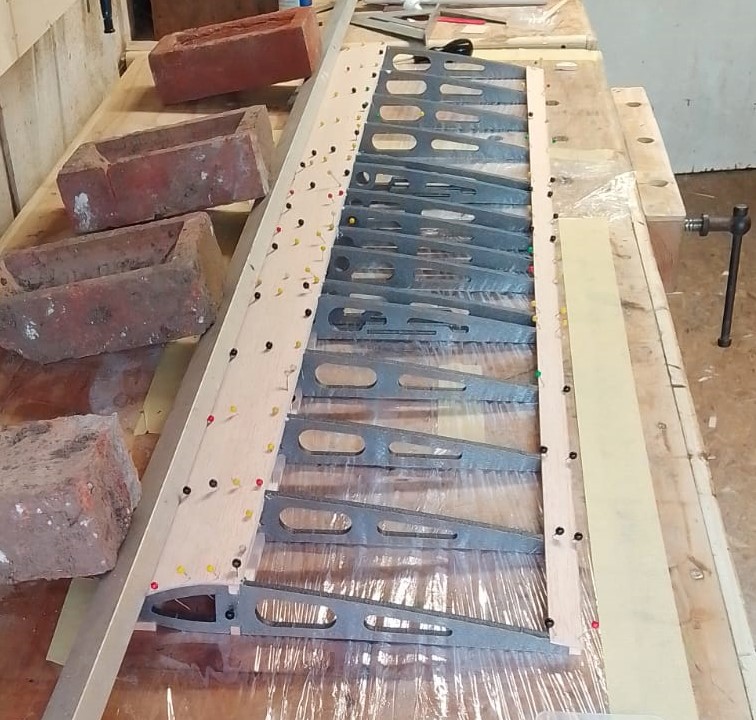
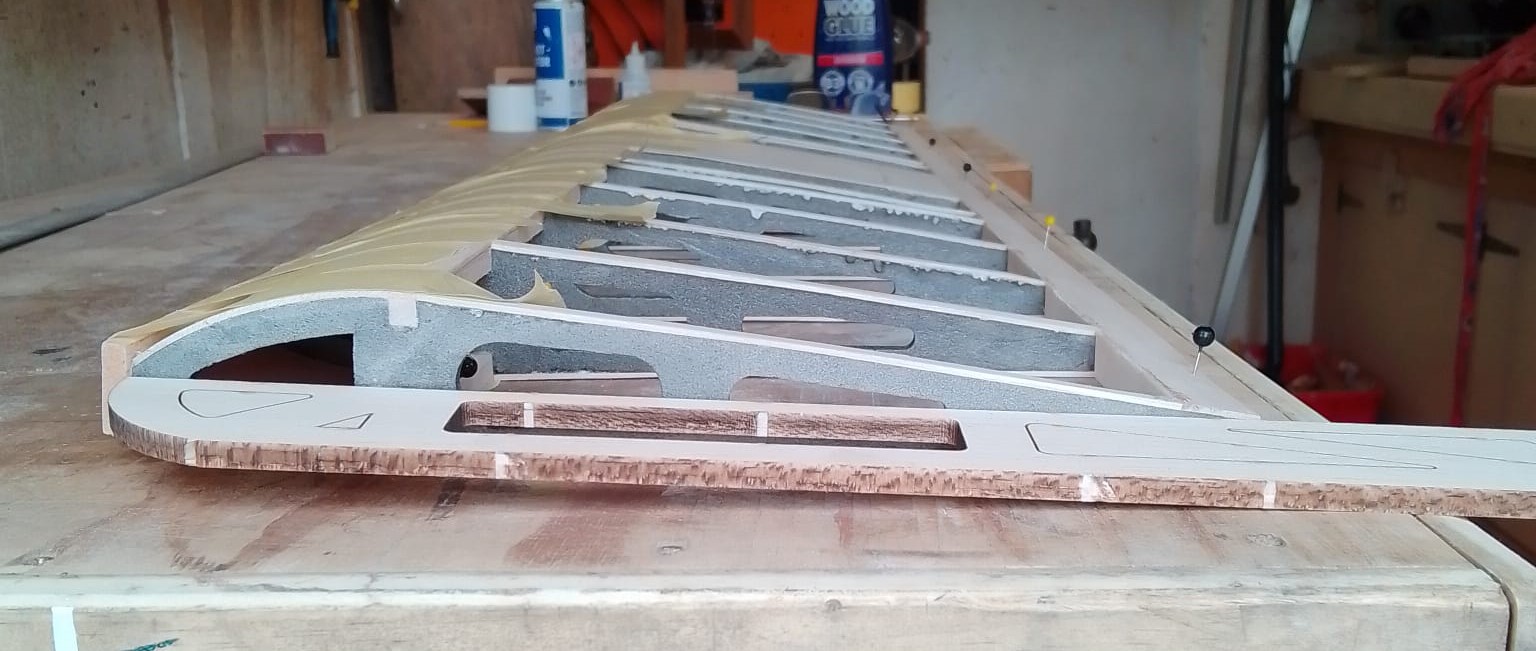 All the top sheeting was completed, but when it came to fitting the rib capping the material supplied was supposed to be the same thickness as the rest of the sheet but it was visibly thinner which made sanding more difficult than it should have been.
All the top sheeting was completed, but when it came to fitting the rib capping the material supplied was supposed to be the same thickness as the rest of the sheet but it was visibly thinner which made sanding more difficult than it should have been.
The wing was now turned over, pinned back onto the bench and all the bottom sheeting added. With all the glue dry and the wing off the bench I felt that the trailing edge seemed very unstable, with poor torsional strength, and over the next few days it developed a very visible bow (see photo).
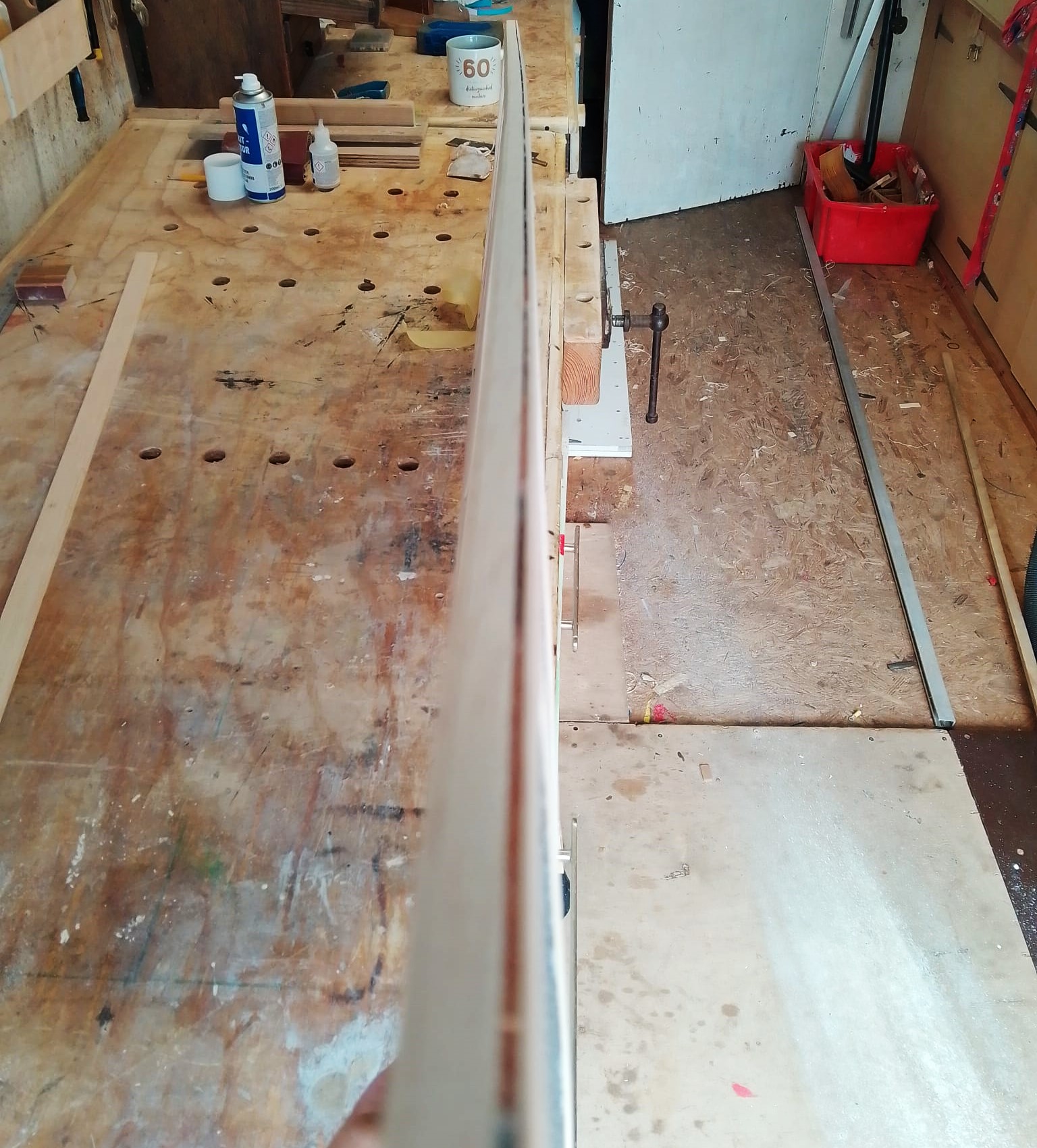 So it was all pinned down again, webbing added to the front of the trailing edge sheeting, and a 6mm x 4mm extra trailing edge fitted, which seemed to sort things out.
So it was all pinned down again, webbing added to the front of the trailing edge sheeting, and a 6mm x 4mm extra trailing edge fitted, which seemed to sort things out. 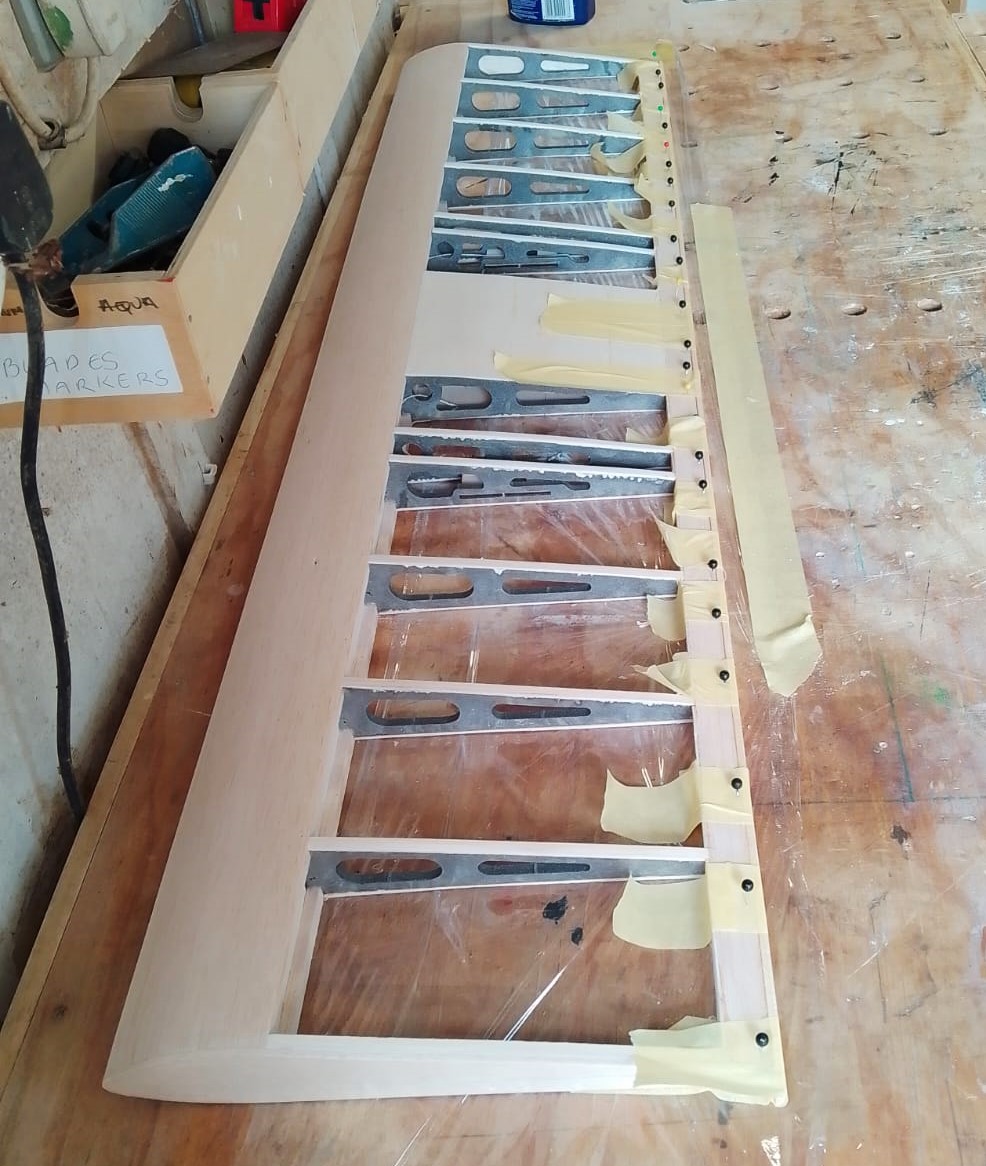 My next concern was the fixing of the large wing tips, I was not happy with fixing them directly to the Depron ribs so I added some thin balsa sheet, and braces to make a much stronger assembly (see photo).
My next concern was the fixing of the large wing tips, I was not happy with fixing them directly to the Depron ribs so I added some thin balsa sheet, and braces to make a much stronger assembly (see photo).
 With all the components completed I did a dry assembly to check alignments etc. The next issue to come to light was the poor fit of the leading edge in the fuselage (see photo) which had me very puzzled as all the parts were laser cut!
With all the components completed I did a dry assembly to check alignments etc. The next issue to come to light was the poor fit of the leading edge in the fuselage (see photo) which had me very puzzled as all the parts were laser cut!
 Plus, the wing has a small under camber which was not reflected on the wing seat. When I build any model I always check the wing and tail incidences with a basic meter, on this occasion it showed the tail was set at a positive angle when compared to the wing! A few hours of filling, sanding, and reshaping resolved all of the above issues.
Plus, the wing has a small under camber which was not reflected on the wing seat. When I build any model I always check the wing and tail incidences with a basic meter, on this occasion it showed the tail was set at a positive angle when compared to the wing! A few hours of filling, sanding, and reshaping resolved all of the above issues.
 The rest of the build, covering, and gear installation was straightforward, but I still changed a few things. The instructions call for the ESC to be fitted outside of the fuselage, between the undercarriage legs, but I wanted it inside, which was easier said than done. All surfaces are top hinged, elevator control is via a closed loop, instead of a pushrod.
The rest of the build, covering, and gear installation was straightforward, but I still changed a few things. The instructions call for the ESC to be fitted outside of the fuselage, between the undercarriage legs, but I wanted it inside, which was easier said than done. All surfaces are top hinged, elevator control is via a closed loop, instead of a pushrod.

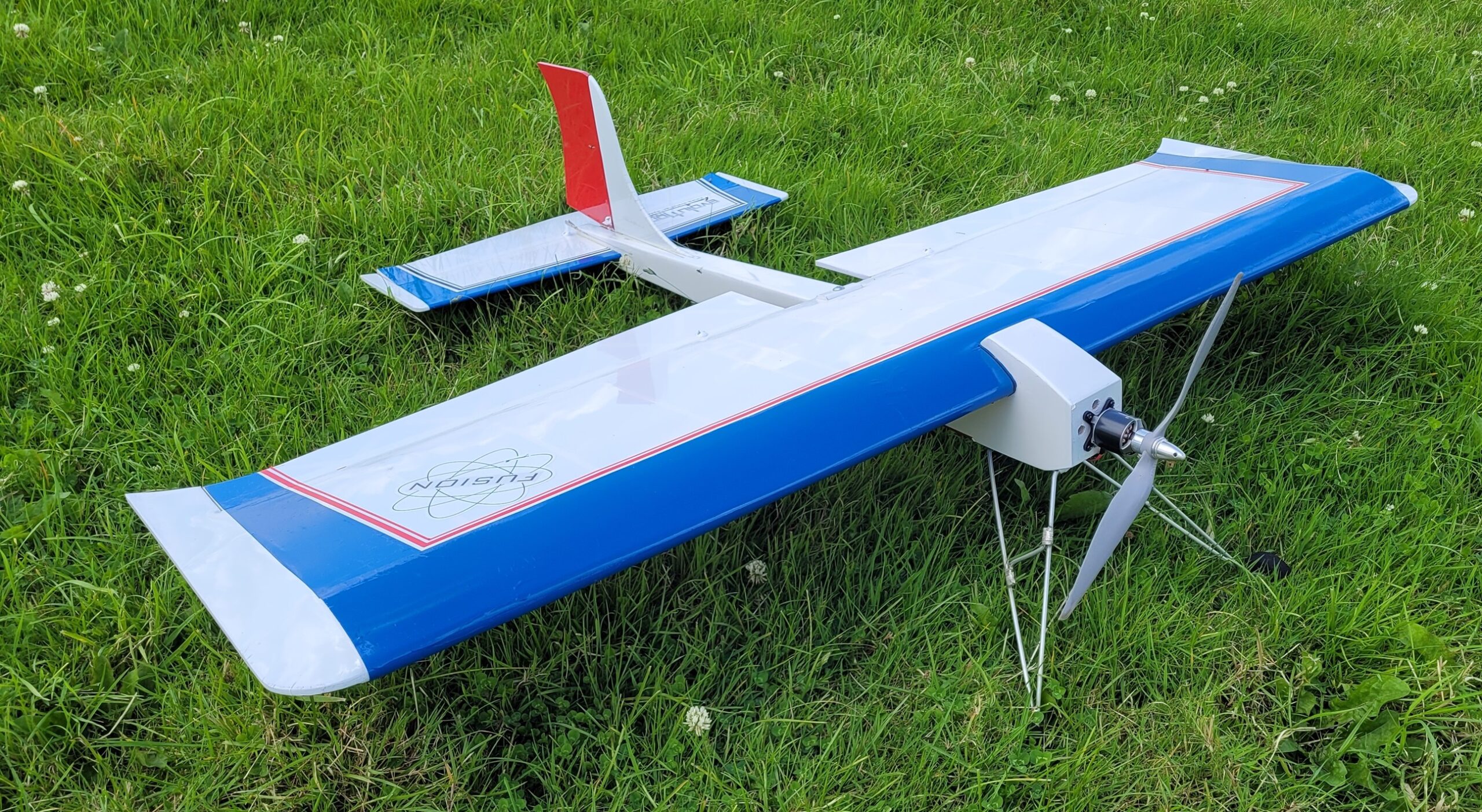

 Finally, balancing the model at the recommended starting position of 25 mm behind the main spar took a huge amount of lead, however, the designers say their display models balance at 50% of the chord, this would need far less lead, but was not something I wanted to risk. As I said at the beginning of this drivel, I have now flown the model, and I am happy to report, it’s great, it needed no trim and I am very happy with the CG.
Finally, balancing the model at the recommended starting position of 25 mm behind the main spar took a huge amount of lead, however, the designers say their display models balance at 50% of the chord, this would need far less lead, but was not something I wanted to risk. As I said at the beginning of this drivel, I have now flown the model, and I am happy to report, it’s great, it needed no trim and I am very happy with the CG.
Thanks for that very comprehensive report 1066, I can happily agree that the Fusion flies brilliantly and performs exactly as a FunFly model should. Apparently 1066 thinks the Fusion is ugly so he calls his Fugly. I’m assured this is short for Flipping Ugly…
Last year Dougal Entendre smashed the nose of his Max Thrust Aggressor electric glider. I won’t embarrass him by going into details, let’s just say it involved a fast low pass and a large bush. Dougal ordered a replacement fuselage but kept the damaged one although it seemed unlikely he would ever need a spare back half of a fuselage, after all, who manages to break the back half but not damage the nose? Well it turns out that Dougal does! He appeared to have a radio problem and the Aggressor crashed again. It must have hit the ground with one wingtip as the nose was undamaged but the rear fuselage broke in half.
 After a minor repair to the wingtip Dougal got out his saw and was able to graft the old fuselage rear end to the newer and undamaged nose. He’s made an excellent job of the repair and the Aggressor is flying beautifully again with no trim required.
After a minor repair to the wingtip Dougal got out his saw and was able to graft the old fuselage rear end to the newer and undamaged nose. He’s made an excellent job of the repair and the Aggressor is flying beautifully again with no trim required.
Staying on the subject of repairs, I think Dwayne Pipe might struggle to repair his Gnat.  The flight was going really well until Dwayne got disorientated after rolling out from a spell of inverted flight. Sadly I don’t think it’s going to buff out this time Dwayne!
The flight was going really well until Dwayne got disorientated after rolling out from a spell of inverted flight. Sadly I don’t think it’s going to buff out this time Dwayne!
Captain Slow has found a model that suits his flying style perfectly, a vintage Junior 60.
 It was built by the late Chris P Bacon (Nigel Baker) and Captain Slow bought it when Nigel’s models were sold off following his passing in April last year. Captain Slow did some minor repairs to the tail and fitted his own receiver but everything else is as it came.
It was built by the late Chris P Bacon (Nigel Baker) and Captain Slow bought it when Nigel’s models were sold off following his passing in April last year. Captain Slow did some minor repairs to the tail and fitted his own receiver but everything else is as it came.
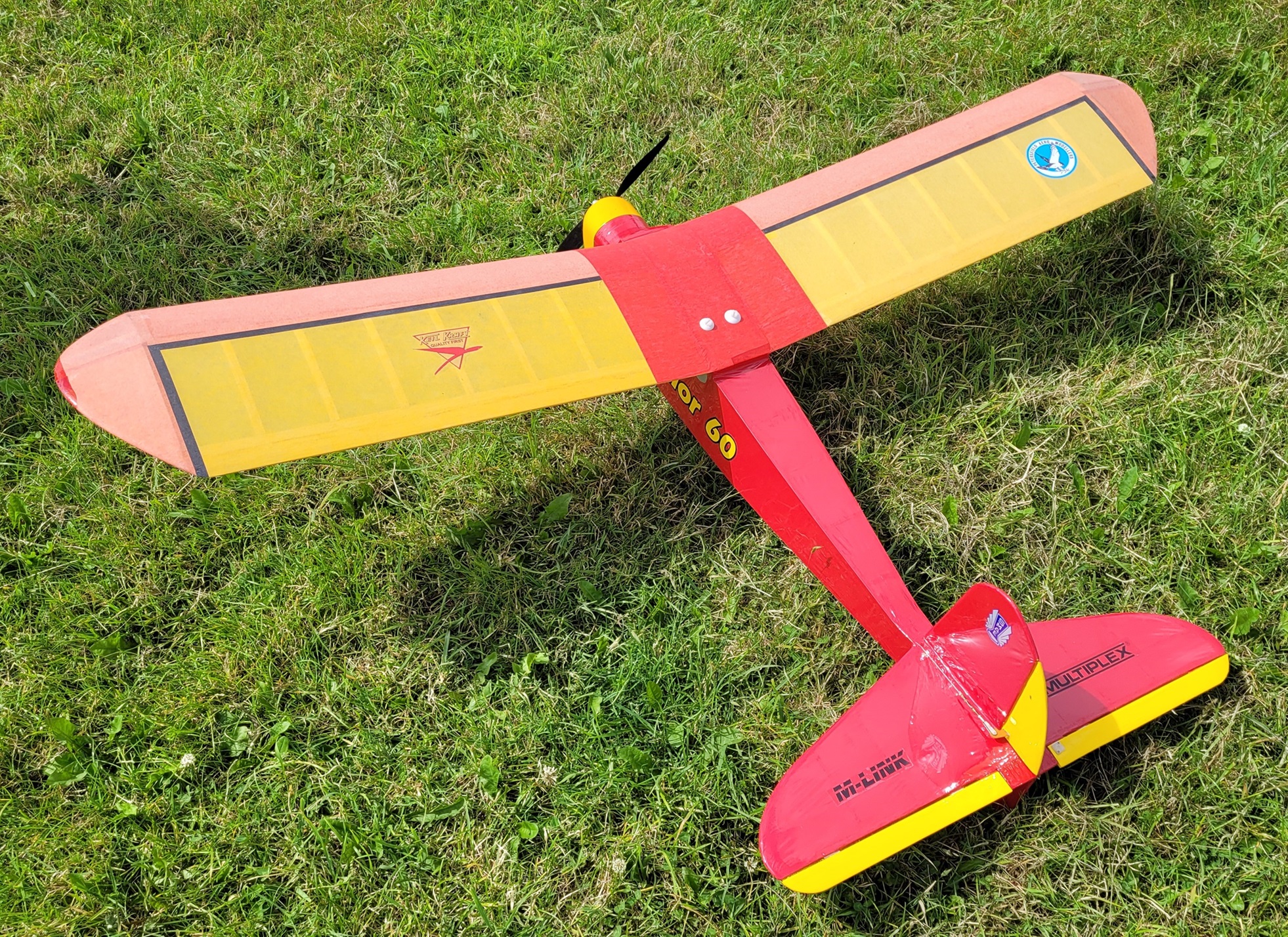
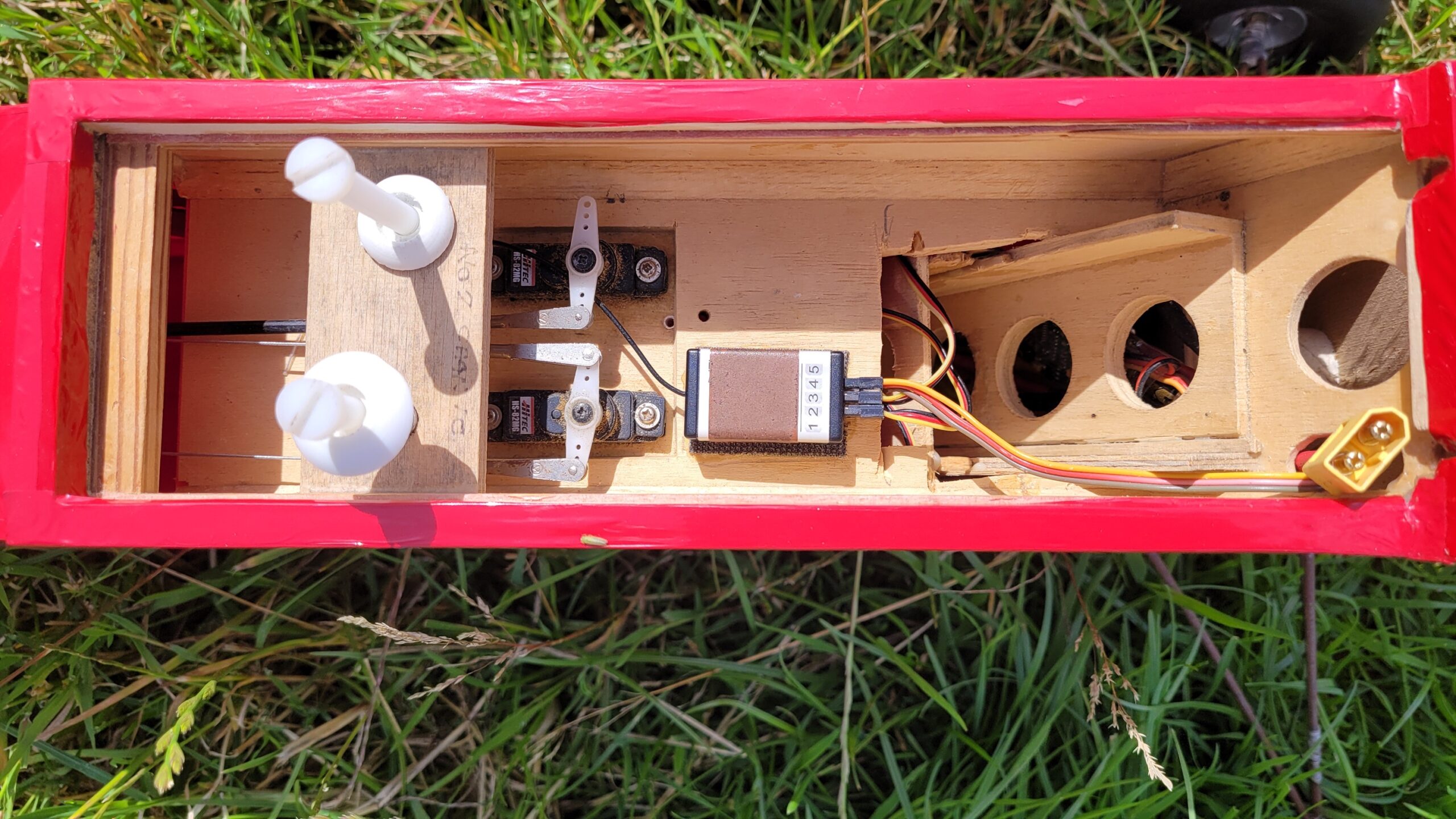 The Junior 60 has its origins back in 1946 when it was designed as a free-flight model by Albert Hatfull. This one was built from a Ben Buckle kit and is of course electric powered.
The Junior 60 has its origins back in 1946 when it was designed as a free-flight model by Albert Hatfull. This one was built from a Ben Buckle kit and is of course electric powered.
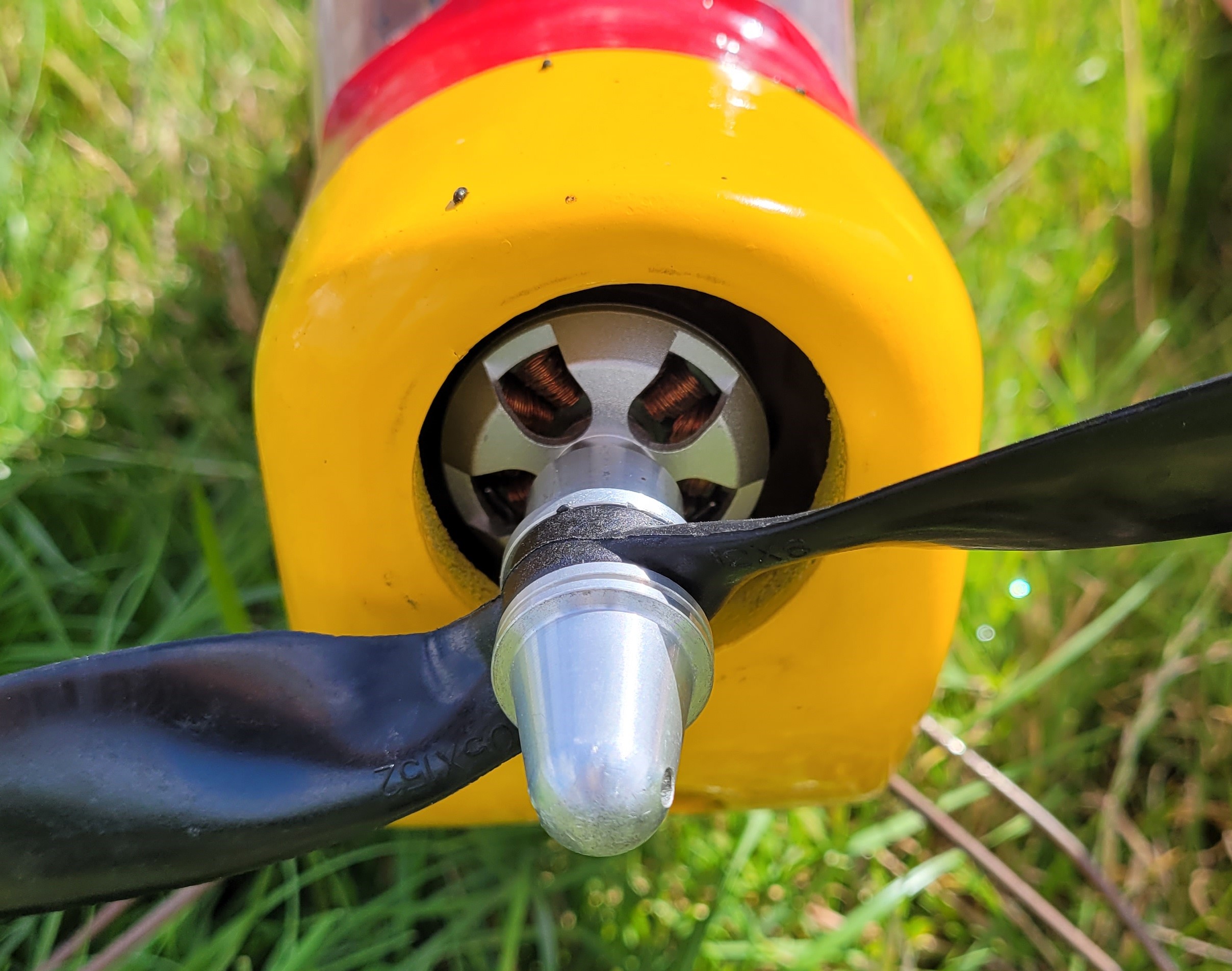 The model flew beautifully and slowly, which is exactly what Captain Slow wanted, and the only problem he had was getting it down, the Junior just wanted to float along forever!
The model flew beautifully and slowly, which is exactly what Captain Slow wanted, and the only problem he had was getting it down, the Junior just wanted to float along forever!
Having recently sold me his XFly T-7A Red Hawk because it was a bit too much of a handful for him Woody has replaced it with an XFly F-22 Raptor. Hmm…

 We advised against buying the Raptor but Woody reckoned it should be easier to fly than the Red Hawk because it has a larger wing area and a lower wing loading but the XFly specs say the Raptor has a smaller wing area and a higher wing loading. Another hmm…
We advised against buying the Raptor but Woody reckoned it should be easier to fly than the Red Hawk because it has a larger wing area and a lower wing loading but the XFly specs say the Raptor has a smaller wing area and a higher wing loading. Another hmm…
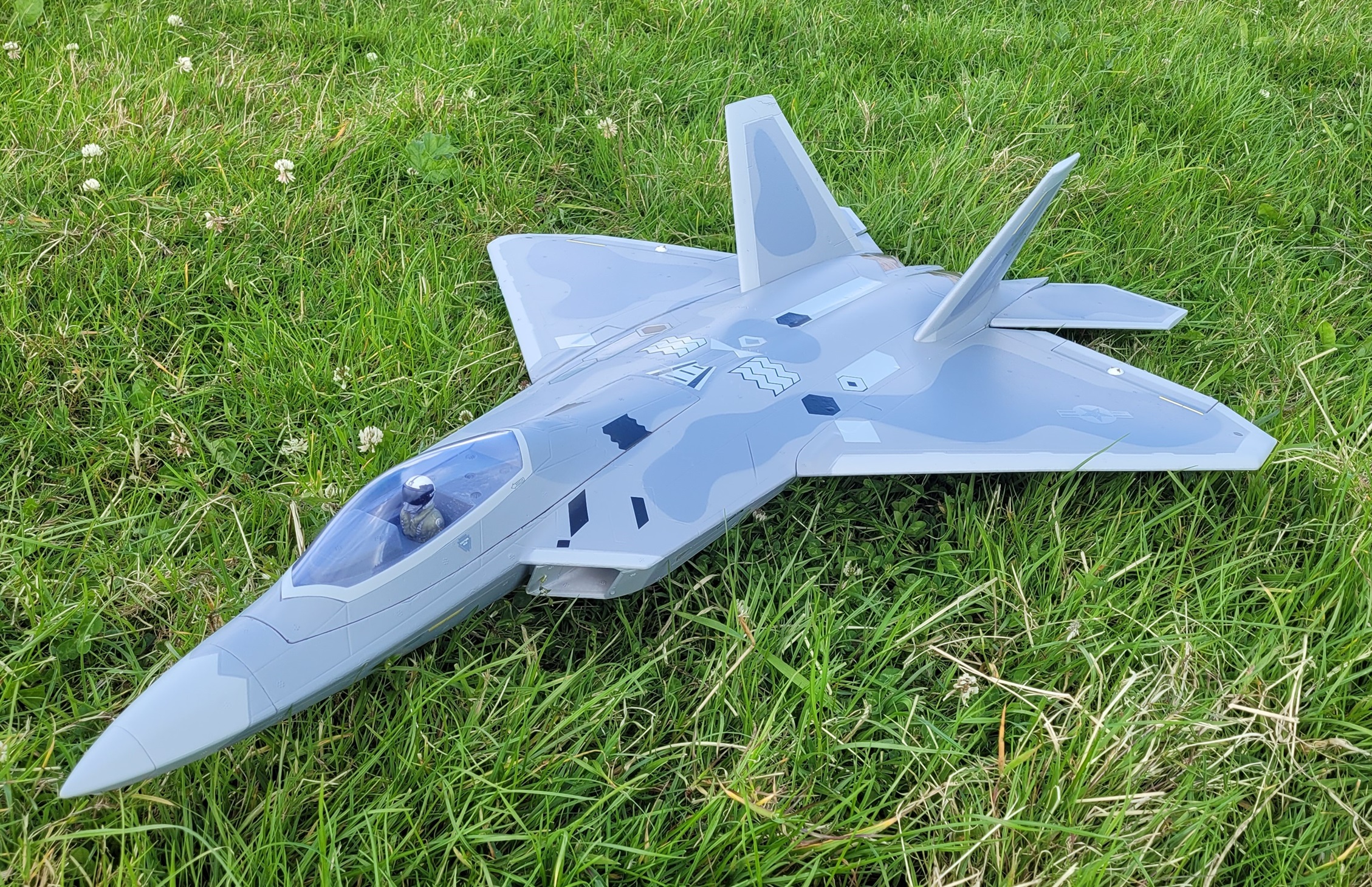 The Raptor has a wingspan of 702mm and weighs around 950g with a 4 cell lipo. It’s powered by two 12 bladed 40mm fans each of which is run by a 1413 5000KV motor and has its own 20A speed controller. The gyro wasn’t operating in the correct direction so rather than mess around with the settings at the field the first three flights were done with the gyro switched off and they were all rather ‘interesting’ going away from a hand launch.
The Raptor has a wingspan of 702mm and weighs around 950g with a 4 cell lipo. It’s powered by two 12 bladed 40mm fans each of which is run by a 1413 5000KV motor and has its own 20A speed controller. The gyro wasn’t operating in the correct direction so rather than mess around with the settings at the field the first three flights were done with the gyro switched off and they were all rather ‘interesting’ going away from a hand launch.
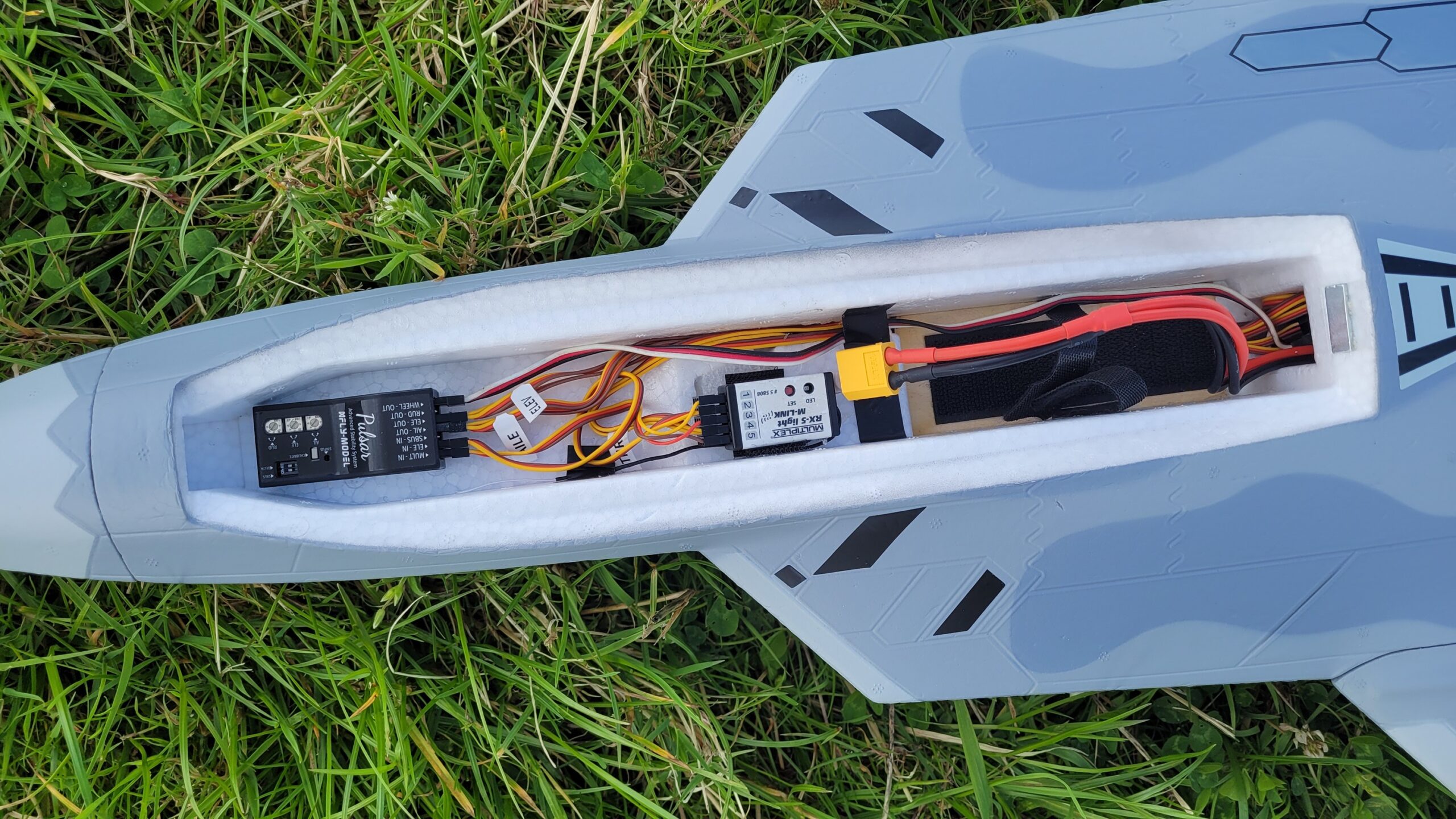 Once airborne the Raptor flew well, it just seems to need a fair heave to get it flying. Woody had sorted the gyro setting out by the next session and it was launched with the gyro set in the damping mode and it’s gone away from every launch with no further problems. I’m not sure that’s because the gyro is doing its stuff or the launchers have got better at throwing it. You can see the first launch in this month’s video and you’ll see that it was tricky but that the Raptor flies very nicely once it’s got a bit of speed.
Once airborne the Raptor flew well, it just seems to need a fair heave to get it flying. Woody had sorted the gyro setting out by the next session and it was launched with the gyro set in the damping mode and it’s gone away from every launch with no further problems. I’m not sure that’s because the gyro is doing its stuff or the launchers have got better at throwing it. You can see the first launch in this month’s video and you’ll see that it was tricky but that the Raptor flies very nicely once it’s got a bit of speed.
As I mentioned earlier the annual Chuck Glider competition was held in July, ably run by Dwayne Pipe. Here’s Dwayne’s report: The annual chuck glider competition was held this month. Instead of our new flying field, we held it on the playing fields at Buriton as we didn’t want any chuck gliders to get carried away in the wind and end up in East Meon. 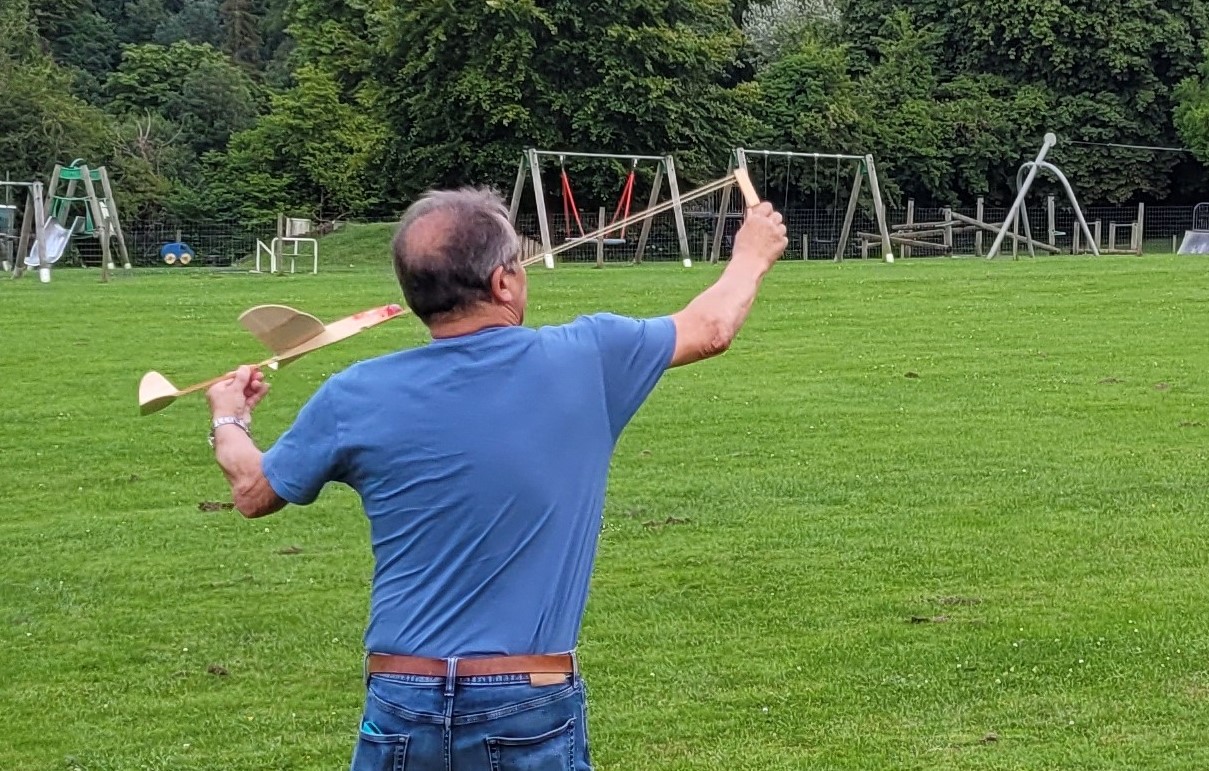
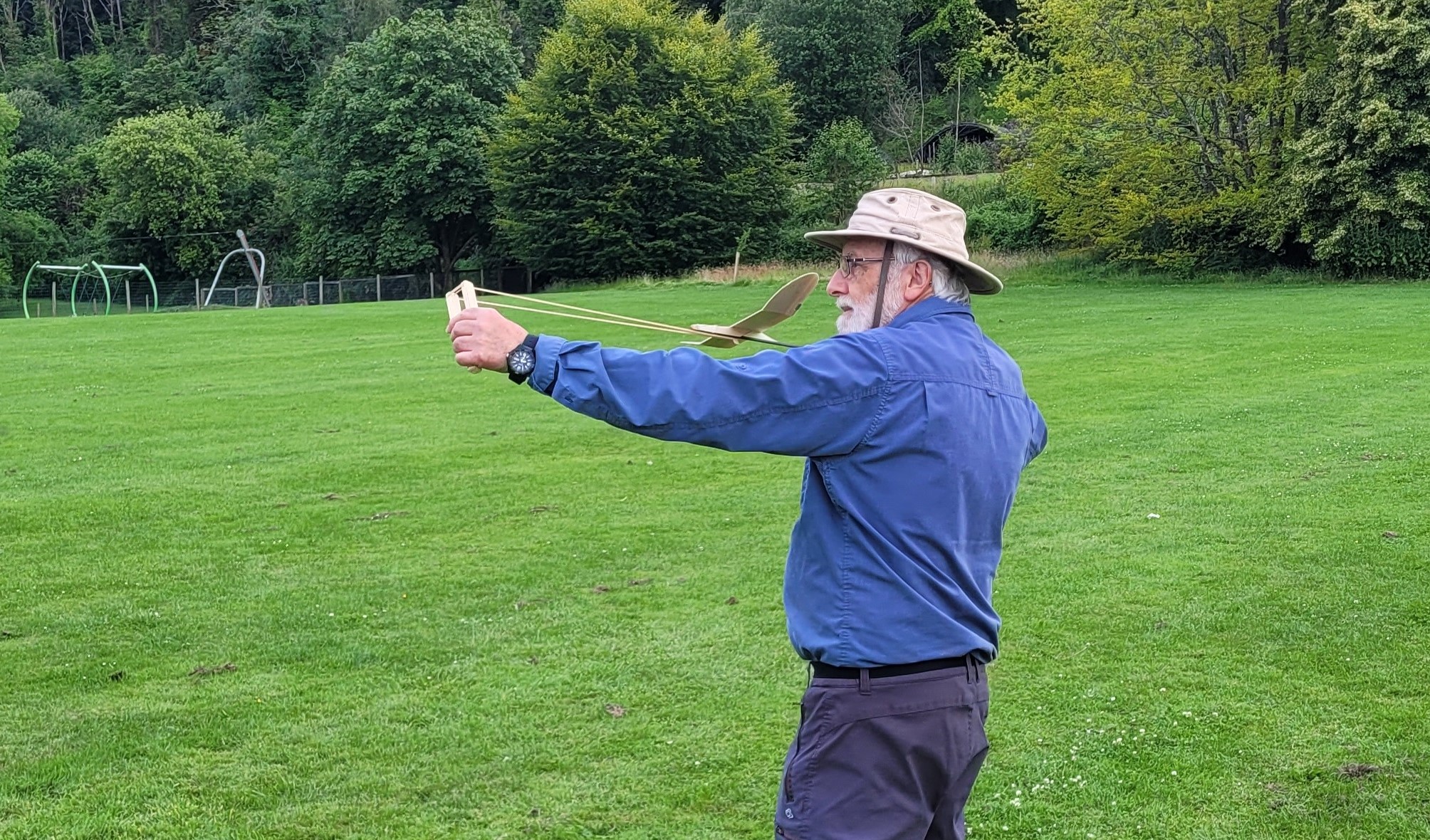
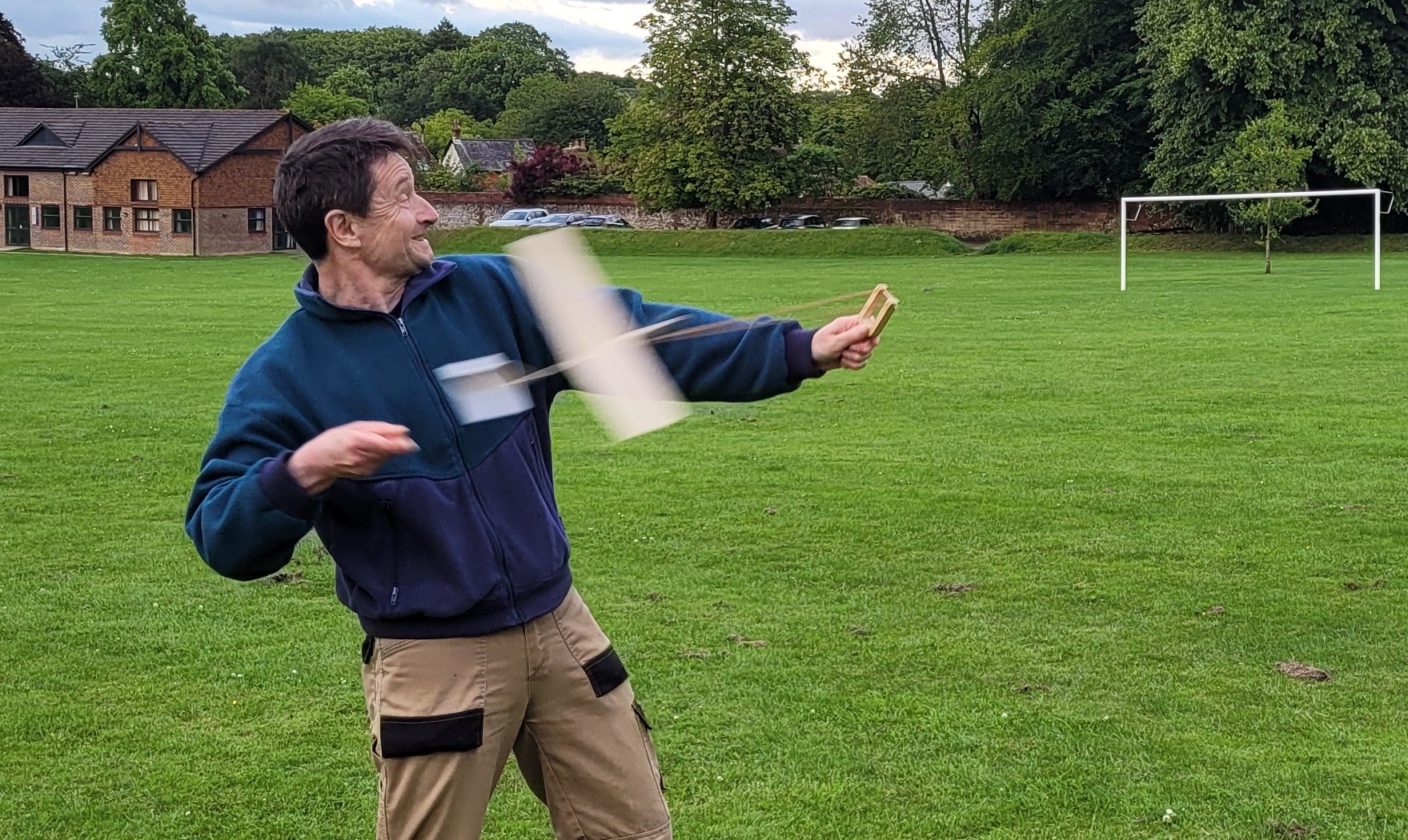 In the event, the conditions were perfect, and we had nine people turn up and eight take part in the competitions. In the standard Chuck Glider category, it will come as no surprise to learn that Colin Cowplain won with a significant lead over everybody else.
In the event, the conditions were perfect, and we had nine people turn up and eight take part in the competitions. In the standard Chuck Glider category, it will come as no surprise to learn that Colin Cowplain won with a significant lead over everybody else. 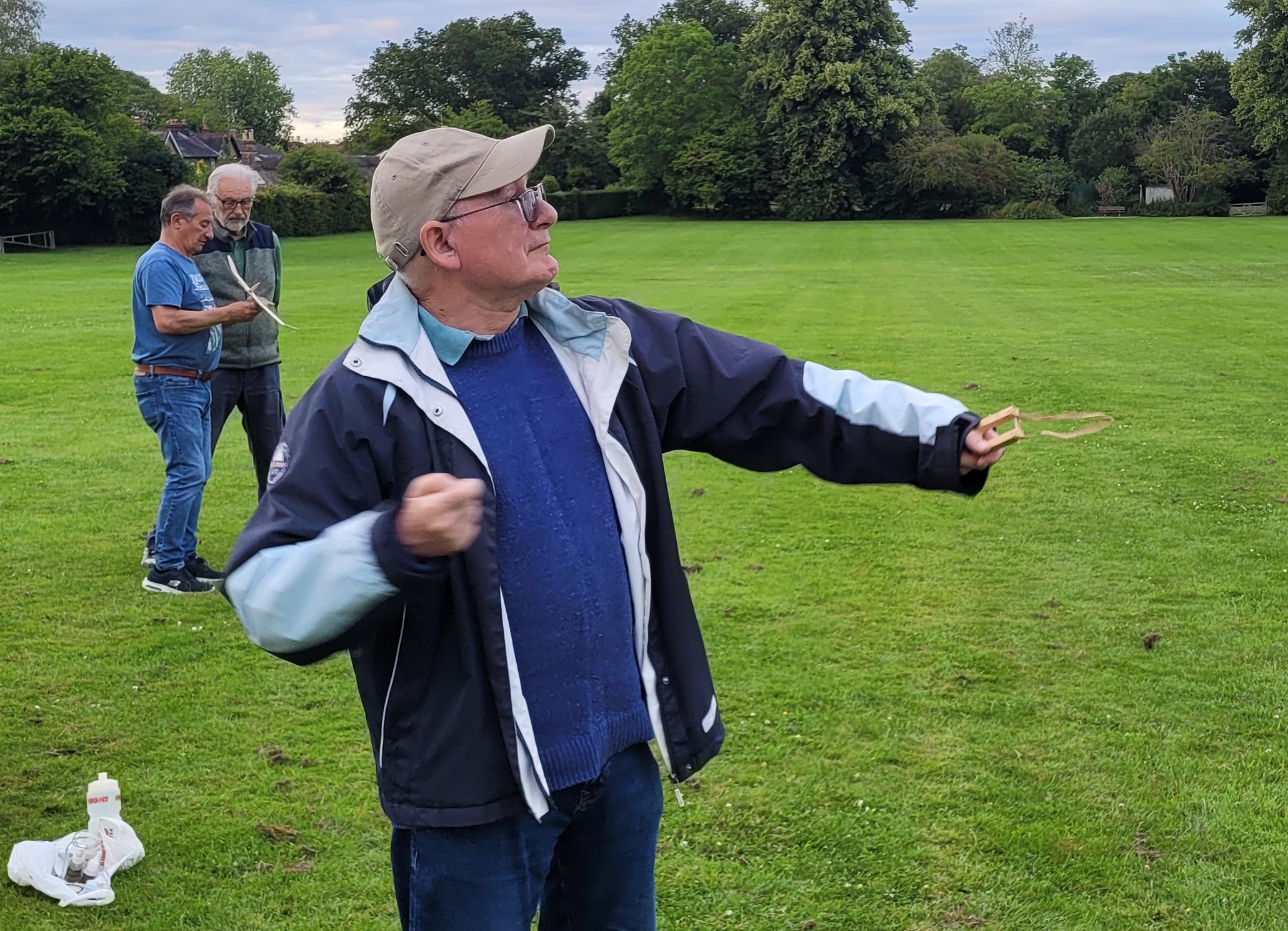
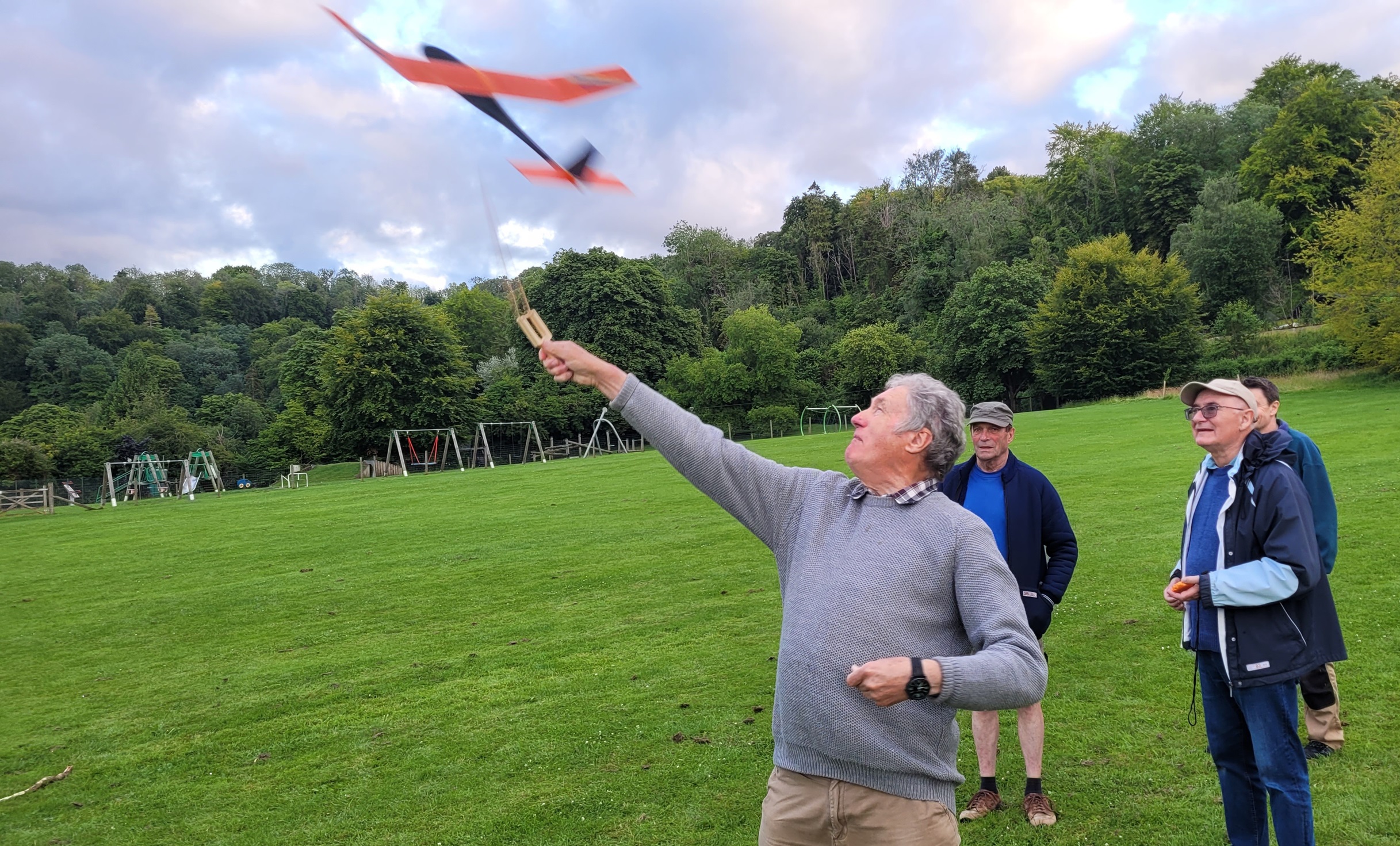
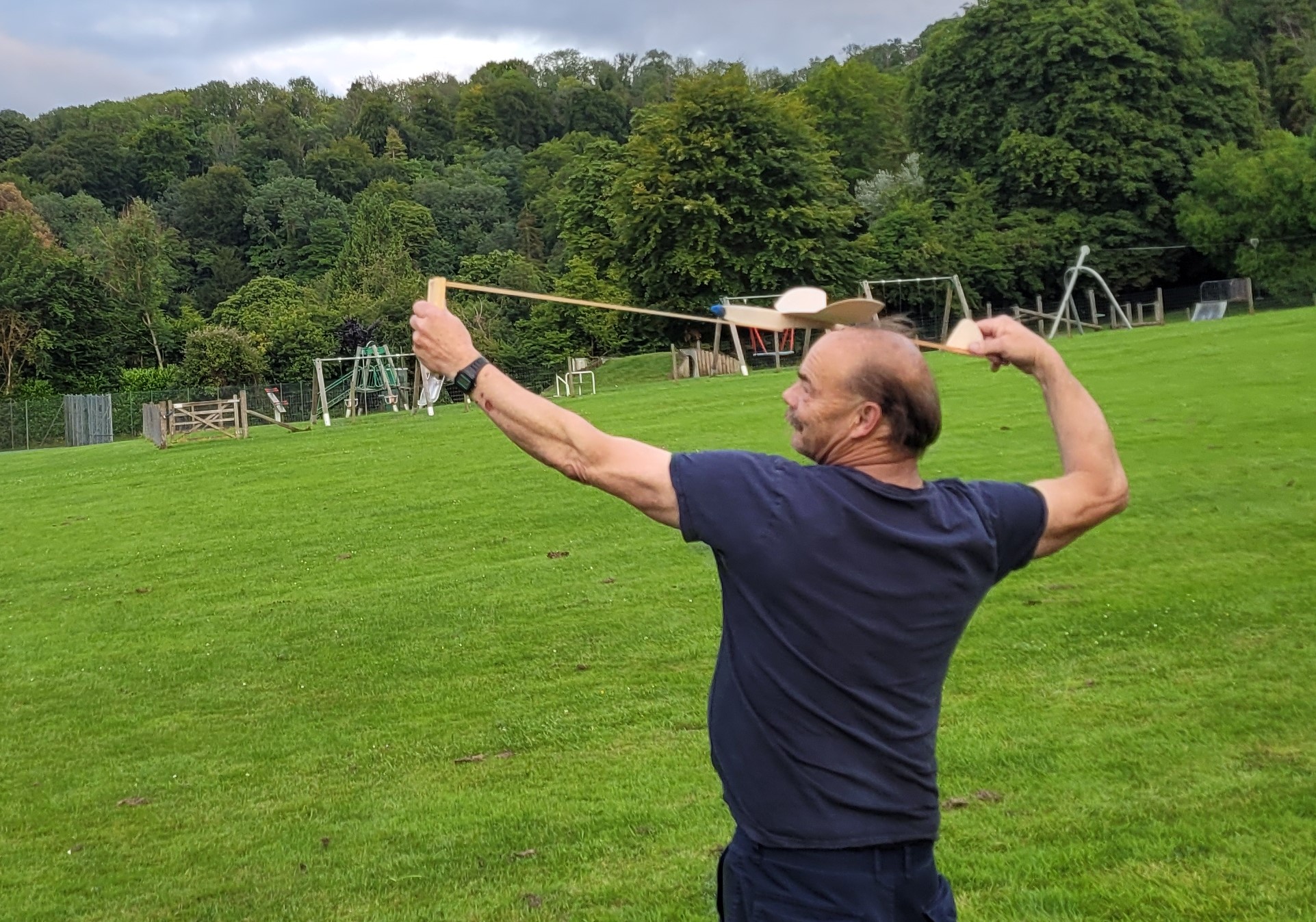 However, he may be losing his touch as his overall time of 56.1 seconds this year was considerably less than the 82.1 second, he won in last year. Second place was Dougal Entendre and MacFly came third. We also had the Catapult Glider competition as well and the results were completely different with Woody coming first and Tony Neil second.
However, he may be losing his touch as his overall time of 56.1 seconds this year was considerably less than the 82.1 second, he won in last year. Second place was Dougal Entendre and MacFly came third. We also had the Catapult Glider competition as well and the results were completely different with Woody coming first and Tony Neil second. 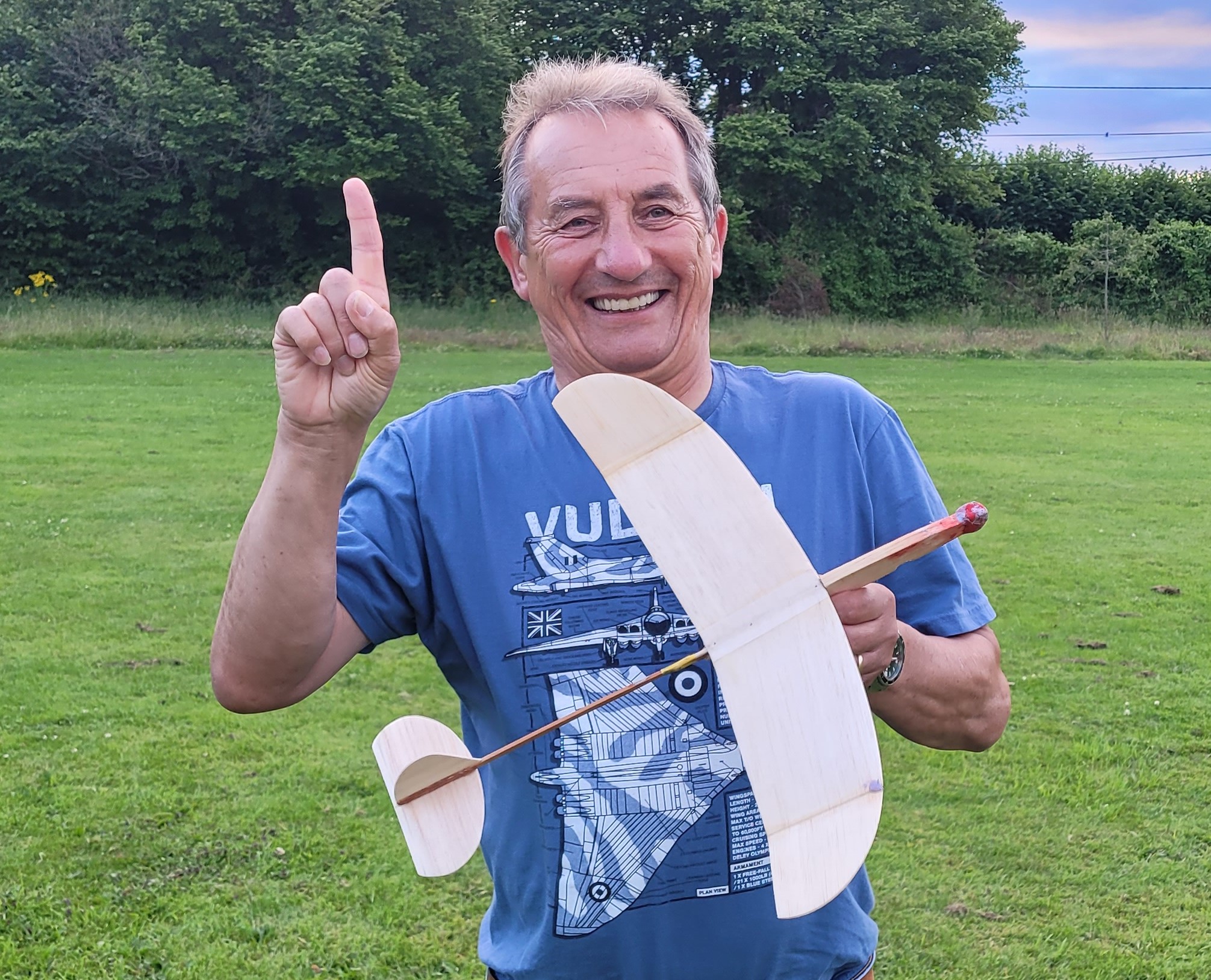 Everyone seemed to have a good time. I would recommend for next year that you get lots of practise in trimming your aircraft before you turn up on the night.
Everyone seemed to have a good time. I would recommend for next year that you get lots of practise in trimming your aircraft before you turn up on the night.
Thanks Dwayne, it was, as always, a good evening of fun and we all enjoyed it.
In the May Patch News I featured Gordon Bennett’s Fosdyke Flyer, a model that he bought when the club was auctioning off John Bourne’s models and equipment.
 John is an extremely capable modeller who was a PAM member for many years but old age has caught up with him and his modelling days are sadly over. In May Gordon told us all about the work he’d done preparing the model for flight but he hadn’t flown it at the time.
John is an extremely capable modeller who was a PAM member for many years but old age has caught up with him and his modelling days are sadly over. In May Gordon told us all about the work he’d done preparing the model for flight but he hadn’t flown it at the time.
 However, on a nice calm day in July the Fosdyke lived up to its name and flew. And it flew very nicely too, just needing the thrust line adjusting as it climbed steeply at full throttle.
However, on a nice calm day in July the Fosdyke lived up to its name and flew. And it flew very nicely too, just needing the thrust line adjusting as it climbed steeply at full throttle. 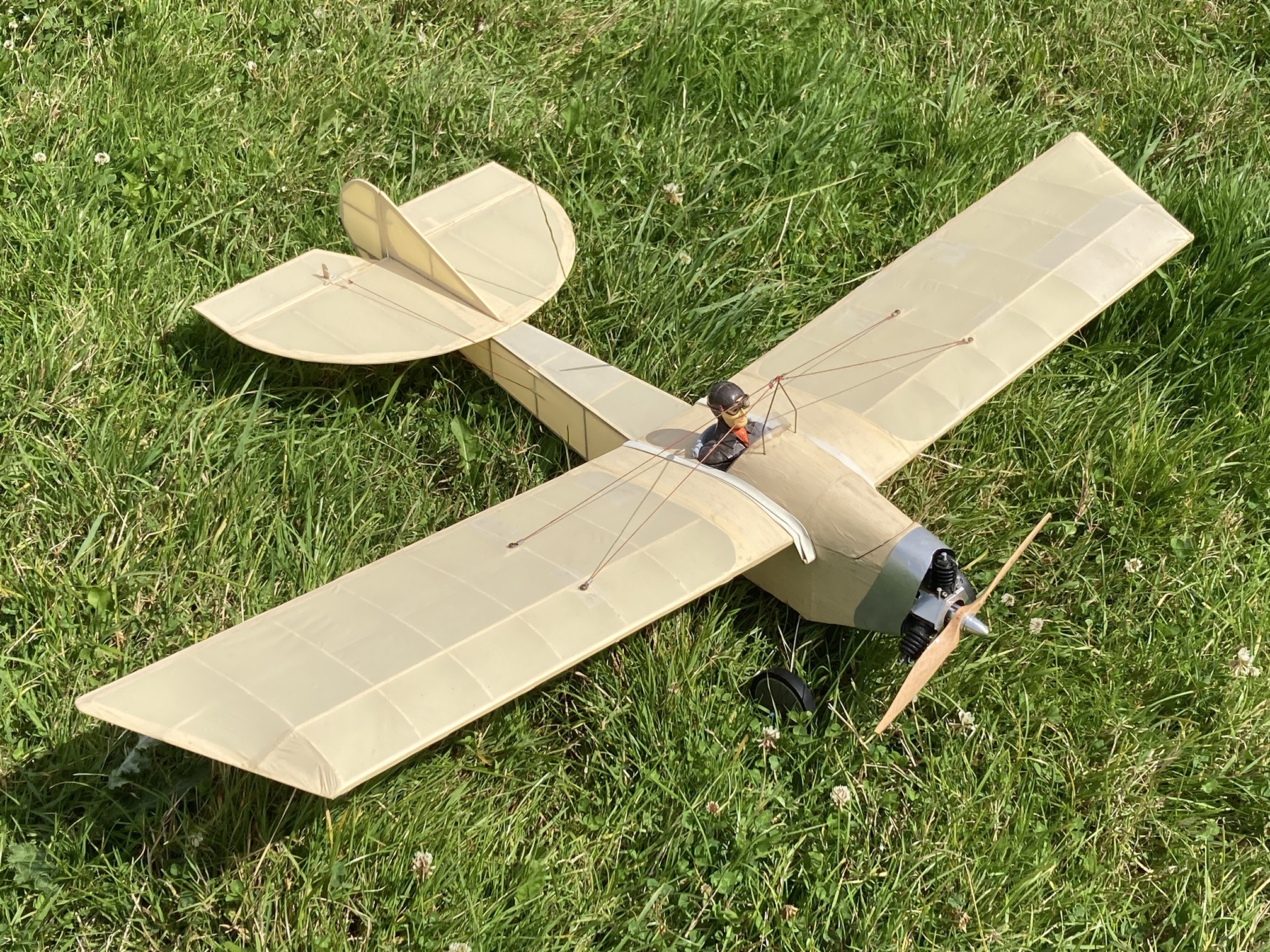 Gordon has since added some downthrust and flown it again and, as you’ll see in the video, it performed beautifully. We need to see it flying circuits with Captain Slow’s Junior 60.
Gordon has since added some downthrust and flown it again and, as you’ll see in the video, it performed beautifully. We need to see it flying circuits with Captain Slow’s Junior 60.
The last new model to feature this month is Mini-Mike’s lovely Arrows Hobby Avanti.

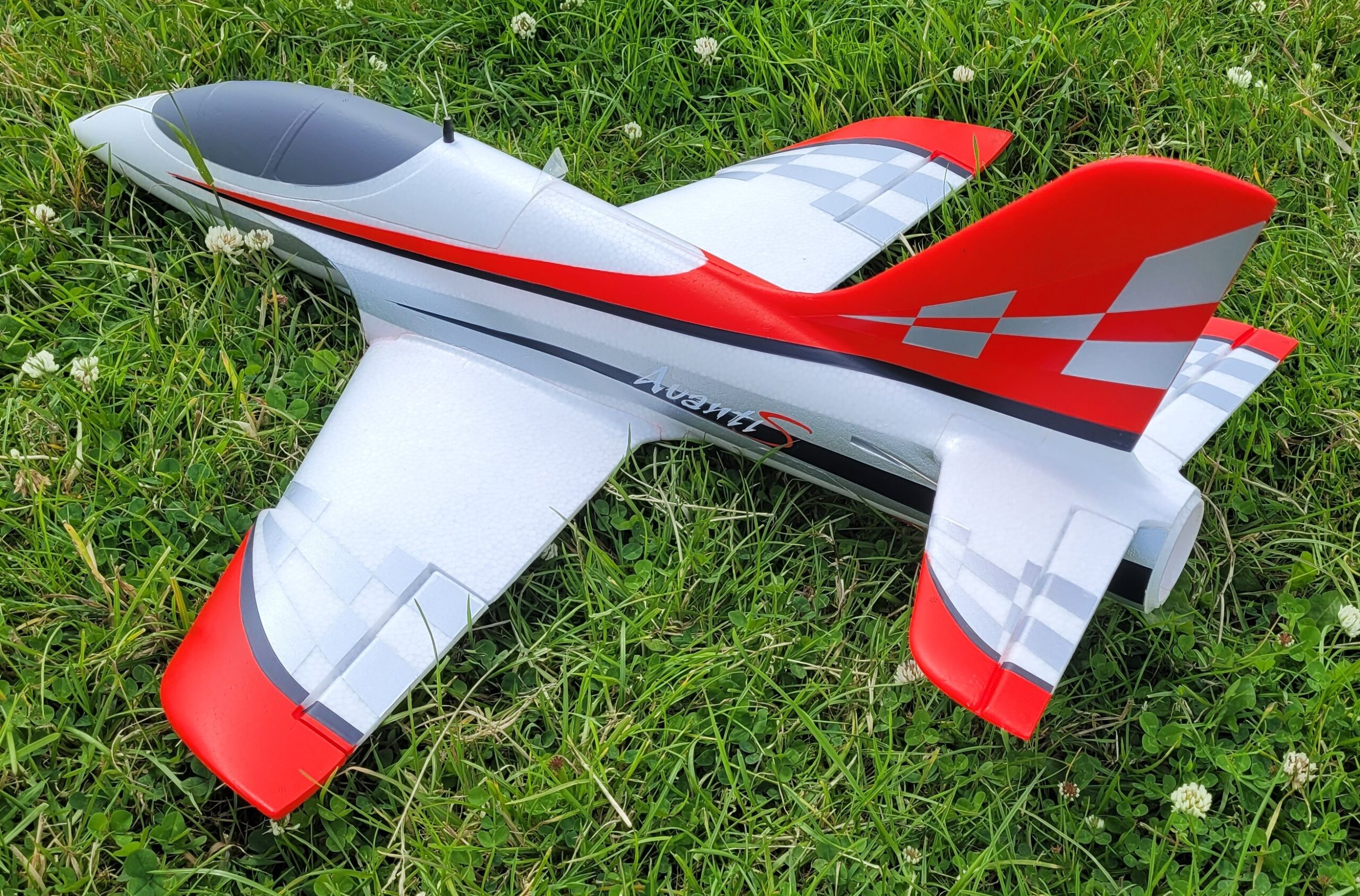 I have a suspicion that he likes the Arrows edf range and to date he has the Marlin, Hawk, Viper, Albatross, and now the Avanti. It’s another in the 50mm fan range and is very similar to the others, especially the Viper. I’ve always liked the look of the Avanti, it’s one of those designs that just looks right somehow. The Avanti comes with a pre-installed 2627 4500KV brushless motor spinning at 11 bladed 50mm fan. That is exactly the same motor and fan combination as the others but oddly the recommended battery is a 3 cell 1300-1600mAh rather than a 2200mAh that all the others use. Mike uses a 2200mAh anyway but it needs to be positioned a fair way back to get the correct centre of gravity.
I have a suspicion that he likes the Arrows edf range and to date he has the Marlin, Hawk, Viper, Albatross, and now the Avanti. It’s another in the 50mm fan range and is very similar to the others, especially the Viper. I’ve always liked the look of the Avanti, it’s one of those designs that just looks right somehow. The Avanti comes with a pre-installed 2627 4500KV brushless motor spinning at 11 bladed 50mm fan. That is exactly the same motor and fan combination as the others but oddly the recommended battery is a 3 cell 1300-1600mAh rather than a 2200mAh that all the others use. Mike uses a 2200mAh anyway but it needs to be positioned a fair way back to get the correct centre of gravity.
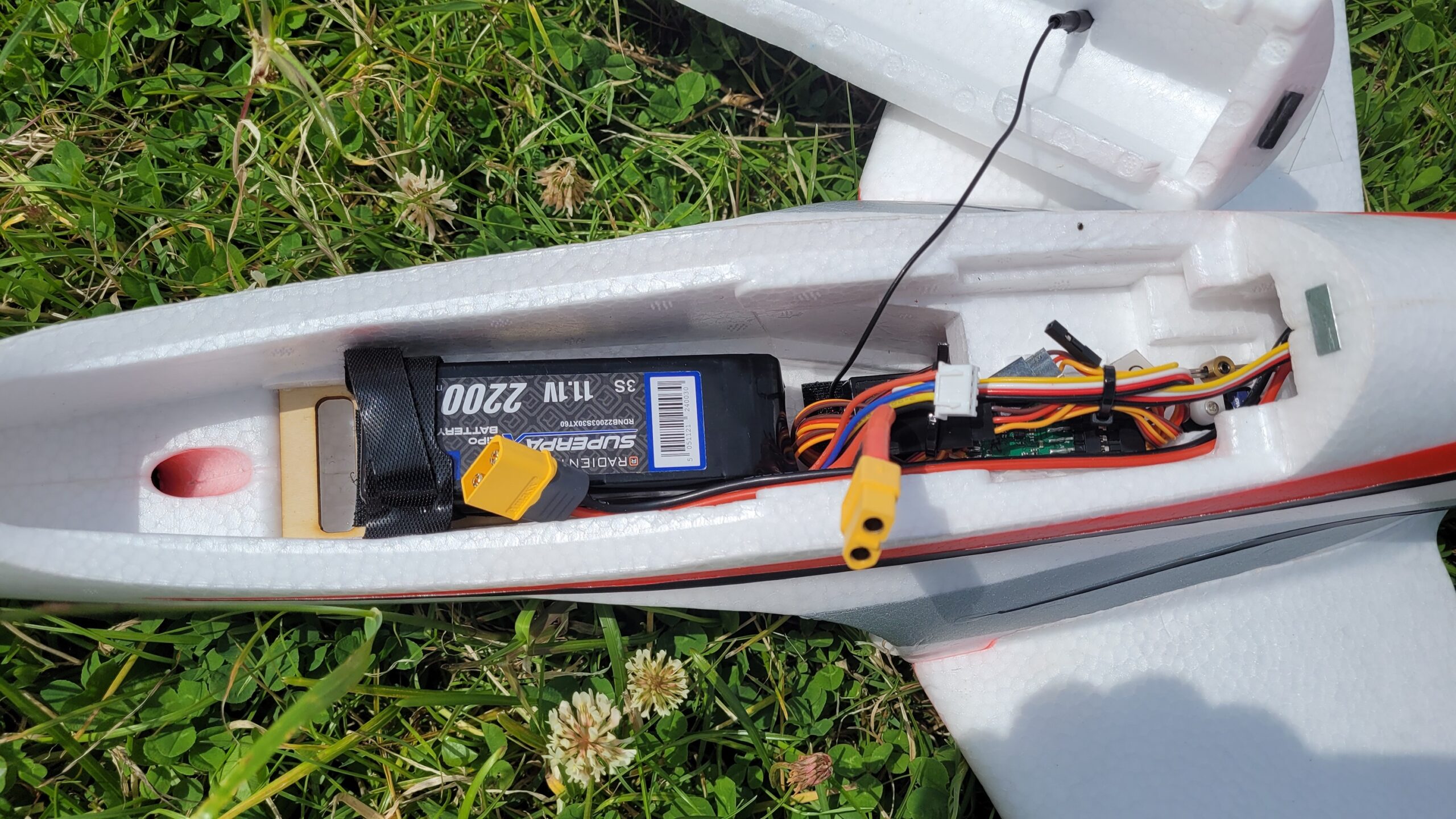 The Avanti comes with a Vector 6-axis gyro and three 9g servos and it all simply screws together with the quoted assembly time being just thirty minutes. Mini-Mike reckons it’s really nice to fly, very smooth, and of course you can see it in this months’ video.
The Avanti comes with a Vector 6-axis gyro and three 9g servos and it all simply screws together with the quoted assembly time being just thirty minutes. Mini-Mike reckons it’s really nice to fly, very smooth, and of course you can see it in this months’ video.
Dougal brought out his large Spad to fly when the weather improved at the end of the July.
 I’ve featured it before so won’t bore you with too many details but it’s an ARTF Spad XIII made by Maxford USA, is 68” wingspan and weighs around 13lbs with 2 x 4 cell lipo packs.MacFly shot some lovely film of the flight and I think it’s worthy of its own video.
I’ve featured it before so won’t bore you with too many details but it’s an ARTF Spad XIII made by Maxford USA, is 68” wingspan and weighs around 13lbs with 2 x 4 cell lipo packs.MacFly shot some lovely film of the flight and I think it’s worthy of its own video.
Unfortunately Kryten was busy this month and was unable to take any action shots for us. So I’ve taken some screenshots from the video which are of lower quality but hopefully ok.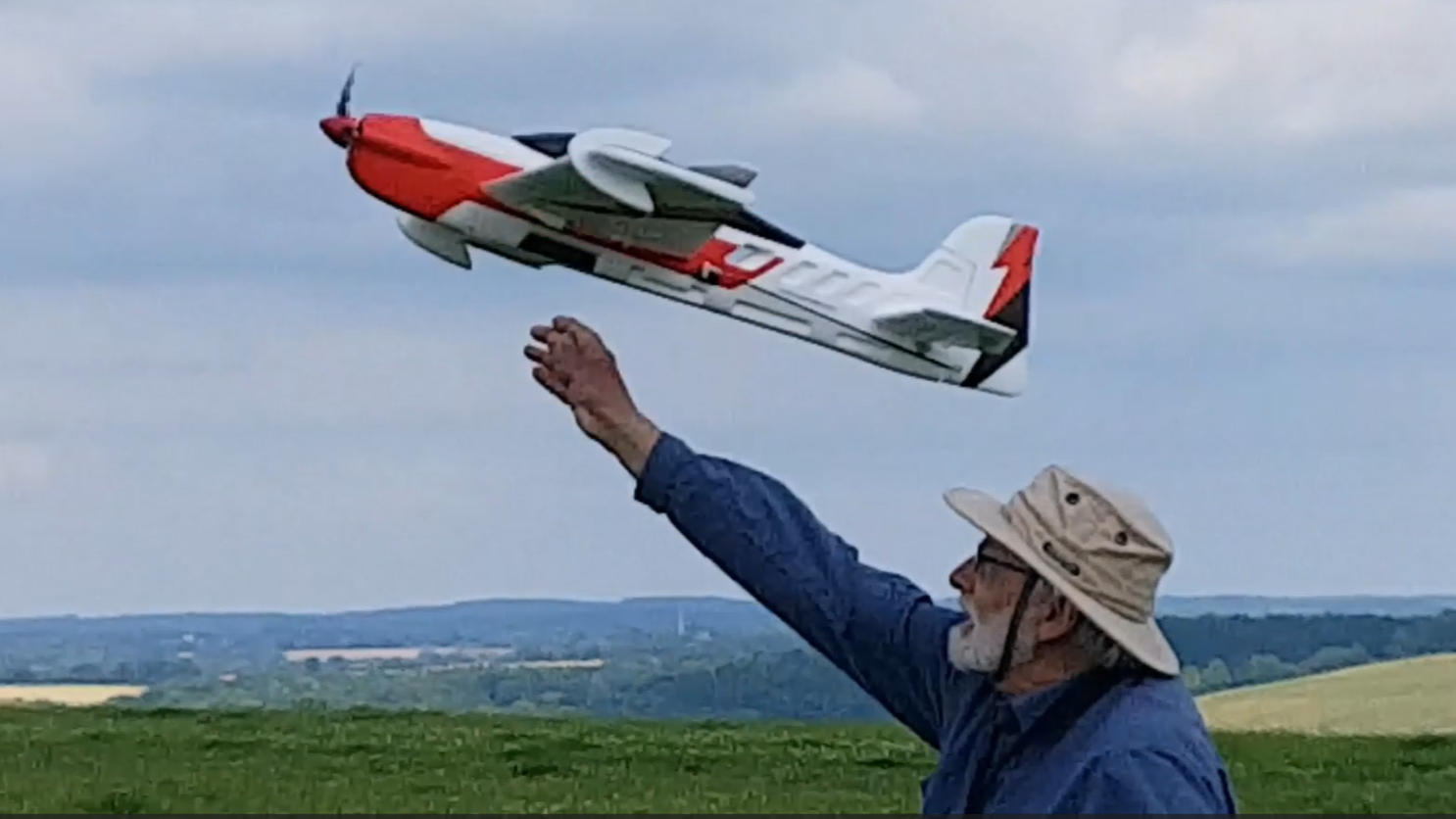
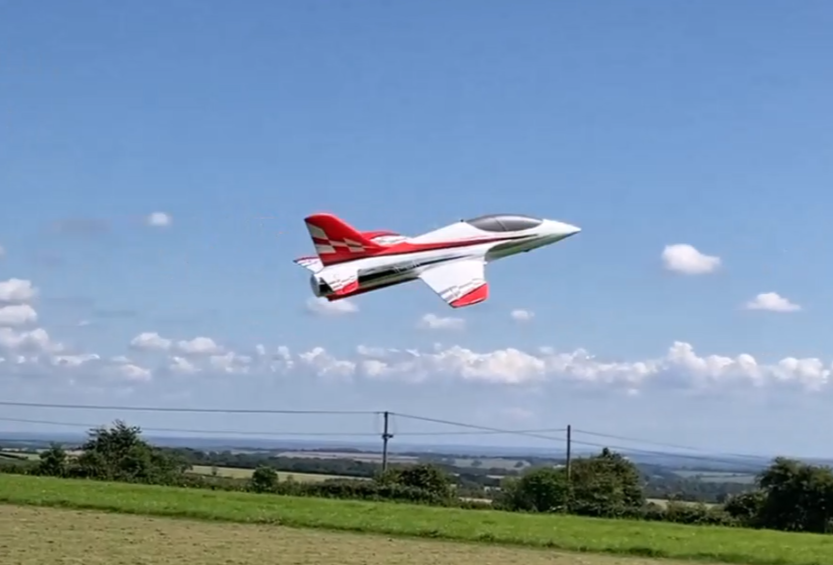
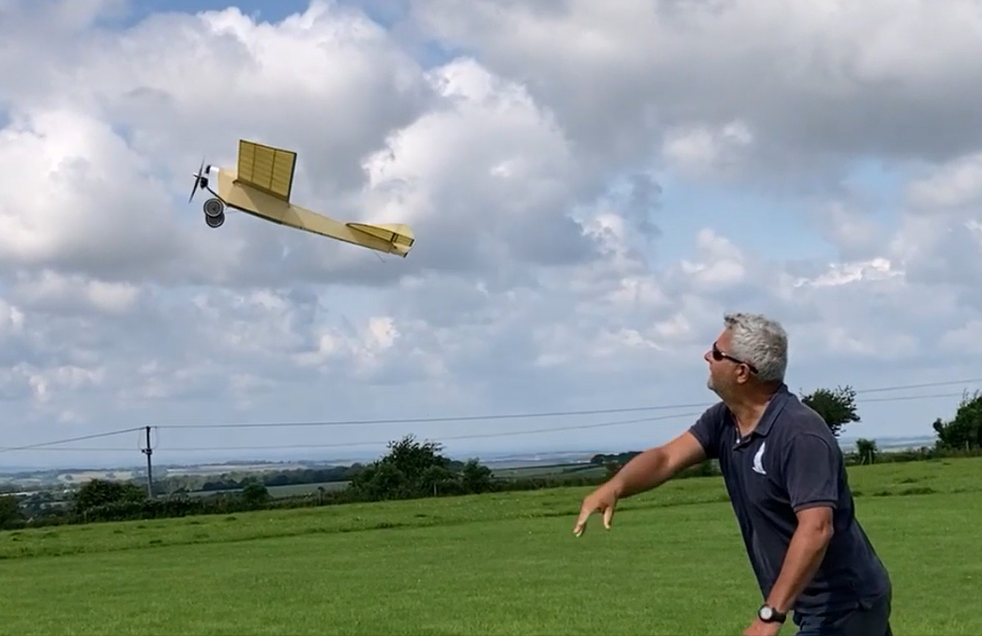


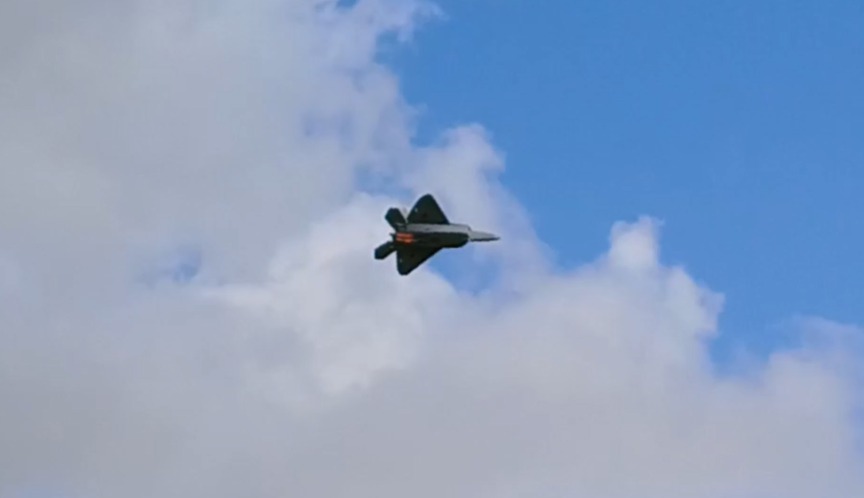
Video time now this month with footage taken by myself, Dougal, and MacFly. Please watch the video full-screen, it’s so much better with small models flying around:
If the video won’t play for you please click HERE
A friend told me he wanted to start making scale models.
I said “be realistic…”
Colin Cowplain


